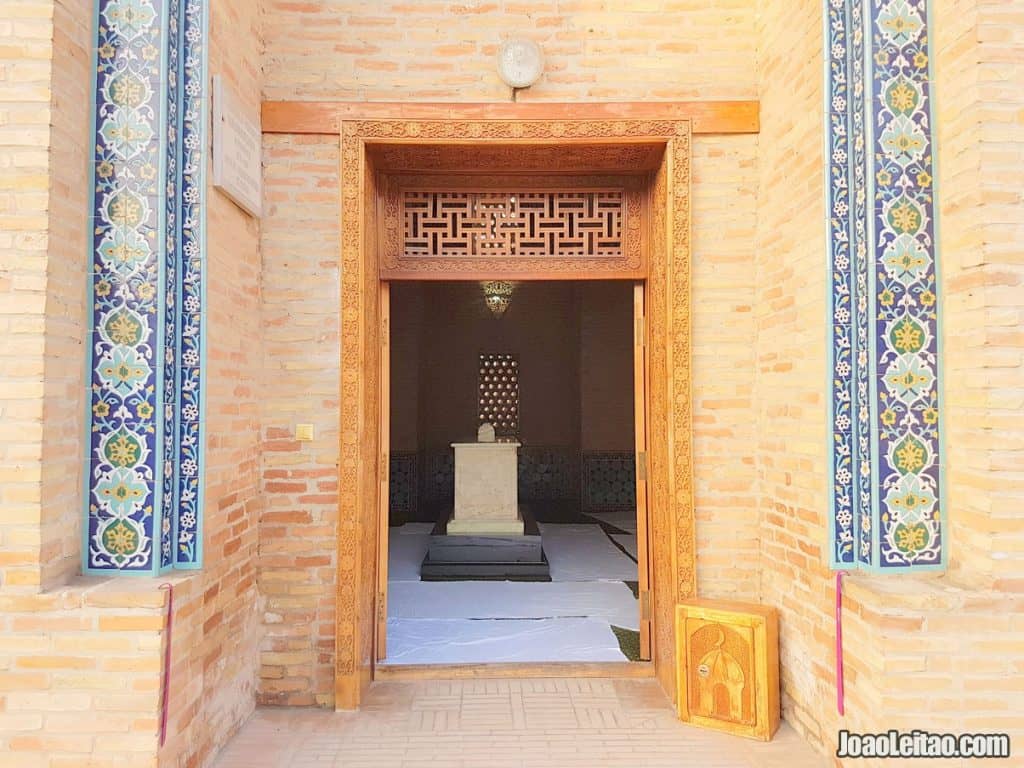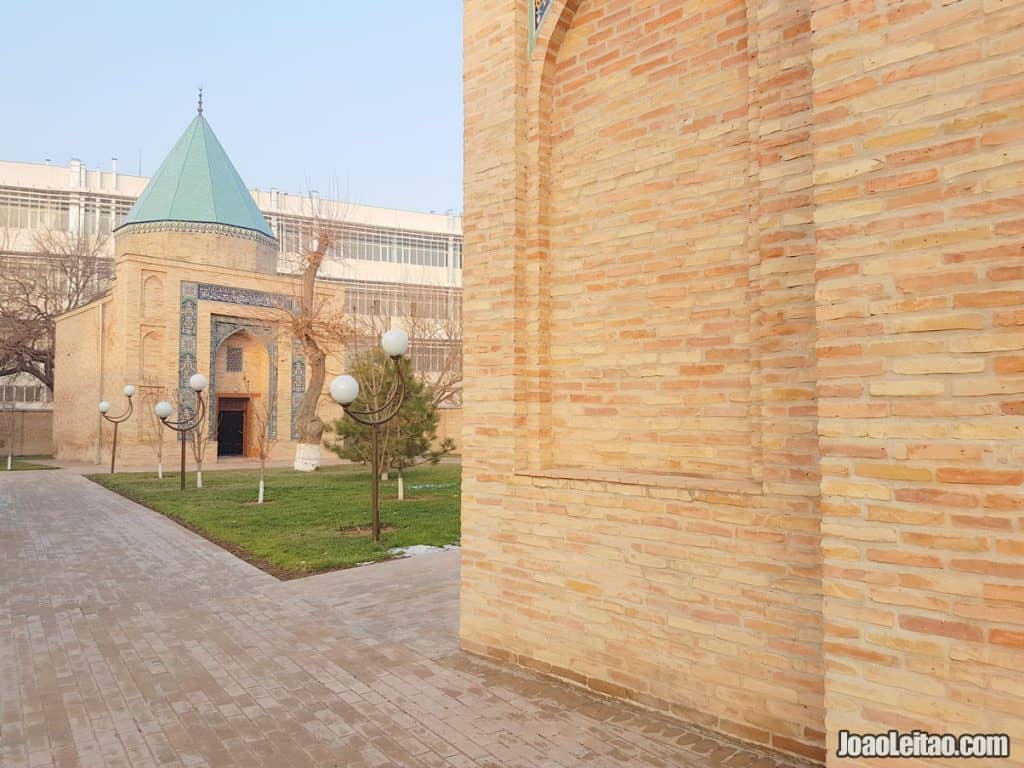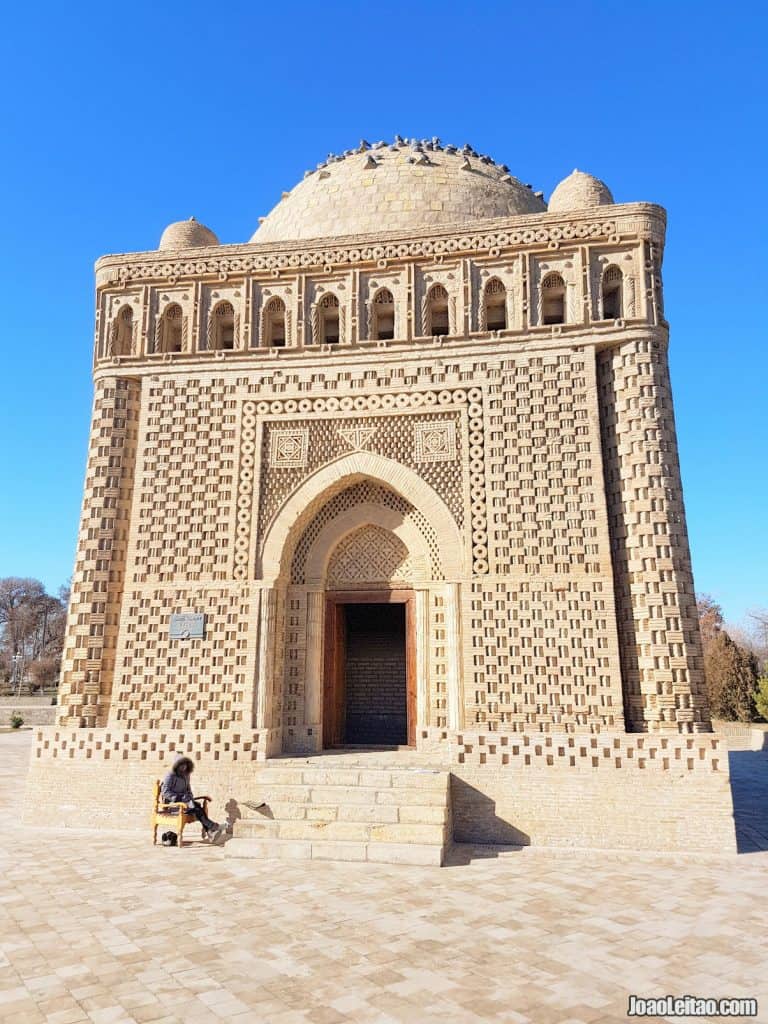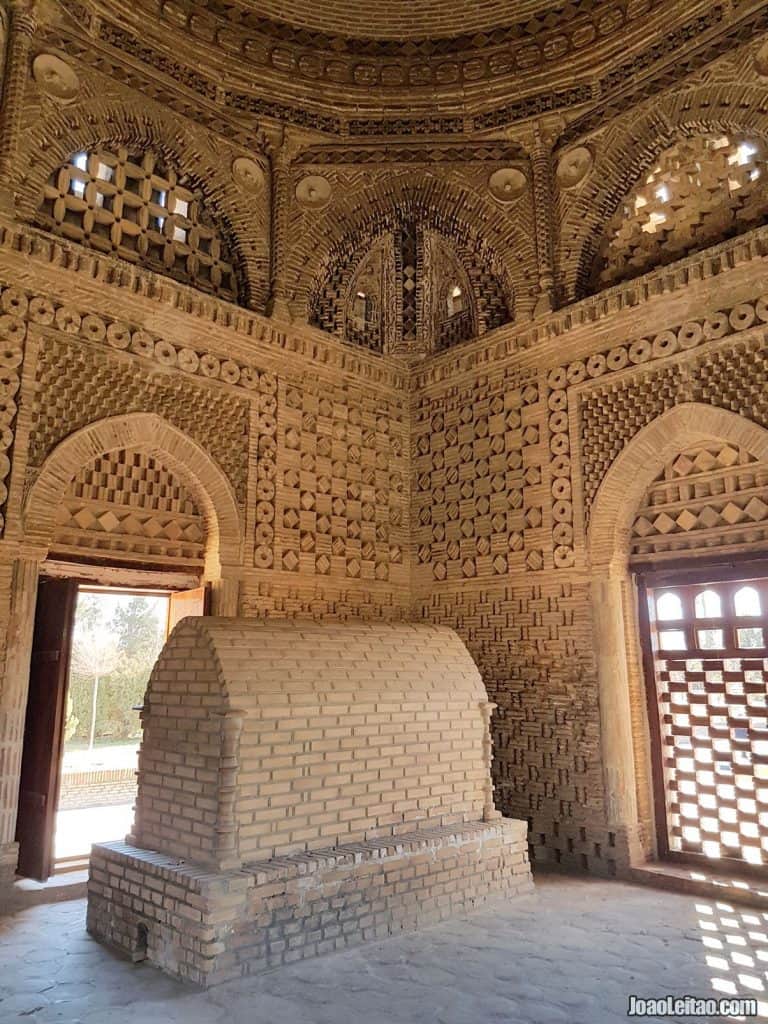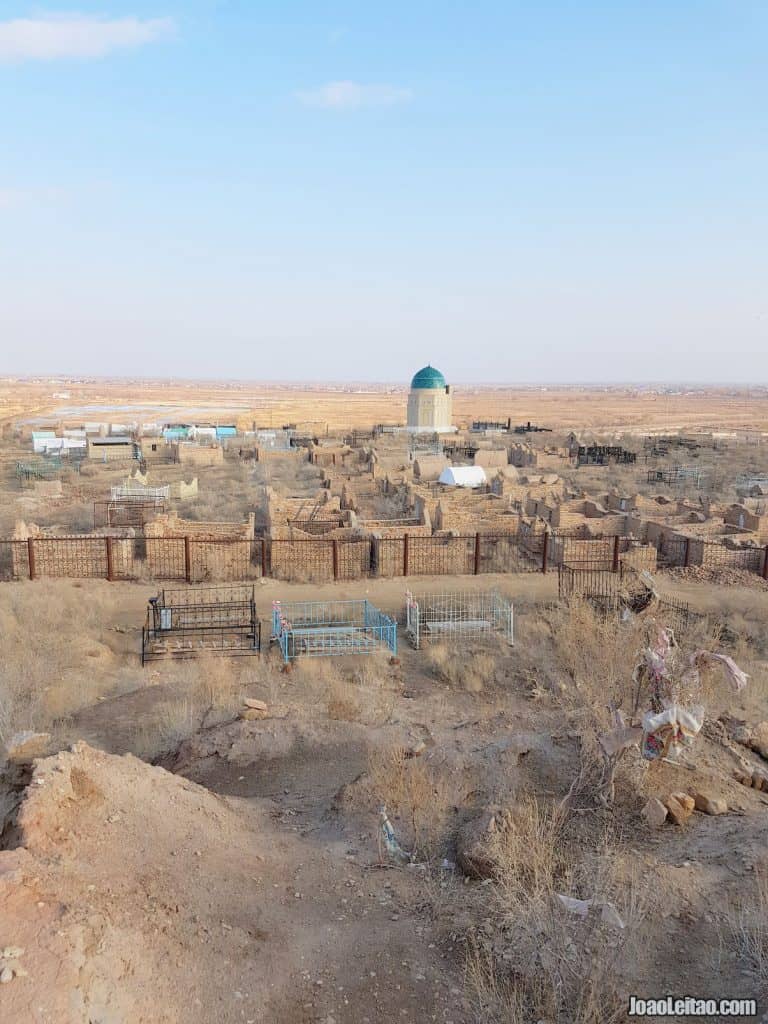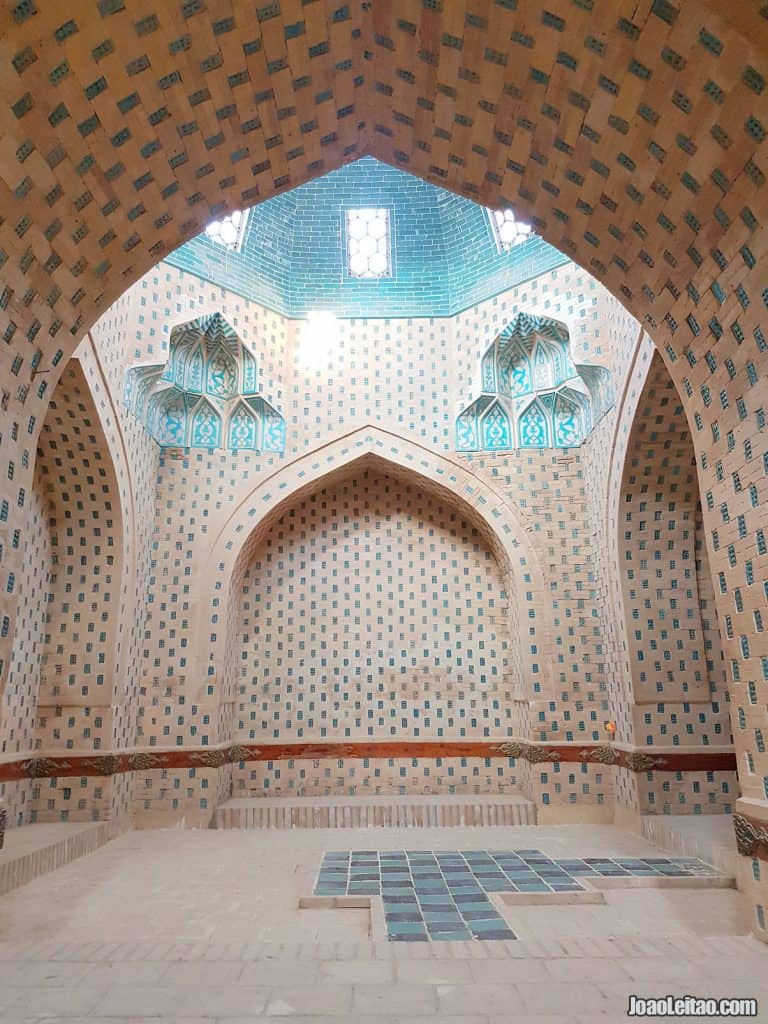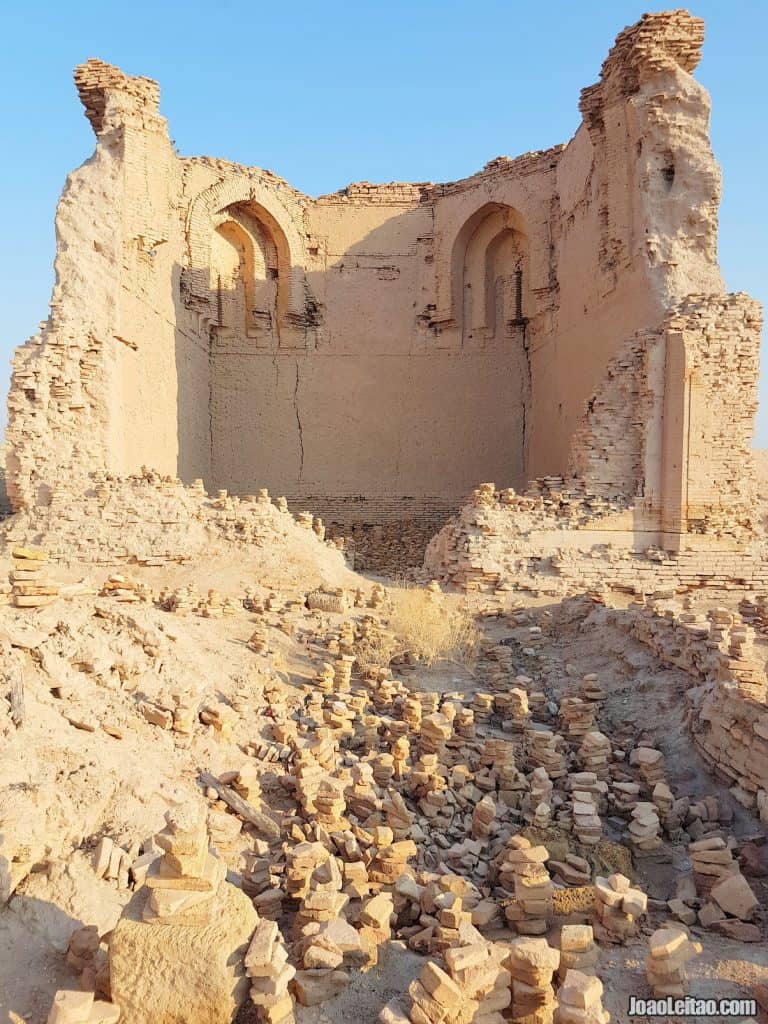Table of Contents
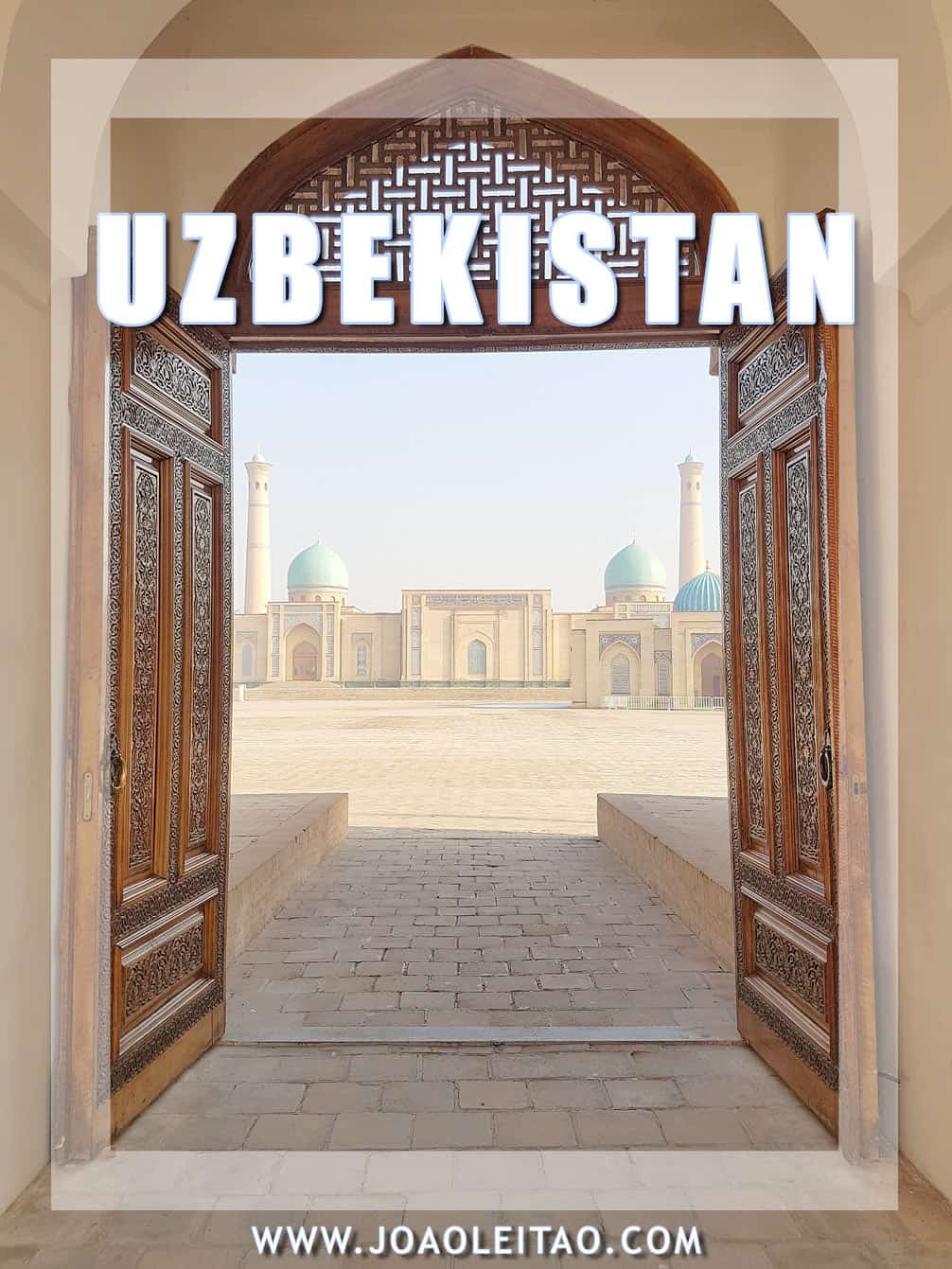
Welcome to my Uzbekistan Travel Guide specially made for your convenience and help you organize your next trip.
Uzbekistan is one of the Central Asian countries that became independent after the Soviet Union collapsed.
Like other former members of the USSR, this country has a long history of sovereignty, with several independent states and some occupations, and a short-lived republic after the First World War followed by the forced integration into the Soviet Union.
Uzbekistan is among my top 5 favorite countries to travel, and I’ve been there many times. Although I advise you to stay at least one month in Uzbekistan, my travel guide focus on a 2-week itinerary.
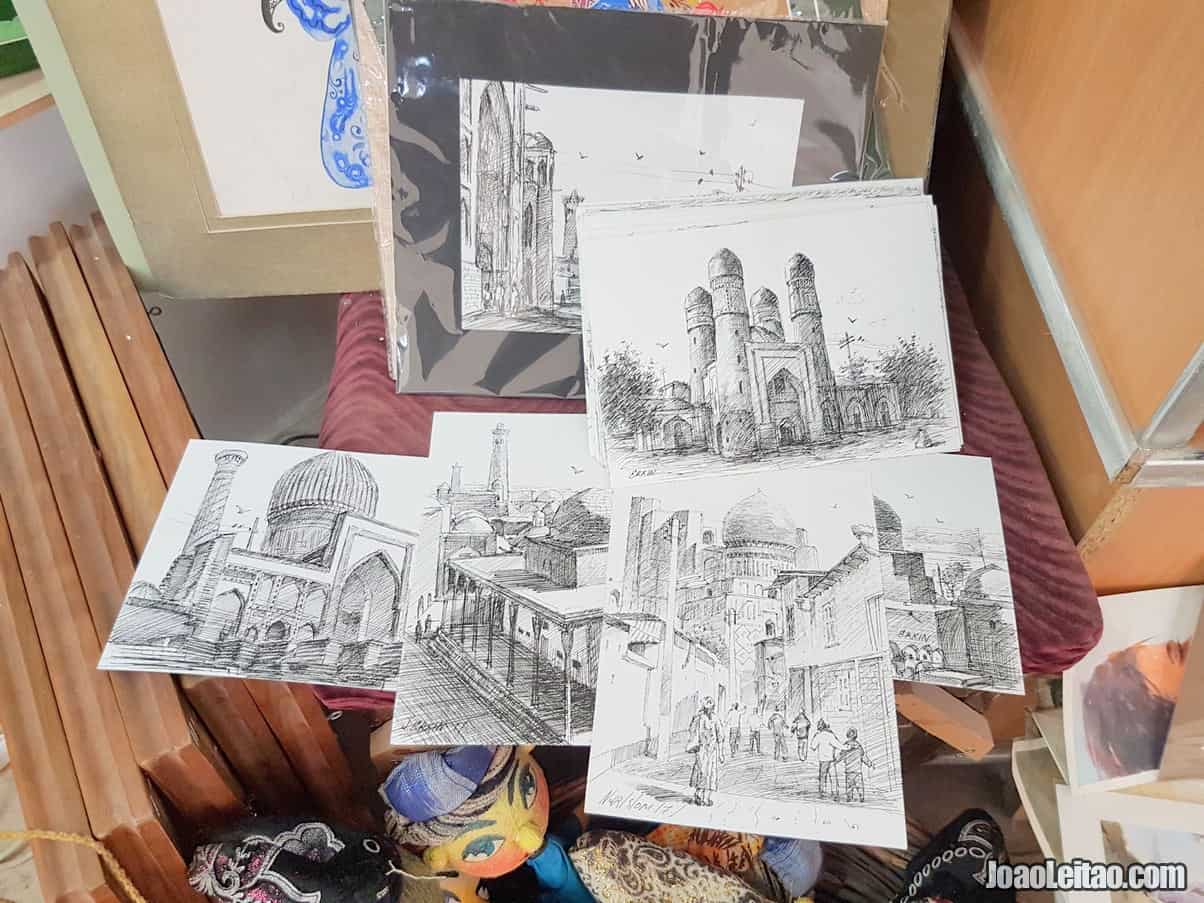
The first record of settlers in the current territory of Uzbekistan is of nomad people coming from what is now known as Iran, who settled here around the 8th century BC. The Persian Empire grew later to include this area, a control briefly interrupted by Macedonia. Only the Arabs and Islam made some serious changes.
From that time until the country became part of Russia, Uzbekistan was part of a patchwork of kingdoms and local dynasties, enduring the Mongolian invasions of the 13th century, and later being influenced by the political power of the Turkish.
Uzbekistan is centrally located in Central Asia, bordering with Kazakhstan, Kyrgyzstan, Tajikistan, Turkmenistan, and Afghanistan. Uzbekistan is one of the two countries in the world without a connection with the sea, separated from it by two other states.
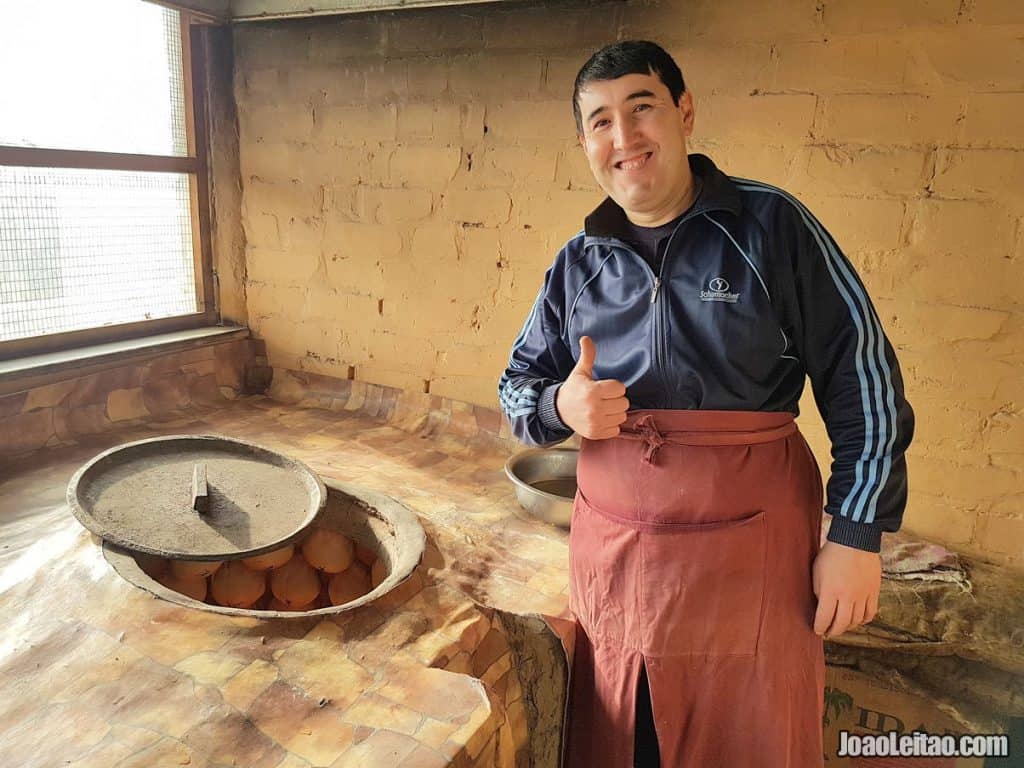
The country’s strategic position turned Uzbekistan in a vital part of the Silk Road, which made some of the main cities in the country more prosperous, generating enough wealth to build the heritage that all travelers come to see.
Uzbekistan is 450,000 square kilometers in area, about four times and a half the size of Portugal, and has approximately 33 million people. Most people are Uzbek (85%), but several minorities live in the country as well, including Russians, Tajiks, and Kazakhs. Islam is the main religion, but Uzbekistan is a secular state.
When to travel to Uzbekistan
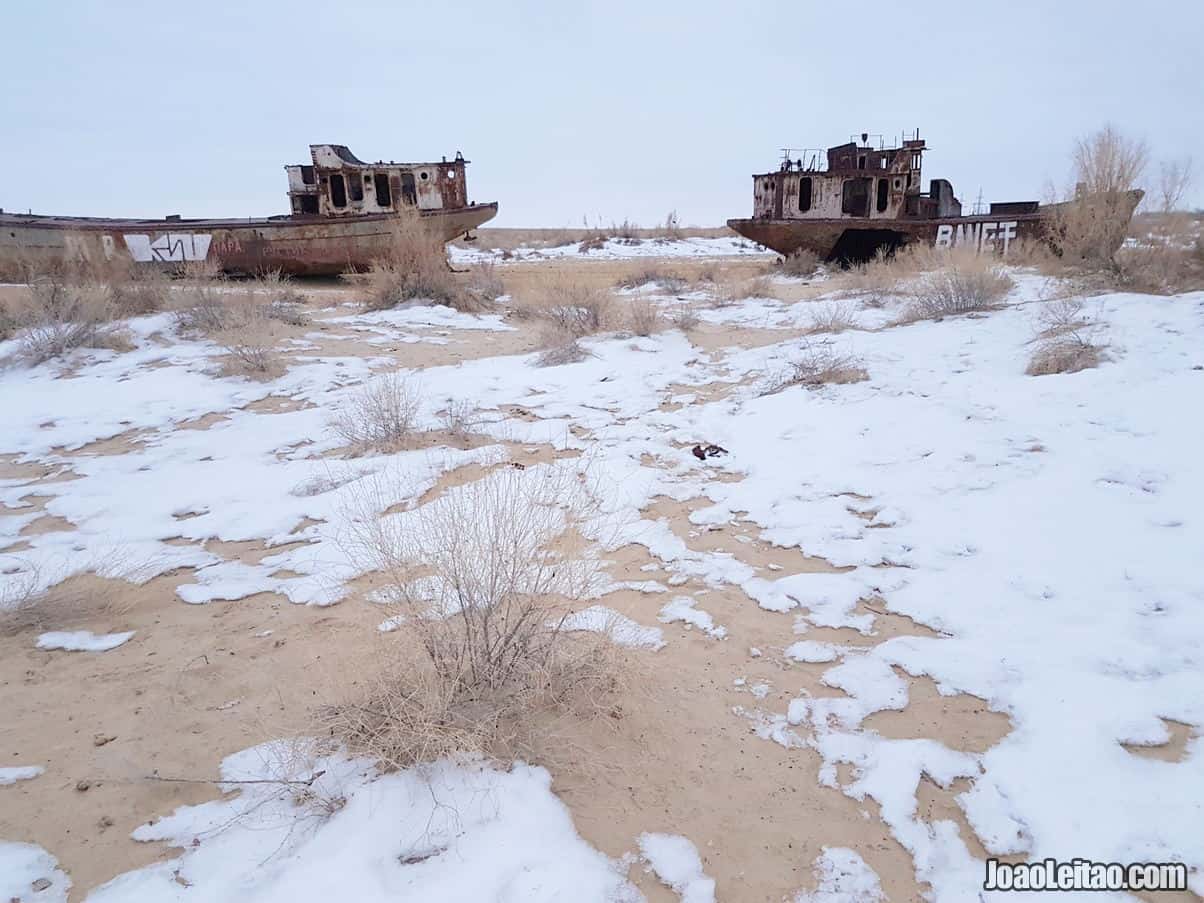
Uzbekistan’s climate is extreme with freezing cold winters and scorching hot summers when temperatures easily get as high as 50 degrees Celsius.
I had the chance of traveling to Uzbekistan during winter and summer seasons.
The so-called shoulder season is the best time to visit, which is before or after the summer, meaning at the end of spring or the beginning of fall. At that time, travelers will have the best weather conditions to explore the country with mild temperatures and no rain, although that is not usually an issue in Uzbekistan.
In the rainiest month, February, it rains for four days on average. Alternatively, you can travel in June to experience longer days with 14 hours of sunshine.
I entered Uzbekistan five times
- July 2004 – Border of KZ – fly out to IR – Backpacking Central Asia.
- June 2012 – Border of KZ to TJ – Central Asia Rally.
- June 2012 – Border of AF to TJ – Driving alone.
- July 2012 – Border of TJ to KG – Driving with my wife.
- December 2017 / January 2018 – Border of TJ to KZ – Driving with my wife and son.
AF = Afghanistan KG = Kyrgyzstan KZ = Kazakhstan IR = Iran TJ = Tajikistan UZ = Uzbekistan
Visas for Uzbekistan
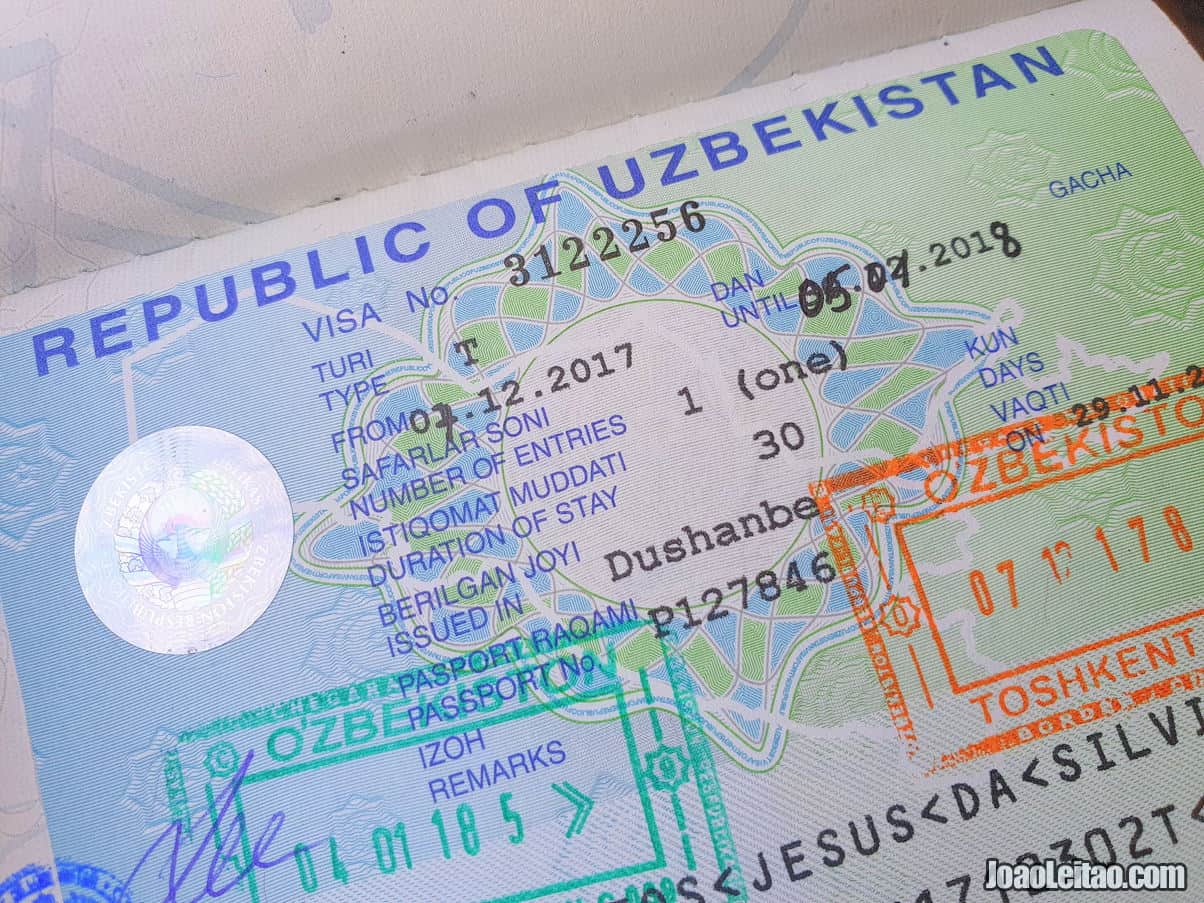
Visa policies in Uzbekistan have taken a turn for the better. There was a time, not too long ago, when getting a visa to visit the country was a difficult task.
- Since July 2018 that many nationalities benefit from the simplicity and the comfort of getting a visa online.
- Since 2019, many nationalities can now enter Uzbekistan without a visa.
Keep in mind that the country’s policies to manage travelers has had ups and downs, and these rules might change at any time without notice.
Uzbekistan Visa Exemption
90 days without visa
- Armenia , Azerbaijan , Belarus , Georgia , Kazakhstan , Moldova , Russia, Ukraine.
60 days without visa
- Kyrgyzstan.
30 days without visa
- All European Union passports, Andorra, Argentina, Australia, Bosnia and Herzegovina, Brazil, Brunei, Canada, Chile, Iceland, Indonesia, Israel, Japan, Liechtenstein, Malaysia, Monaco, Mongolia, Montenegro, New Zealand, Norway, San Marino, Serbia, Singapore, South Korea, Switzerland, Tajikistan, Turkey, United Arab Emirates , Vatican.
E-Visas for other countries
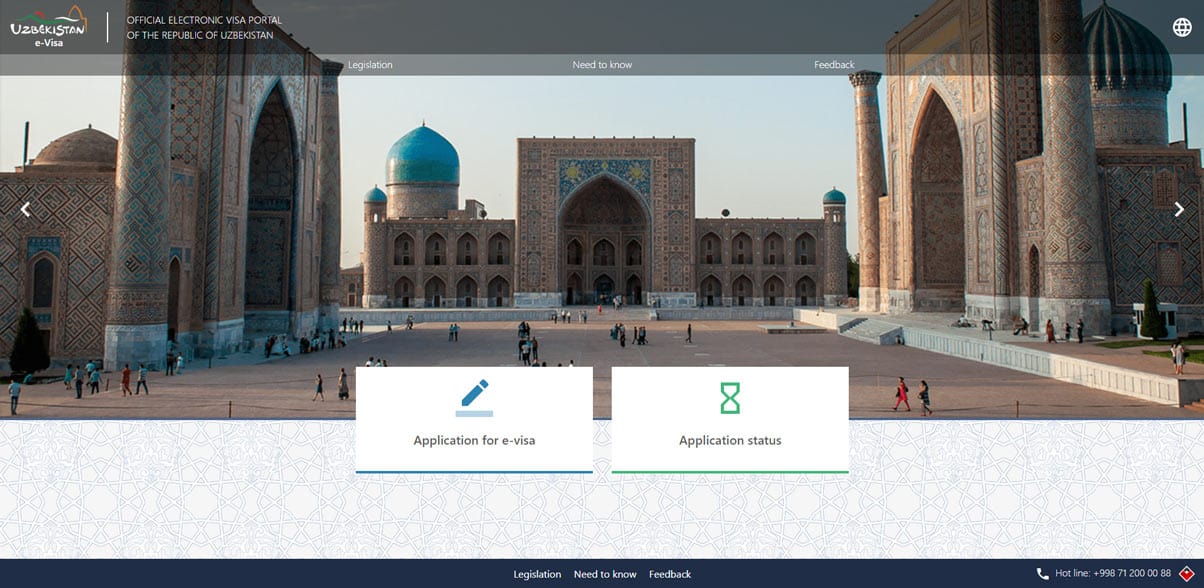
As of March 2019 eVisa is available to the citizens of the following 77 countries:
- Albania, Algeria, Angola, Antigua and Barbuda, Bahamas, Bahrain, Bangladesh, Barbados, Belize, Bhutan, Bolivia, Cabo Verde ,Cambodia, Cameroon, China, Colombia, Costa Rica, Côte d’Ivoire, Cuba, Dominica, Dominican Republic, Ecuador, Egypt, El Salvador, Fiji, Gabon, Ghana, Grenada, Guatemala, Guyana, Honduras, Hong Kong, India, Iran, Jamaica, Jordan, Kiribati, Kuwait, Laos, Lebanon, Maldives, Marshall Islands, Mauritius, Mexico, Micronesia, Morocco, Nauru, Nepal, Nicaragua, North Korea, North Macedonia, Oman, Palau, Panama, Paraguay, Peru, Philippines, Qatar, Saint Kitts and Nevis, Saint Lucia, Saint Vincent and the Grenadines, Samoa, Saudi Arabia, Senegal, Seychelles, Solomon Islands, South Africa, Sri Lanka, Suriname, Thailand, Tonga, Trinidad and Tobago, Tunisia, United States of America, Uruguay, Vanuatu, Venezuela, and Vietnam.
To travel to Uzbekistan, other citizens can get an e-visa, applying for the visa and receiving it online at the Uzbekistan official website.
You’ll need to fill an online form, send a passport size digital photo, and a scanned copy of your passport’s front page.
The e-visa costs USD 20, paid with a credit card, and allows you to stay in the country for up to 30 days. Travelers should apply at least three working days before their date of arrival. Once the visa is granted, it’s valid for three months. That means if you apply on 1 March, you have to leave Uzbekistan by 1 June. However, you can’t stay in the country for more than a month.
Usually, the e-visa is issued in the following two working days and sent to the applicant via email.
Travelers Registration
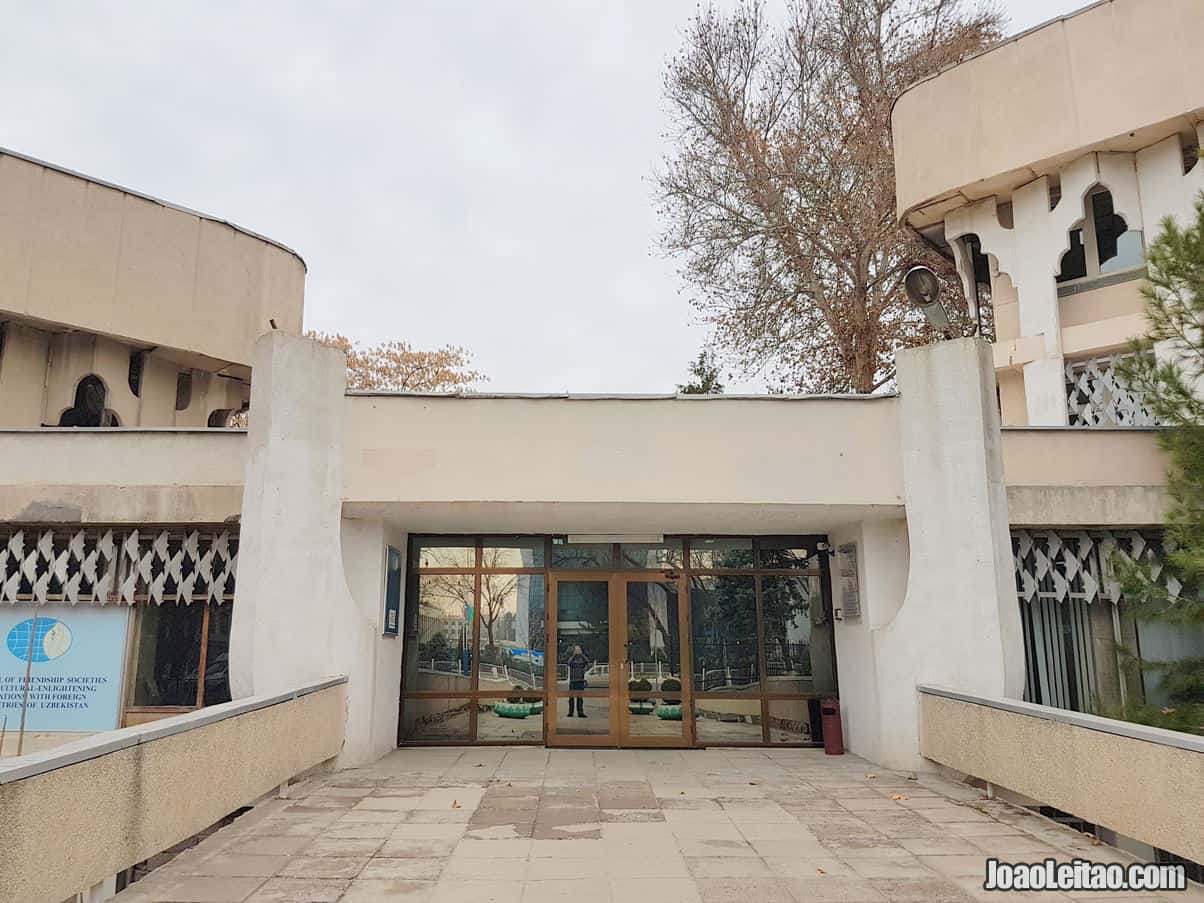
In Uzbekistan, foreign travelers have to register with the local authorities and pay a tourist fee, unless you’re staying in the country for less than three working days.
If you’re staying at a hotel, they will do the registration for you. If you’re staying in private houses, through Airbnb or other platforms, check with your host who needs to take care of the registration.
If you have to do it yourself, do it on the official website.
UPDATE: Foreign nationals will not need registration if their stay in each city, town, village doesn’t last more than three days. Read here.
How to get to Uzbekistan
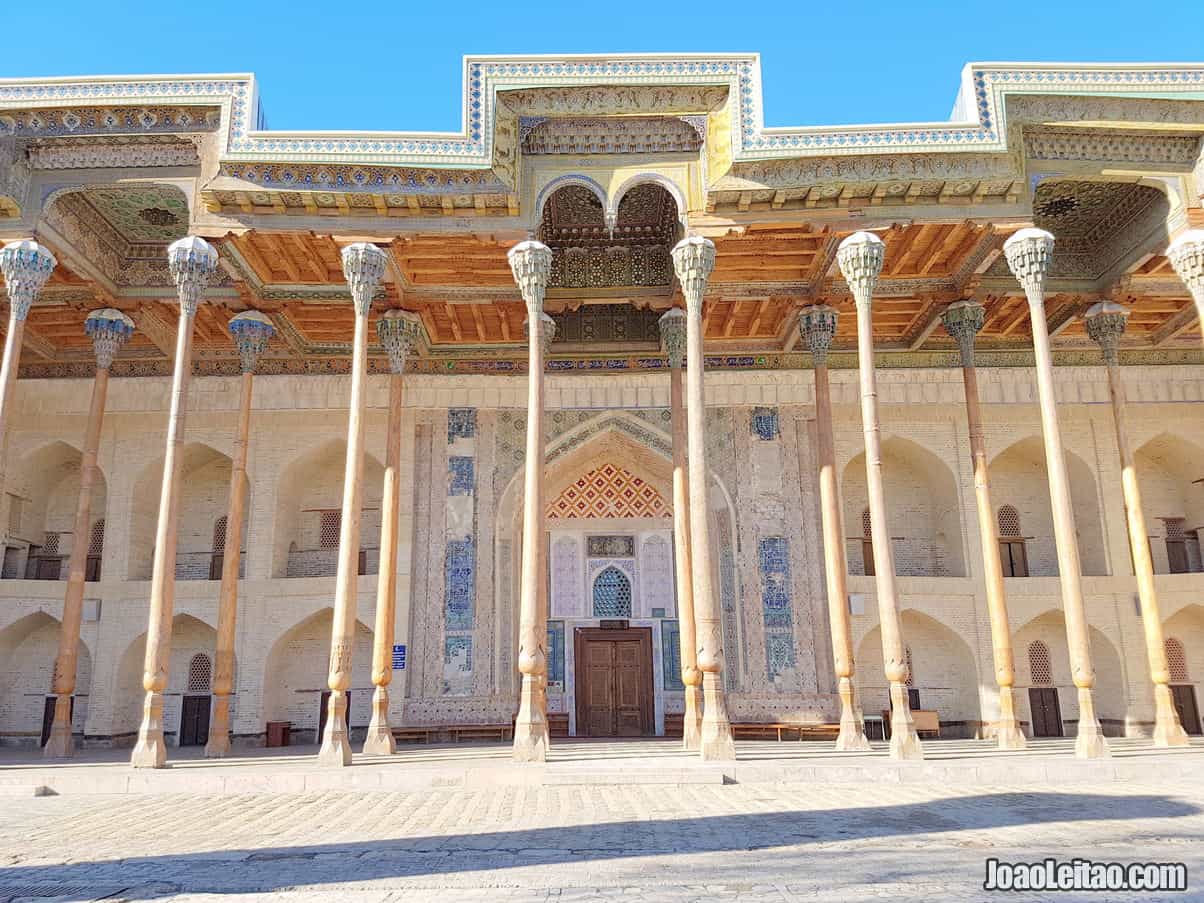
Uzbekistan is right at the heart of Central Asia, within easy reach from any other country in that region.
Most visitors include more than one of these countries in their itinerary, perhaps all, so they can reach Uzbekistan from Kazakhstan, Tajikistan, or Kyrgyzstan. And if you’re lucky getting a visa, even from Turkmenistan. The bolder travelers might even be able to travel here from Afghanistan.
You can travel overland from any of these countries, typically in a marshrutka, the shared vans that are widely used for traveling in this area.
Also read my pages:
First time in Kyrgyzstan: 10-day travel itinerary
Why I decided to visit Kyrgyzstan again: 22-day travel itinerary
How to buy a SIM Card in Uzbekistan

There are three mobile operators in Uzbekistan. UzCell and Beeline are the biggest companies and have similar prices, coverage, and quality. UMS is a smaller competitor.
Just like getting a visa has improved over time, getting a SIM card in Uzbekistan has become simpler. Up until 2017, foreigners couldn’t get one, so they had to rely on a local willing to help them get a card on their behalf.
In March 2018 this ban was lifted, and you should be fine getting a SIM card now. However, you might run into an employee who is misinformed and not so cooperative. If that’s the case, try another company or a different store.
In fact, they even have packages specially created for foreign travelers, valid for 30 days, that includes calls and data and that you can buy at the airport.
Whatever the way you choose to do it, it’s essential to get a card. Communication is cheap in Uzbekistan, no more than a couple of cents per minute.
NOTE: Don’t expect the Internet speed to be good in Uzbekistan.
Public Transportation in Uzbekistan
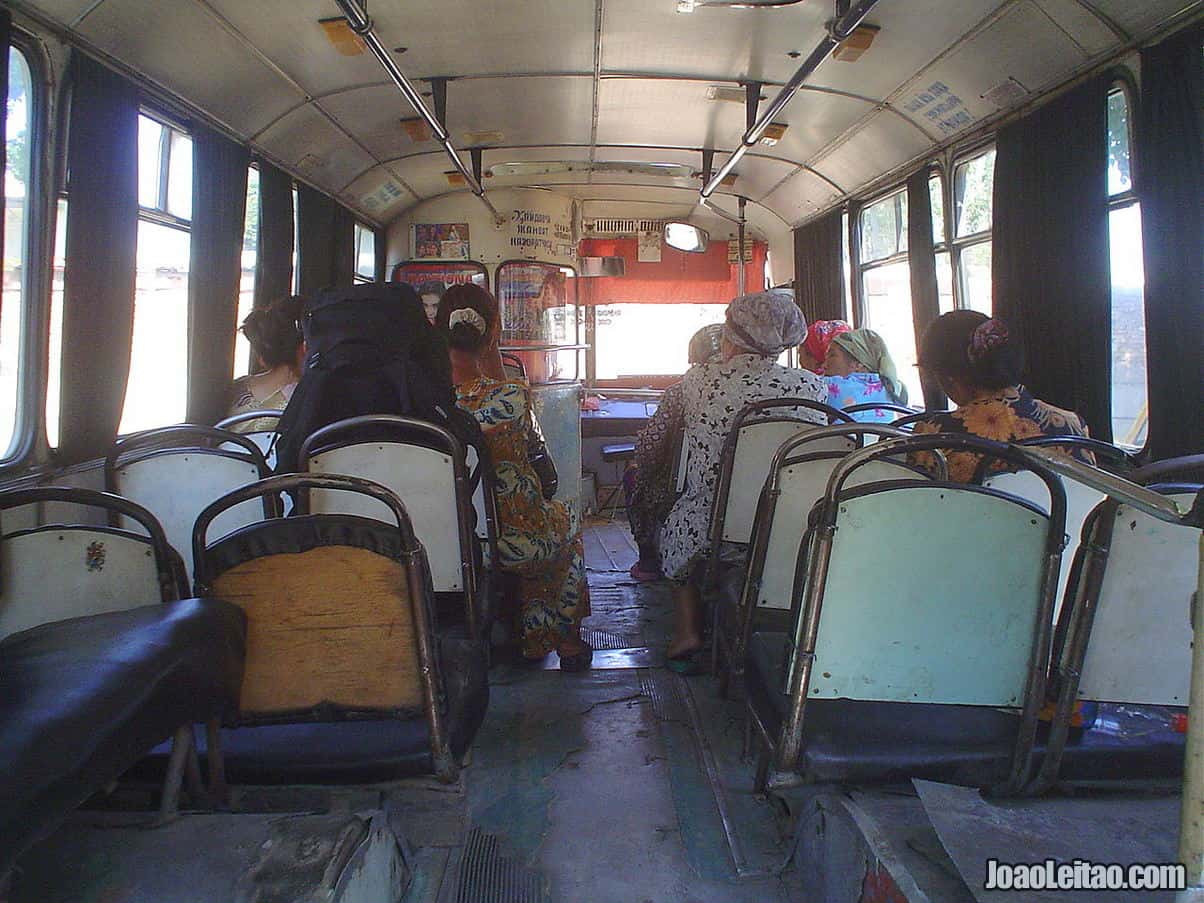
There are two ways to travel between the main cities in Uzbekistan: by marshrutka, the shared vans that replace buses here, and by train.
The marshrutkas are typically at the main bus stations, whether in some of the larger cities they might have several departing areas. Plan ahead to know where to go to travel to your next destination.
Traveling in a marshrutka is always an adventure. Vans don’t leave until they’re full, and even after that there are always heated discussions about everything, whether it’s how cargo is loaded, seating arrangements, or the drop-off area of one of the passengers.
Drivers usually drive boldly, to say the least, giving you an unintentional adrenaline rush, especially if you’re traveling in the front seats. On longer trips, they make frequent stops along the way for passengers to stretch their legs, use the bathroom, or eat something. Reaching your destination is always a surprise. You might be dropped off way far of where you’d expect to be or right at the doorstep of your hotel.
Trains are a valid option to travel inland, and you can check the official website for the railroad company for schedules and for buying tickets online. In two hours, you can travel from Tashkent to Samarkand, saving a lot of time when compared to traveling the same route in a marshrutka. Bukhara is near the railroad and Khiva is also served by trains. However, some of the places in Uzbekistan you can only reach by car.
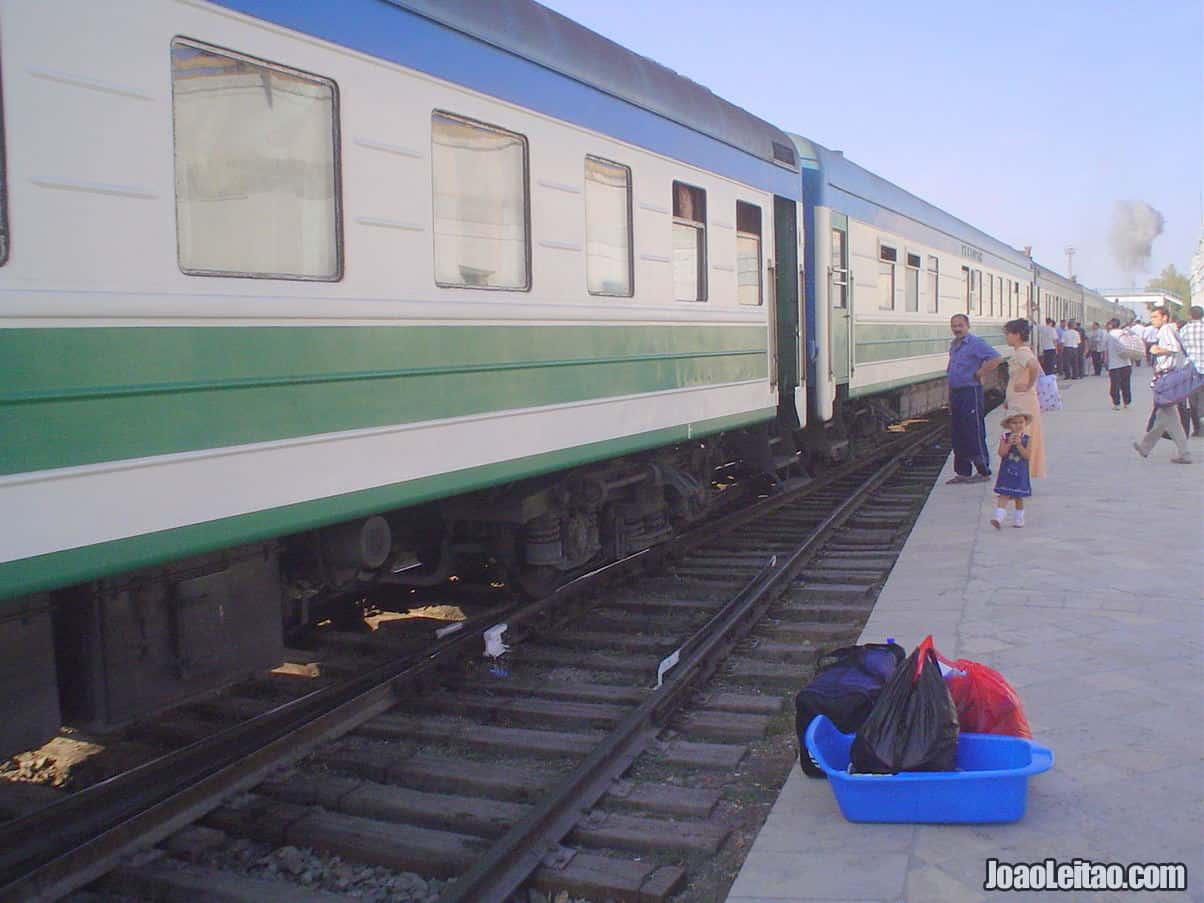
Taking a train to get in or out of the country can be a good option, with regular connections to Almaty in Kazakhstan, Bishkek the capital city of Kyrgyzstan, and Dushanbe in Tajikistan.
If you’re short on time and have enough cash, you can book domestic flights for some trips in the country. Uzbekistan Airways connects several airports in the country at reasonable prices. For example, a flight from Tashkent to Samarkand can cost 20 Euros or less.
UNESCO World Heritage Sites in Uzbekistan
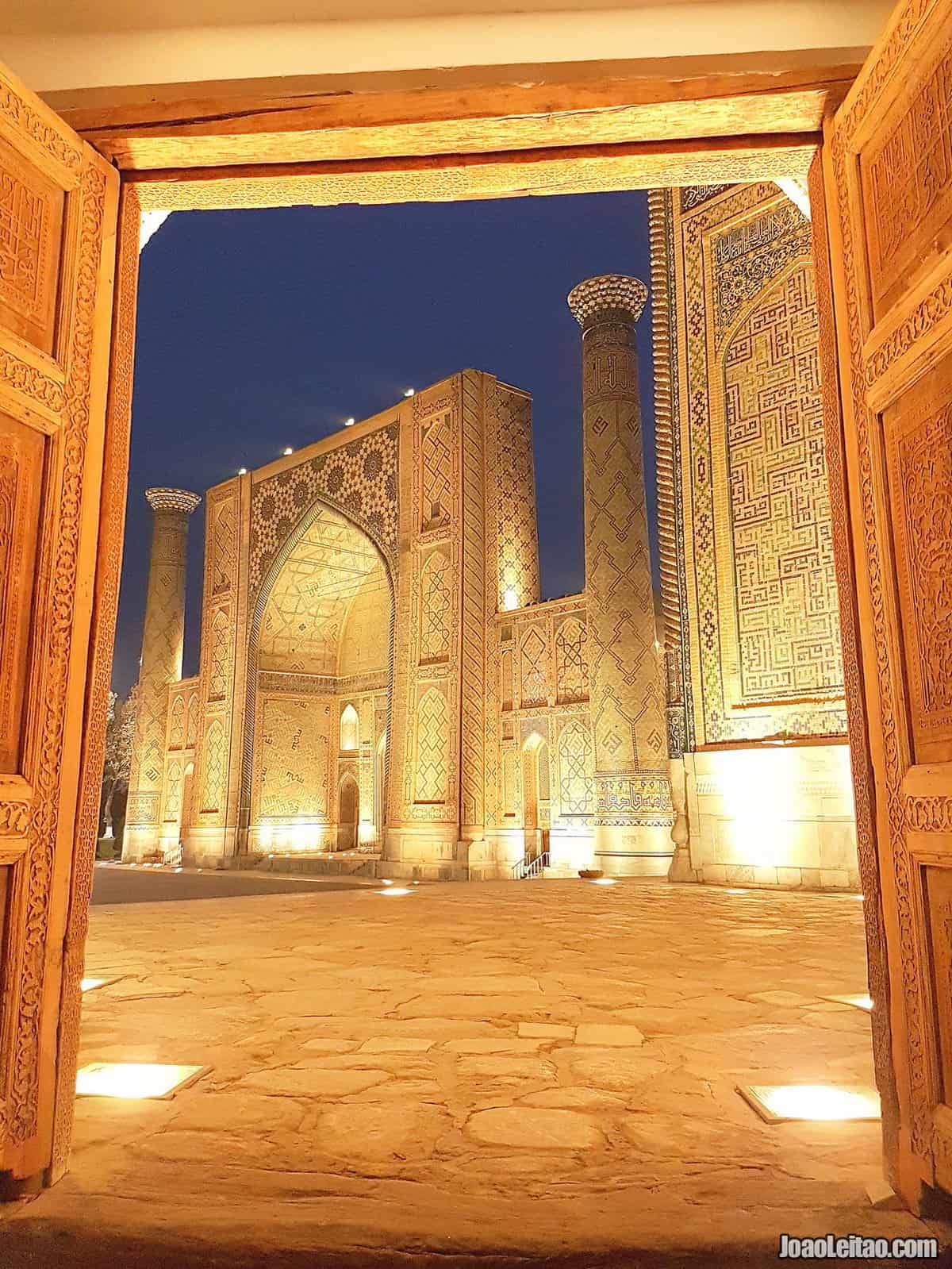
Uzbekistan has five UNESCO World Heritage Sites (read more here), most of them the result of the Silk Road that crossed the country.
- The biggest walled city in Central Asia, Itchan Kala, was the first site to become part of the list, in 1990.
- The Historic Center of Bukhara (1993).
- The Historic Center of Shakhrisyabz (2000).
- Samarkand (2001).
- The natural site of Western Tien-Shan (2016).
In addition to these five sites, Uzbekistan has 30 more in the tentative list.
This list might inspire you or enrich your travel itinerary. It’s definitely full of interesting places to visit. I personally visited many of these places.
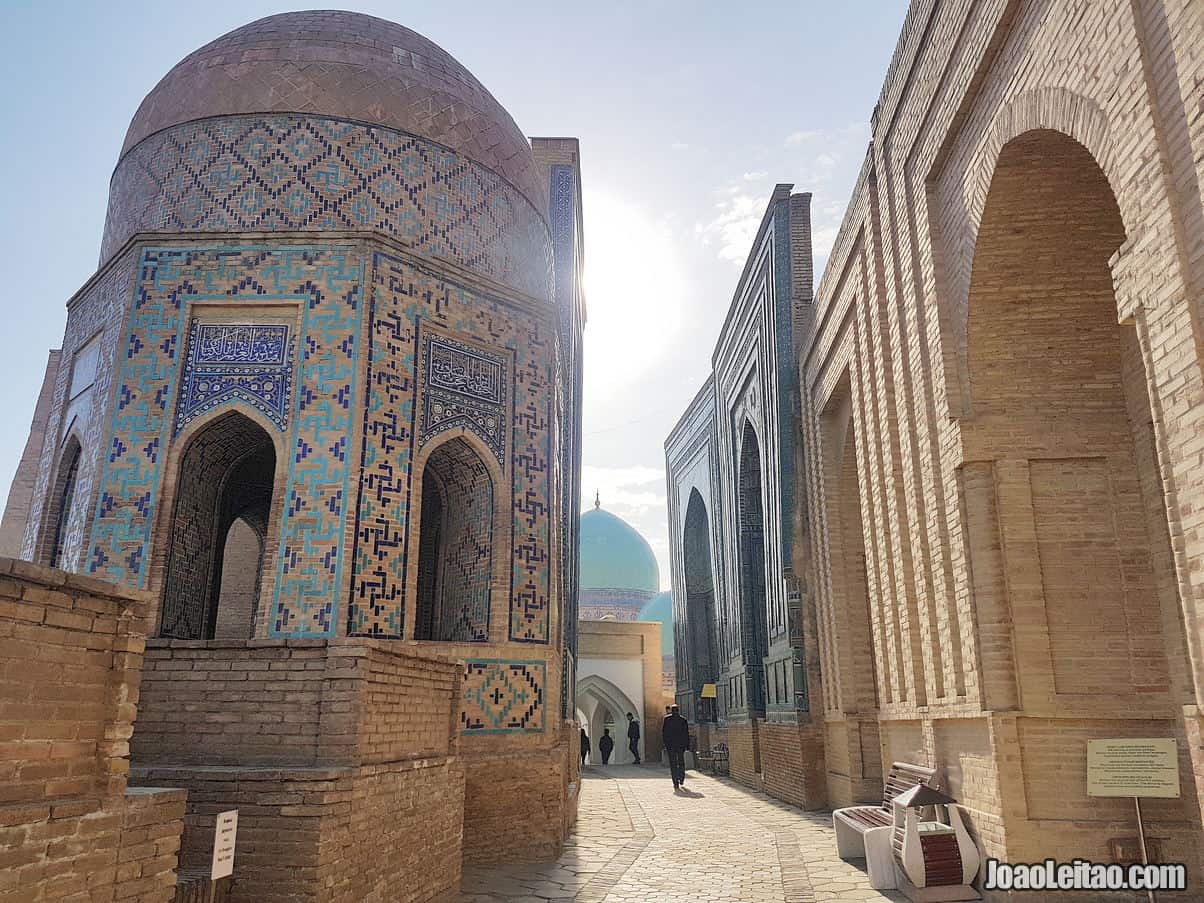
Uzbekistan UNESCO tentative list
- Complex of Sheikh Mukhtar-Vali (1996)
- Khanbandi (1996)
- Ak Astana-baba (Mausoleum) (1996)
- Kanka (2008)
- Shahruhiya (2008)
- Abdulkhan Bandi (2008)
- Zaamin Mountains (2008)
- Arab-Ata Mausoleum (2008)
- Historic Center of Qoqon (2008)
- Shokhimardon (2008)
- Ahsiket (2008)
- Ancient Pap (2008)
- Gissar Mountains (2008)
- Andijon (2008)
- Siypantosh Rock Paintings (2008)
- Ancient Termiz (2008)
- Zarautsoy Rock Paintings (2008)
- Boysun (2008)
- Poykent (2008)
- Varakhsha (2008)
- Chashma-Ayub Mausoleum (2008)
- Chor-Bakr (2008)
- Bahoutdin Architectural Complex (2008)
- Sarmishsay (2008)
- Rabati Malik Caravanserai (2008)
- Mir-Sayid Bakhrom Mausoleum (2008)
- Khazarasp (2008)
- Desert Castles of Ancient Khorezm (2008)
- Minaret in Vobkent (2008)
- Silk Road Sites in Uzbekistan (2010)
Also read my page:
20 Of The Best Places To Visit In Uzbekistan
Uzbekistan Travel Guide
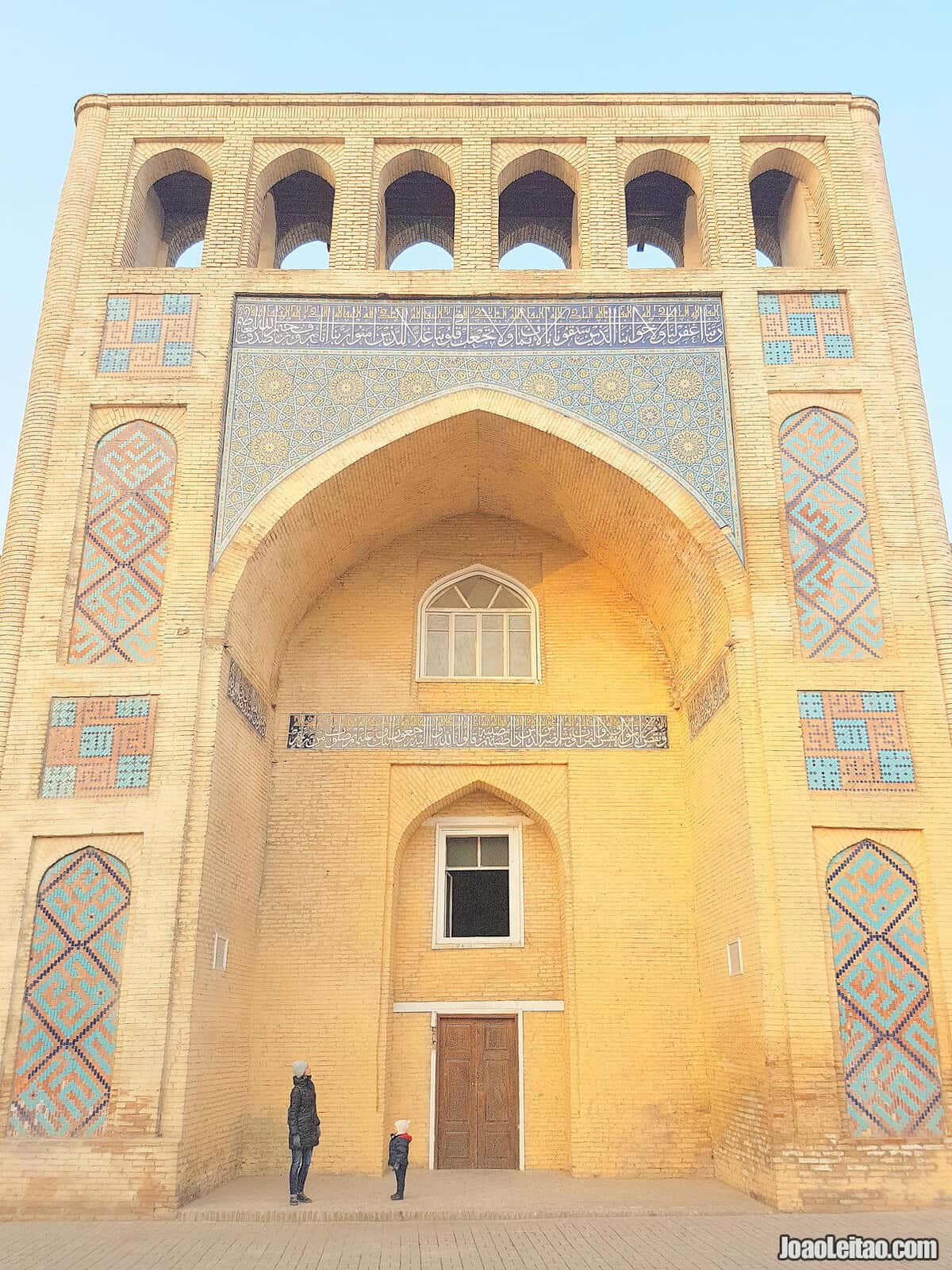
When we’re talking about a country that you can reach from so many parts, it’s complicated to narrow it down to one route. On this trip to Uzbekistan, we’ll depart from the capital city, Tashkent, because in addition to being the first stop for people traveling from Kazakhstan or Tajikistan, it’s also where most travelers fly into.
Map of Two Weeks Itinerary in Uzbekistan
Travel to Uzbekistan with a two-week Itinerary.
Visit Tashkent in 2 Days
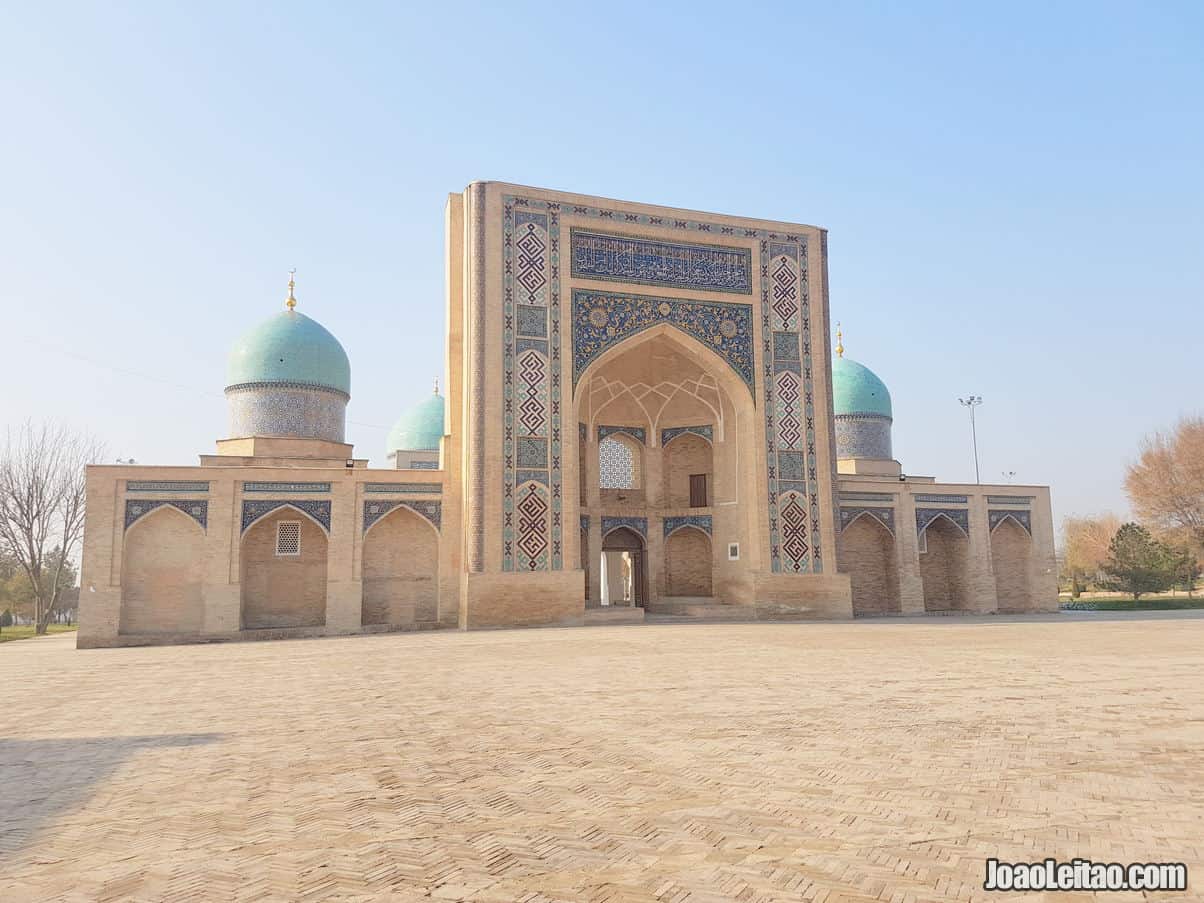
Tashkent is the capital of Uzbekistan, a city with about two and a half million people right next to the border with Kazakhstan.
It might not be the country’s most charming city, but it’s still an Uzbek city, which means it will always be fascinating. It’s made of contrasts and contradictions, most of them recent, but it has an interesting historic center. In some areas, it’s a modern city, and then in others, it looks surprisingly like a small country town. And although it doesn’t look like it, it’s one of the oldest cities in Central Asia. Unfortunately, a lot of its historical heritage was damaged or destroyed by the violent earthquake in 1966.
You’ll be able to see the Soviet inheritance, visit the best museums in Uzbekistan and if you want you can use the city as the base for day trips to places like the Ugam-Chatkal National Park.
NOTE: Don’t be fooled by many online travel guides that say Tashkent lacks interest and tourist places to visit. On the contrary, the capital of Uzbekistan surprisingly hold a wide variety of monuments, museums, markets, religious complexes, gardens, madrasas, caravansaries and squares to keep you busy for a few days.
Arriving at the Airport
Once you’re done with all arrival formalities, you can exit the international terminal.
Across from the terminal, after you’ve crossed the parking lot and right before the main road, you’ll see the stop from where you can take a bus to the city center, 18 km away. A one-way ticket should cost around 1,000 SOM, paid to the driver when getting off. You can also opt to travel in marshrutkas, shared vans, but the ticket is a bit more expensive.
If you prefer the comfort of a taxi, the fare is around 2 or 3 dollars, but if you don’t speak Russian or Uzbek, it will be complicated to negotiate the price down to those amounts with the drivers. Avoid going with one of the people offering you taxi rides outside the airport. Most are unlicensed drivers who wait for gullible passengers outside the terminal. Avoid them altogether and look for the official taxi parking lot.
Things to do in Tashkent
Map with the most famous Tashkent tourist places.
- Amir Timur Museum
- Museum of Applied Arts
- Botanical Garden
- History Museum of Uzbekistan
- Tashkent Museum of Art
- Chorsu Market
- Madrasa Kukeldash
- Amir Timur Square
- Cathedral of St. Alexander Nevsky
- The Mausoleums of Tashkent
- Tashkent Tower
- Tillya Sheikh Mosque
- Little Mosque
- Cathedral of the Sacred Assumption
- Independence Square
- Juma Mosque
- Monument to Courage in Earthquake
- Cathedral of the Sacred Heart of Jesus
- Independence Monument
- Railway Museum
Tashkent sights & tourist attractions
Tashkent is a city with almost two and a half million people and a lot to show to its visitors. A historical landmark on the Silk Road, it combines classical elements with Soviet-era architecture and a hand full of gifted museums.
Tashkent is heaven for travelers. People are welcoming, prices are low, food is varied and tasty, and you’ll find so much to do that you will be entertained for days. It’s a city with a lot of History that grew over the centuries thanks to the influence of the Silk Road.
However, after the plans to modernize the city made by the Soviets and the devastating earthquake of 1966, little is left from the old Tashkent. Nevertheless, you’ll see some traces of that past, including several mausoleums, mosques, and the Kukeldash madrasa.
Travelers can rely on the convenient subway network to visit the points of interest further from the city center and explore the rest on foot. Main attractions include the museums, the street markets, and the architectural traces of the Soviet age. For relaxing, I recommend the Botanical Garden.
History Museum of the People of Uzbekistan
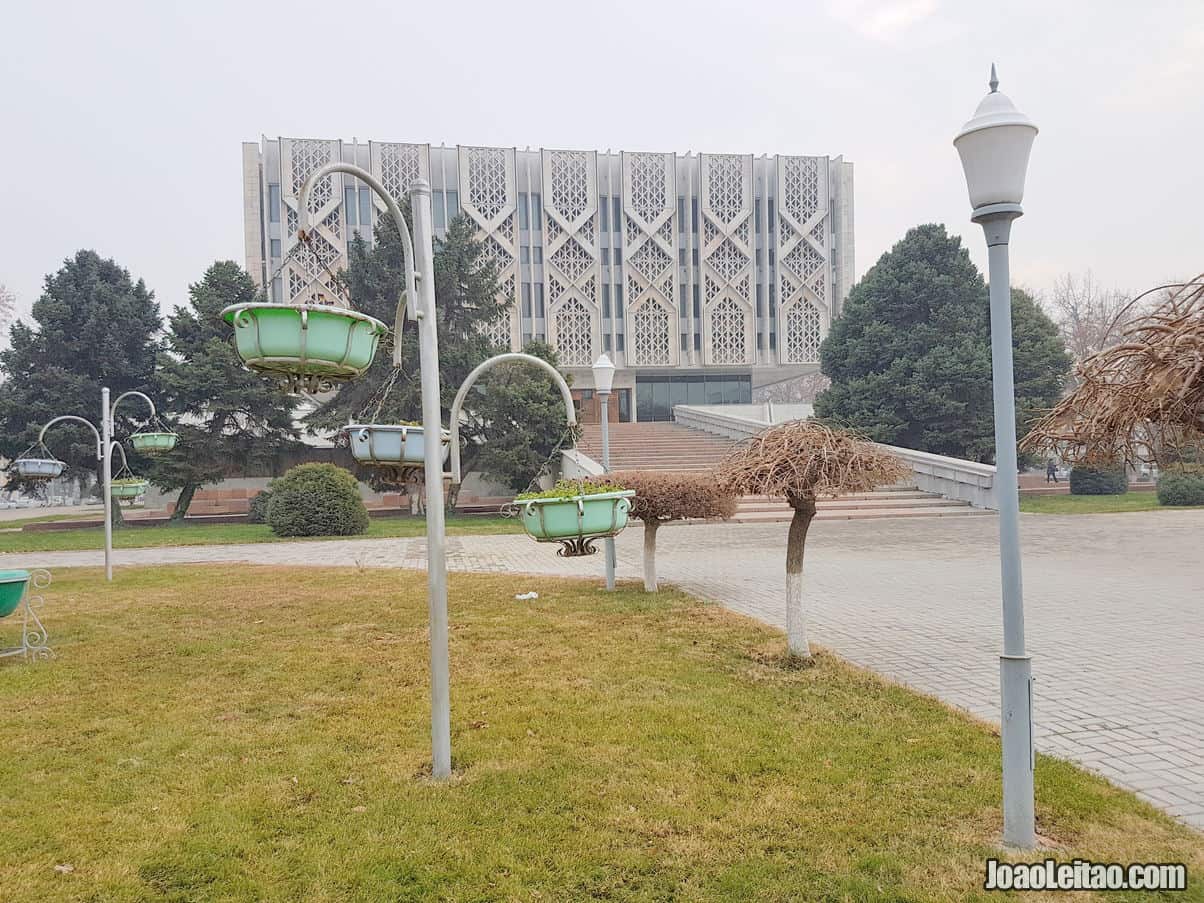
This is an essential site to understand Uzbekistan and its people. It was founded in 1876, and previously known as Turkistan National Museum and Lenin Museum. Recently it was renovated into a more modern museum, and new exhibition rooms were added.
Its collection has about 250,000 pieces, which includes 60,000 archaeological findings, 80,000 coins, and 16,000 ethnographical pieces.
A large part of the collection is on display, spread across the museum’s four floors, curated chronologically. It’s a diversified, interesting, and surprising exhibition.
The museum is open every day, except Mondays, from 10:00 am to 5:00 pm.
Navoi Theater
The Navoi Theater was designed by architect Alexey Shchusev, who also designed the Lenin Mausoleum and the Kazanskaya train station in Moscow. Construction began before the start of the Second World War, on the former location of a wine market, but only finished in 1947.
Going to a play at the Navoi is a one-of-a-kind experience, a way to feel how Soviet authorities cared about the arts, fostering the interest in theater, opera, and ballet. The tickets are much more affordable than in the theaters in Moscow, and it’s not unreasonable to sometimes find tickets as cheap as 1 Euro. Performances take place every day, and you can check the calendar on their official website.
You can purchase the tickets onsite until 6:00 pm, which is the time when, typically, the show starts. Arrive earlier to admire the building’s architecture and the majestic interiors. Please note there’s a dress code and people wearing shorts, flip flops, or sneakers are not allowed inside.
Chorsu Market
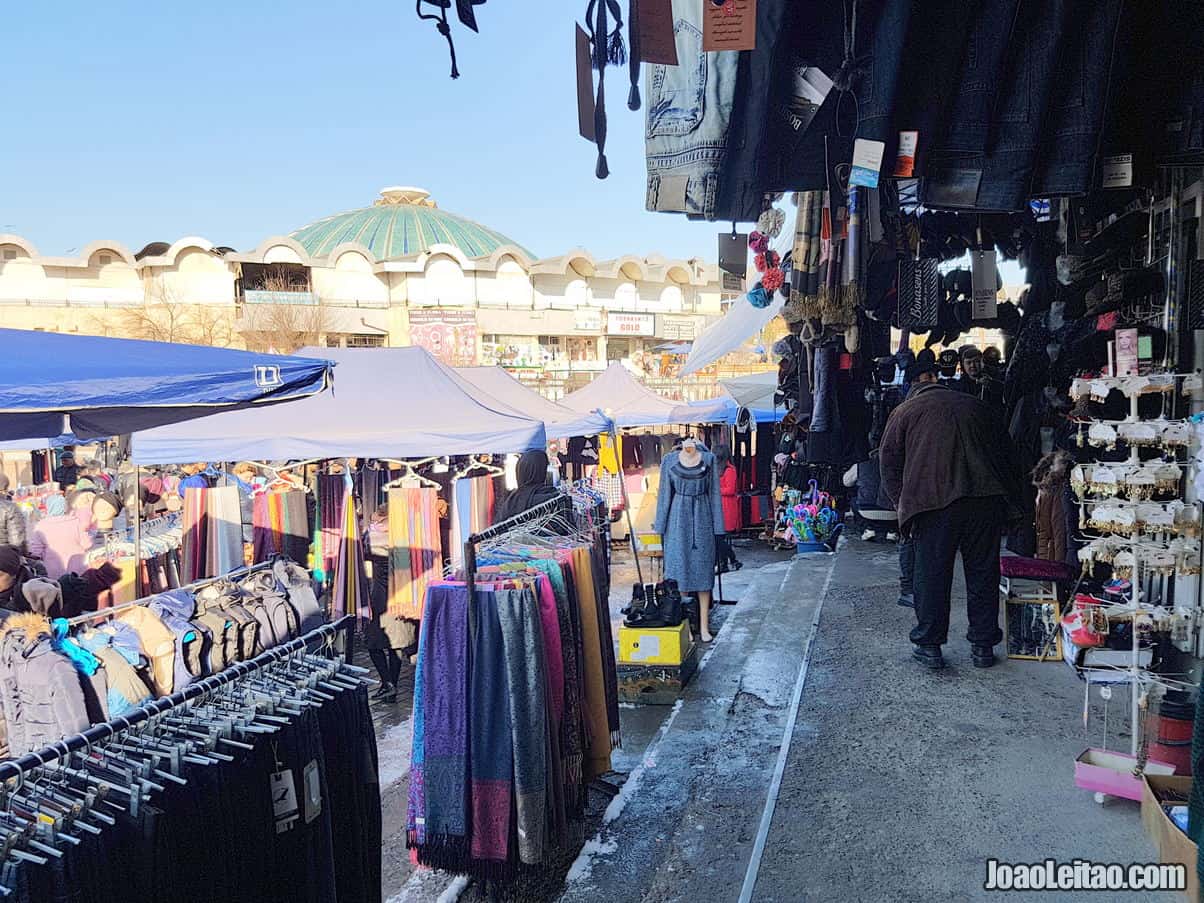
A trip to this market is essential when visiting the Uzbek capital. It’s near what’s left of the old city, and the name in Farsi translates into “four creeks” or “crossing.”
The main building has a very peculiar style, part of what was called the Soviet Orientalism aesthetic, with a massive dome placed over several arches. Smaller pavilions and stalls surround the central building, scattered across the area.
I love markets, and being able to explore this place early in the morning, was a fantastic experience. Don’t miss it.
Chorsu is like a small world, to many people one of the best markets in Central Asia. There you’ll find everything, sometimes orderly organized by sections of products and other times in complete chaos.
You can buy vegetables, meat, bread, dry fruits. You’ll also find cafes, restaurants, and street food stalls. You can find everything here in this colorful and lively market.
If you’re not staying nearby, you can take the Tashkent subway and get off at the Chorsu station.
Among the many markets and bazaars in Tashkent, Chorsu is the most famous one and probably the oldest, since there used to be a market at the same place from centuries ago. Its center is inside a peculiar looking building with 350 meters in diameter, that looks like a giant dome. The structure is a modern adaptation of the Uzbek tradition that built markets under domes to protect the merchants and the products from the heat and the desert sand. There are some more extensions around it and an open-air section. This market is on the south side of the city, by the Kukeldash Madrasa and Tashkent’s main mosque. Here you can buy spices, dry fruits, and fresh products like vegetables, meat, fruit, and dairy products. Around the market, you’ll also find lots of street food stalls, shoe shops, vendors of crafts and traditional clothes, and choykanas, the traditional tea houses. The market takes place every day.
Sheikhantaur Memorial Complex
Inside the Tashkent Islamic University there are three mausoleums dating back from the 15th-century. The guard at the gate didn’t want to let us in, but one of the university teachers came to our rescue and took us on a private tour around all the fantastic religious buildings.
Hotel Uzbekistan
Hotel Uzbekistan is perhaps the best example of Soviet architecture in the city, impressive in size and by the memory of a distant time. The best part is that you can stay at this hotel. One night in a double room costs 75 Euros, but it’s best if you lower your expectations and focus on appreciating the hotel as it might have been in the past when distinguished Soviet leaders and KGB agents stayed there.
Madrasas: Kukeldash e Barak Khan
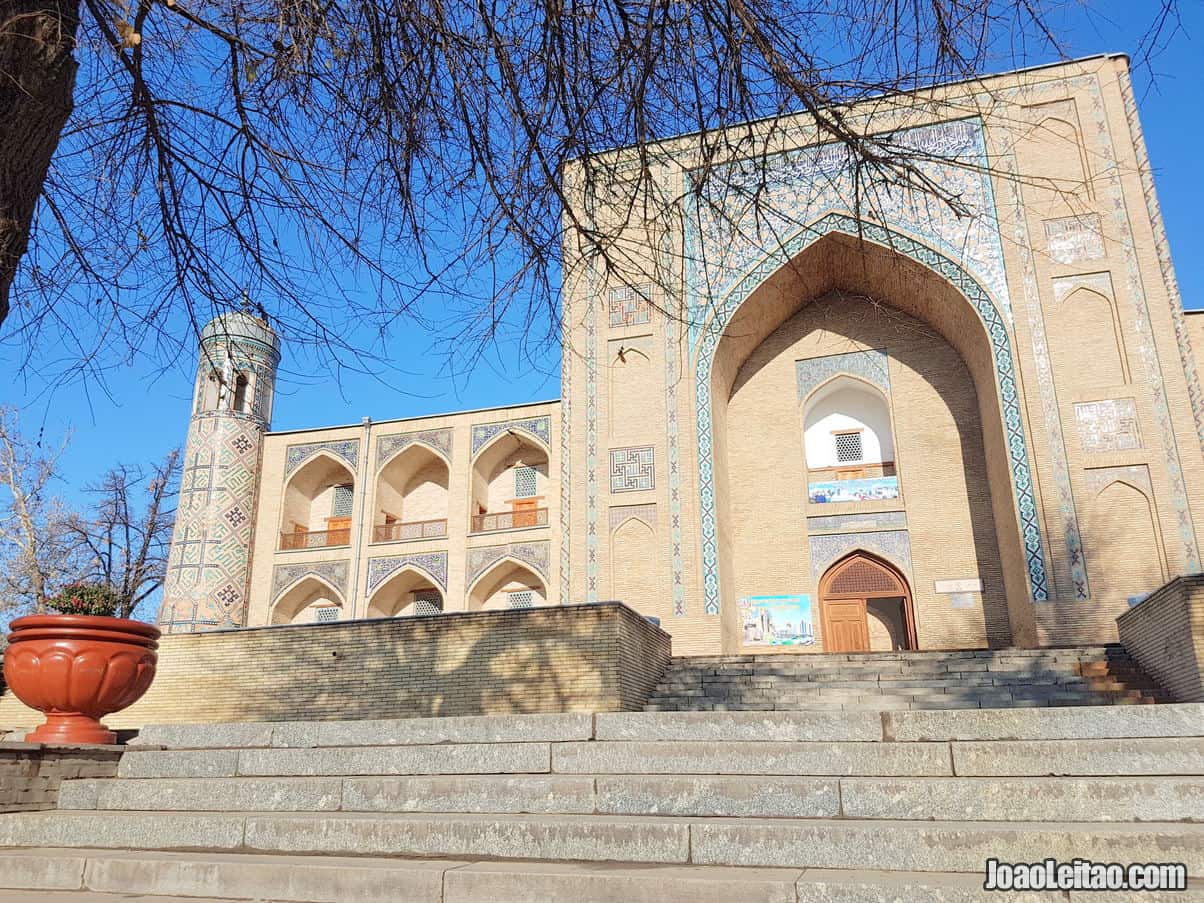
Kukeldash Madrasa is near the Chorsu Market and the Juma Mosque and was originally built in 1570. Over time it was severely damaged, especially as a result of different earthquakes. It was restored in the 20th century, and it’s one of Tashkent’s main points of interest. However, since this religious school still works, visits are limited.
The Barak Khan madrasa at Khast Imam square was also built in the 16th century, by Suyunidzh-khan. Its library is particularly rich, housing some valuable manuscripts like the Khalifa Osman’s Koran. The students’ old chambers were transformed into a souvenir shop.
Kukeldash madrasa, built in 1570, was part of the complex that made up Tashkent’s main square. It was commissioned by Dervish Khan, the Vizier of Tashkent during the Shaybanid dynasty, whose nickname was “Milk Brother” (Kukeldash). Initially built as a madrasa, in the 18th century, it was used as a caravanserai for the merchants traveling the Silk Road. Later, in the 19th century, it was used as a military facility and as a place for public executions by the Kokhand dynasty. After 1865 the building started to decay, a situation made worse by two consecutive earthquakes. It was restored in different stages in the second half of the 20th century. Nowadays, it’s a religious school again that welcomes people who want to pray here and tourists, who will appreciate the mosaics in the entranceway.
Earthquake Memorial
Also known as Courage Memorial, this monument was built in 1976 on the 10th anniversary of the great earthquake of 1966.
On 26 April 1966 an earthquake of 9-point Richter scale wiped out a large part of the city, and it’s estimated a quarter million people lost their homes.
The monument designed by D.B. Ryabichev and S. R. Adylov honors all those who worked to rebuild Tashkent, and it’s one of the best examples of Soviet-style statue art.
Amir Timur Square
This grand square is at the geographic and functional center of Tashkent. It was named after Amir Timur, the Mongolian ruler who became the symbol of Uzbek’s national identity. There’s a subway station at the square and a statue of Amir Timur on a horse, framed by trees hundreds of years old. The square was originally designed in 1870 by architects serving the Russian Tsar and was then called Constantine Square.
Since then, the main monument was changed several times from General Kauffman that was replaced in 1917 by the memorial to the Free Workers, then in 1927 replaced again by a monument celebrating the 10th anniversary of the Revolution, and later in 1947 replaced once more by a monument to Stalin. In 1967, a statue to Marx was placed there and in 1993, the current statue was placed.
Around the square, you can see the University of Law, the Amir Timur Museum, the Hotel Uzbekistan, the Forums Palace, and the Tashkent Chimes.
Khazrati Imam Architectural Complex
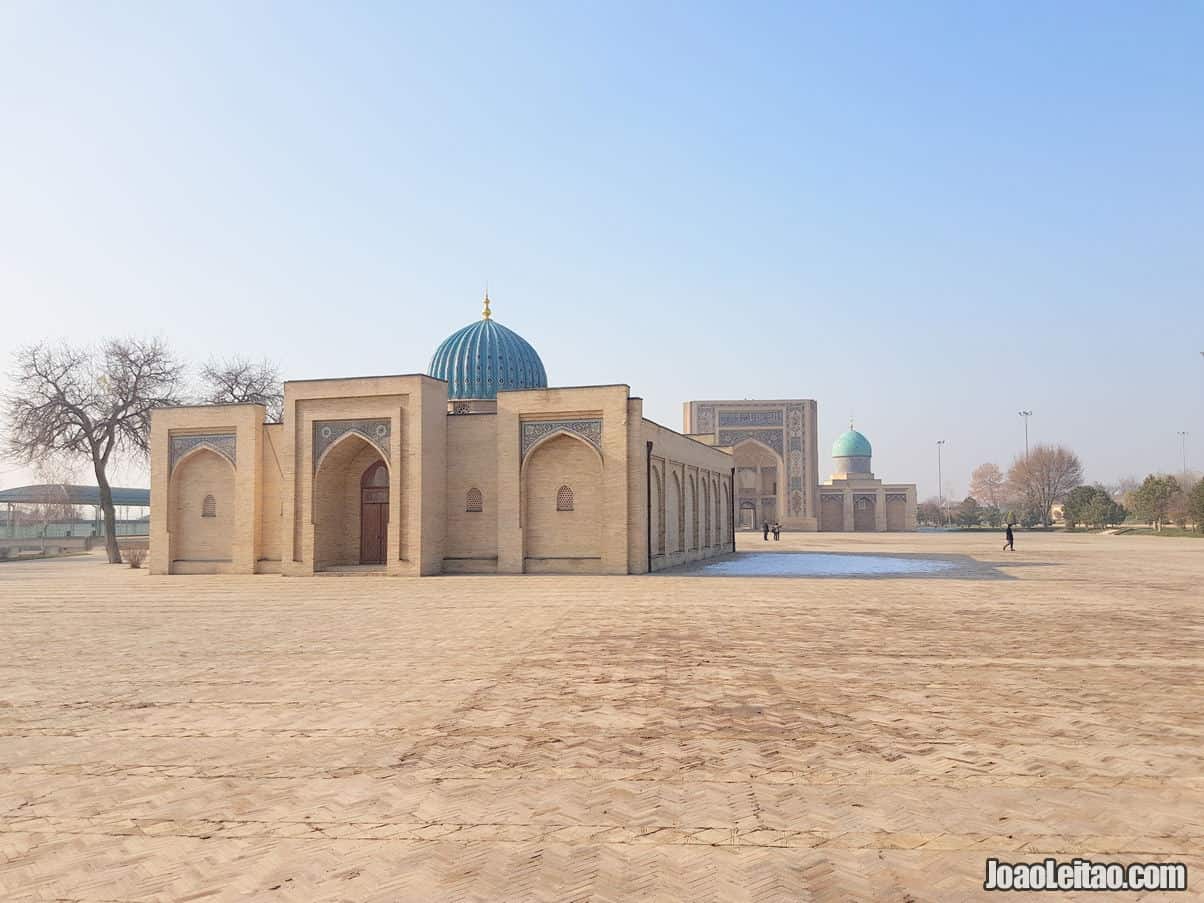
Fantastic place to explore different buildings with traditional architecture.
State Art Museum
The collection at the Museum of Fine Arts includes pieces of the last millennium and a half of art produced in the land that’s now known as Uzbekistan. It was founded in 1918, initially with pieces confiscated by the Soviets from their previous owners, in particular, the royal family Romanov.
It was first called the Museum of National University and was housed in one of the palaces of the Romanovs. It later moved to the so-called House of the People, which was demolished in 1974. At that time the museum moved into the current building in the center of the city. The cube-shaped building was designed by architects I.Abdulov, A. Nikiforov and S. Rosenblum.
To the original collection, they added pieces from other state museums from Uzbekistan, Moscow, and St. Petersburg. The collection includes works by I.Shishkin, P. Benkov, V.Vereshchagin, Z. Kovalevsky and A. Bellolil, just to name a few. The museum has a separate section for applied arts.
Museum of Applied Arts
The museum officially started in 1927 when it held its first exhibition. It was initially called Museum of Handicraft Art and was given the current name after a reorganization in 1997. The collection has over 7,000 pieces, including jewelry, embroidery, tapestry, and traditional clothes.
The exhibitions are organized into three areas: applied arts before the mid-19th centuries, pieces from that time onward and produced according to traditional methods, and contemporary applied arts.
Tashkent Tower
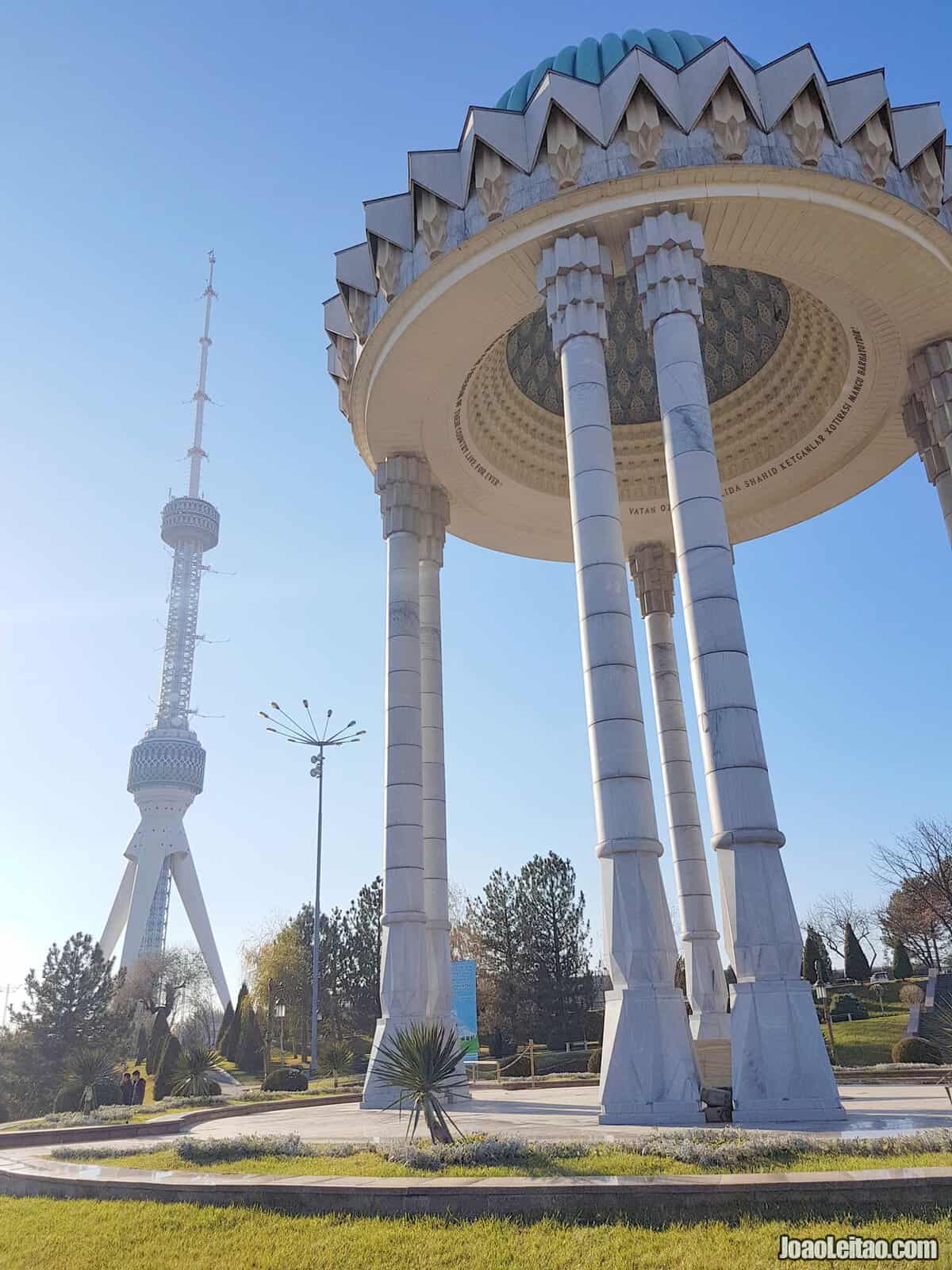
From the top of Tashkent Tower we can see the whole city. Fantastic place for the perfect bird-eye view of the capital of Uzbekistan. Unfortunately cameras can’t go inside.
Navoi Park
This urban park in the city center is dotted by Soviet-era governmental buildings and a few built after the country’s independence. It’s a vast open-air space where you can go for a stroll, do some people watching, and see traces of the Soviet Union times.
Kaffal-Shashi Mausoleum
Kaffal-Shashi was a saint, a poet, and a theologist who lived over 1,000 years ago and was very respected and worshipped in the city. The 16th-century mausoleum is on the northeast side of Khast Imam square.
Juma Mosque
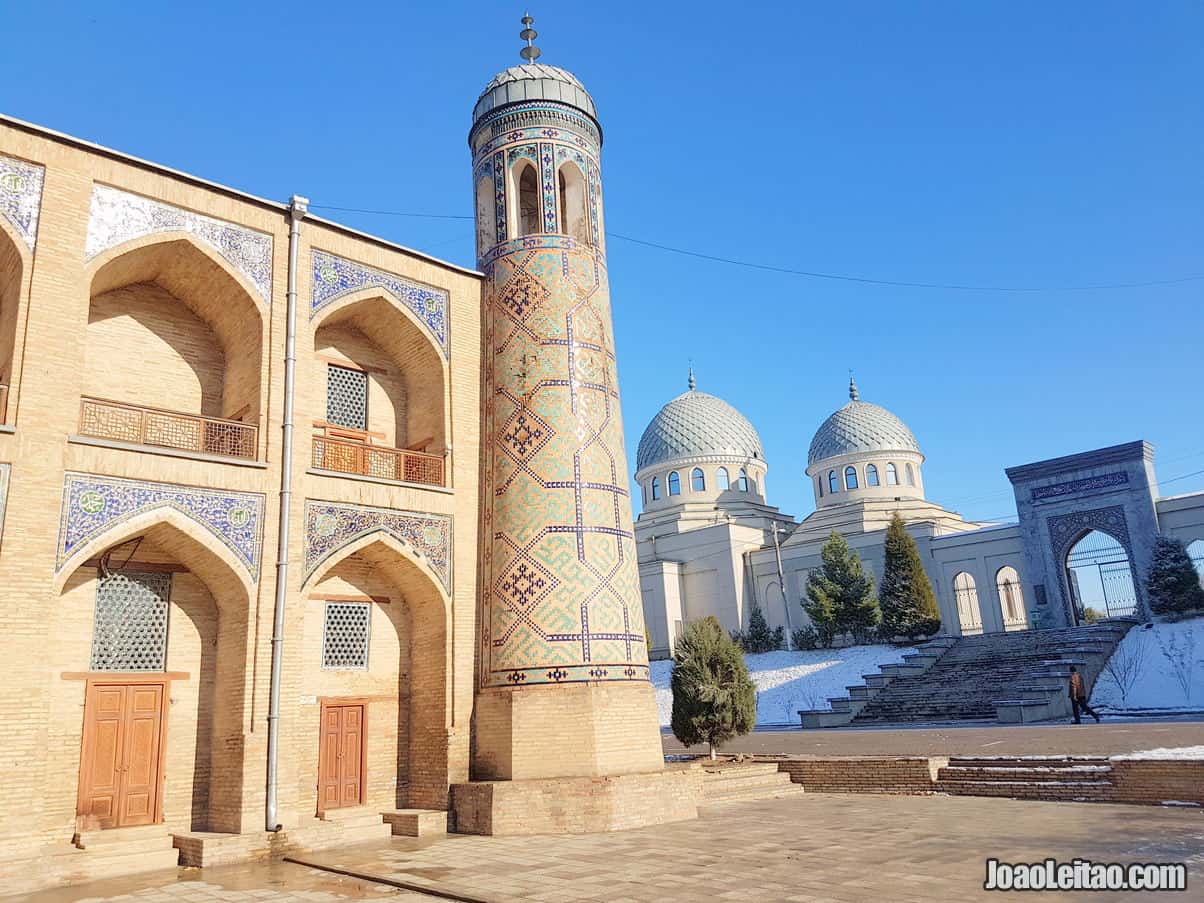
The history of this mosque goes back to the beginning of the 9th century when it was built at the then highest part of the city. It’s been continuously destroyed and rebuilt since that time, renovated and expanded many times. The last intervention was made in 2003 when two domes were added to the mosque.
Minor Mosque
Despite the name, this mosque is worth a visit. It’s also known as the White Mosque because of the white marble used to build it, which contrasts with the blue dome. The mihrab, the niche that marks the direction of Mecca, is highly ornate and very interesting to see.
Don’t be fooled by its classic look because the mosque was actually built in 2014, following the classical Islamic design. It has the capacity for 2,400 people.
Museum of Victims of Political Repression
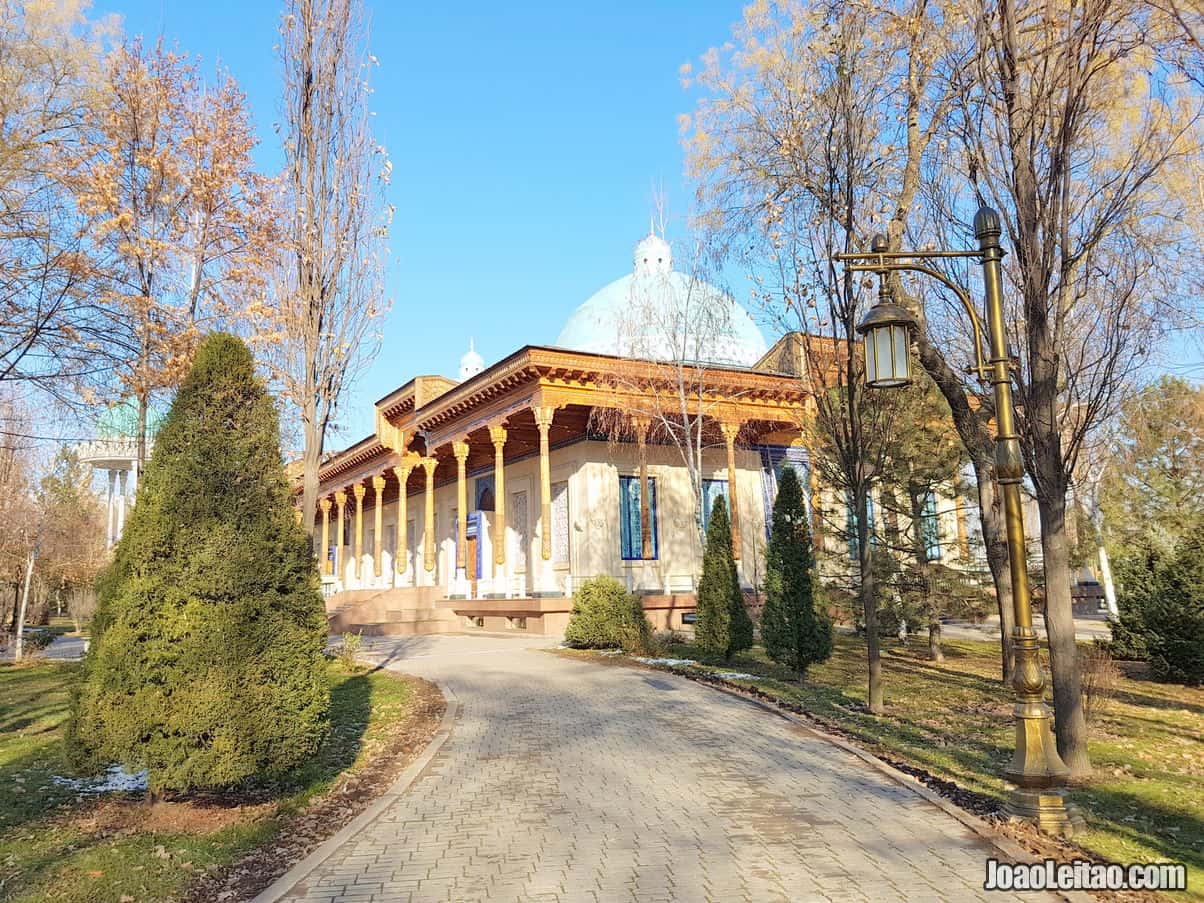
Tashkent Subway
When an earthquake in 1966 destroyed Tashkent, a new city was born. The Soviet urban architects took the opportunity to use the same socialist aesthetic models to build wide boulevards, lots of urban parks, and concrete buildings. They also built a subway system like the ones in Moscow and St. Petersburg, turning each station into a work of art.
Each station is different, with infinite ornaments, tile panels, and grand chandeliers. Just visiting a station is an experience in itself and if you have the time, you should go to as many as possible.
Where to sleep in Tashkent
Tashkent has a wide variety of places to sleep within all possible price ranges.
- For those trying to get a youth hostel, try the well located Trip.LE (Bed in 8-Bed Dormitory Room with breakfast » 8 Euros), the Tashkent Hostel (Bunk Bed in Male Dormitory Room with breakfast » 15 Euros), the Archa Hotel (Single Bed in Dormitory Room with breakfast » 9 Euros) or the Homestay B&B Hostel (Bed in 4-Bed Female Dormitory Room with breakfast » 12 Euros).
- If you want to stay near the famous Chorsu Bazar, Ko’kaldosh Madrasasi, and Dzhuma Mosque and you’re looking for budget accommodation, try the Gulnara Guesthouse (Standard Single Room with Shared Bathroom with breakfast » 18 Euros).
- If your budget is a bit higher try the Aster Hotel Group (Superior Twin Room with breakfast » 83 Euros), the Ichan Qal’a Premium Class Hotel (Deluxe Room with breakfast » 110 Euros).
Spending a day out of the city…
If you’re staying for a few days in Tashkent, take the opportunity to get out of the city for some fresh air.
The Ugam-Chatkal National Park is a one-hour drive from Tashkent and a UNESCO World Heritage Site great for hiking. If you don’t have a car, you can use Chimgan city as your base.
To reach Chimgan, look for a marshrutka going to Gazalkent outside the Buyuk Ipak subway station. The trip will take about 50 minutes and cost 4,000 UZS. When you reach Gazalkent, you’ll have to take a shared taxi to Chimgan. That’s another 40 minutes and at least 6,000 UZS.
If you want to save time and avoid the hassle, a private taxi to Chimgan from Tashkent should cost about 100,000 UZS or around 10 Euros.
Once you reach Chimgan, it shouldn’t be too difficult to find accommodation and your hosts might even arrange for you a car and a driver to explore the region for USD 50 a day.
Visit Samarkand in 3 days
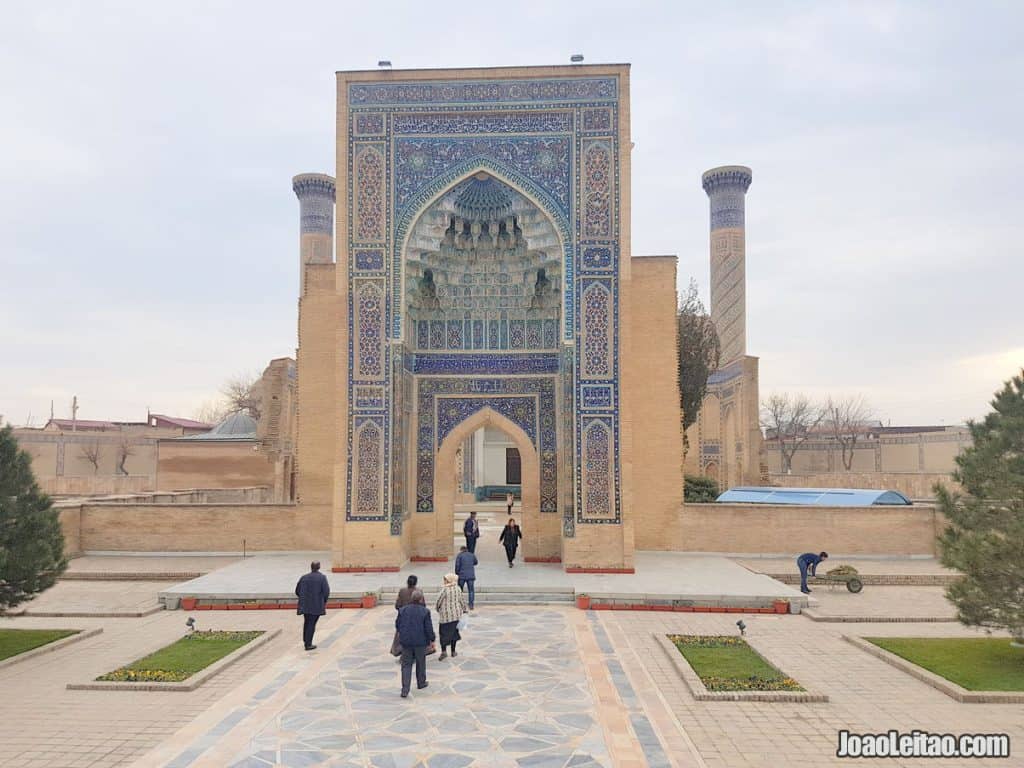
Samarkand is probably the most famous city in Uzbekistan, the place that comes to mind when westerners think about the Silk Road and the mysteries of this part of the world.
It’s the second largest city in the country with half a million people, in the Zerafshan valley about 200 km west of Tashkent.
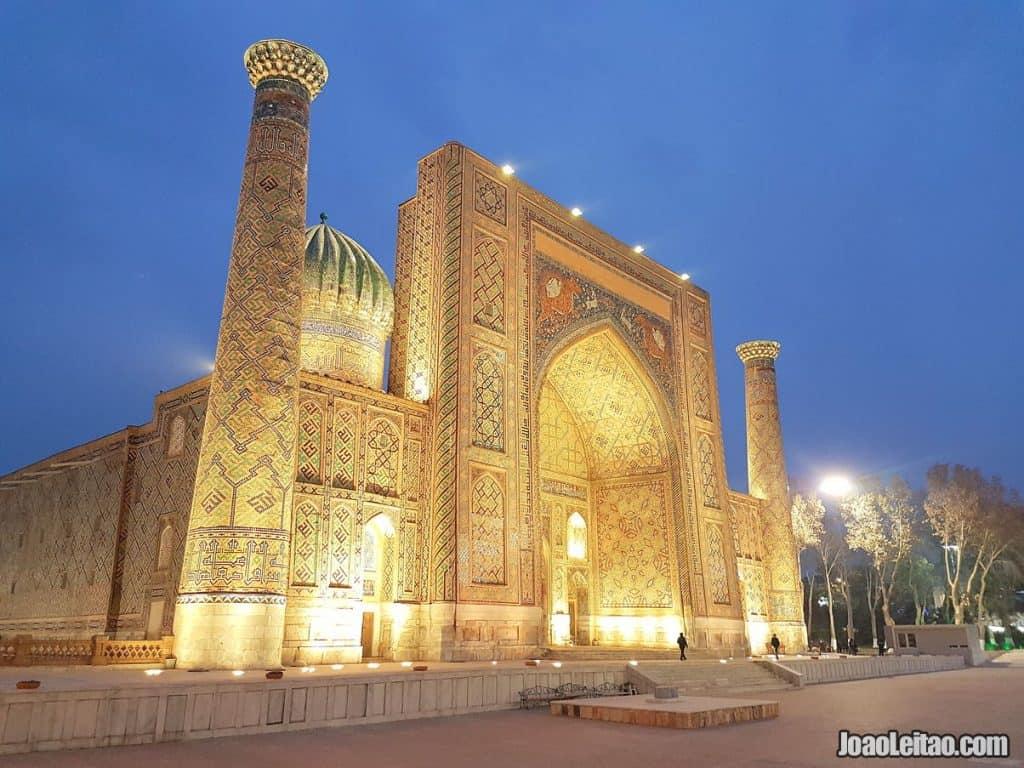
It has a long history, layered with different cultural influences from all the different people that conquered and ruled the city. Macedonians, Arabs, Mongolians, and, perhaps the most determinant for Samarkand’s recent growth, Timur, the Turkish-Mongolian ruler who got here at the end of the 14th century and turned Samarkand into the capital city.
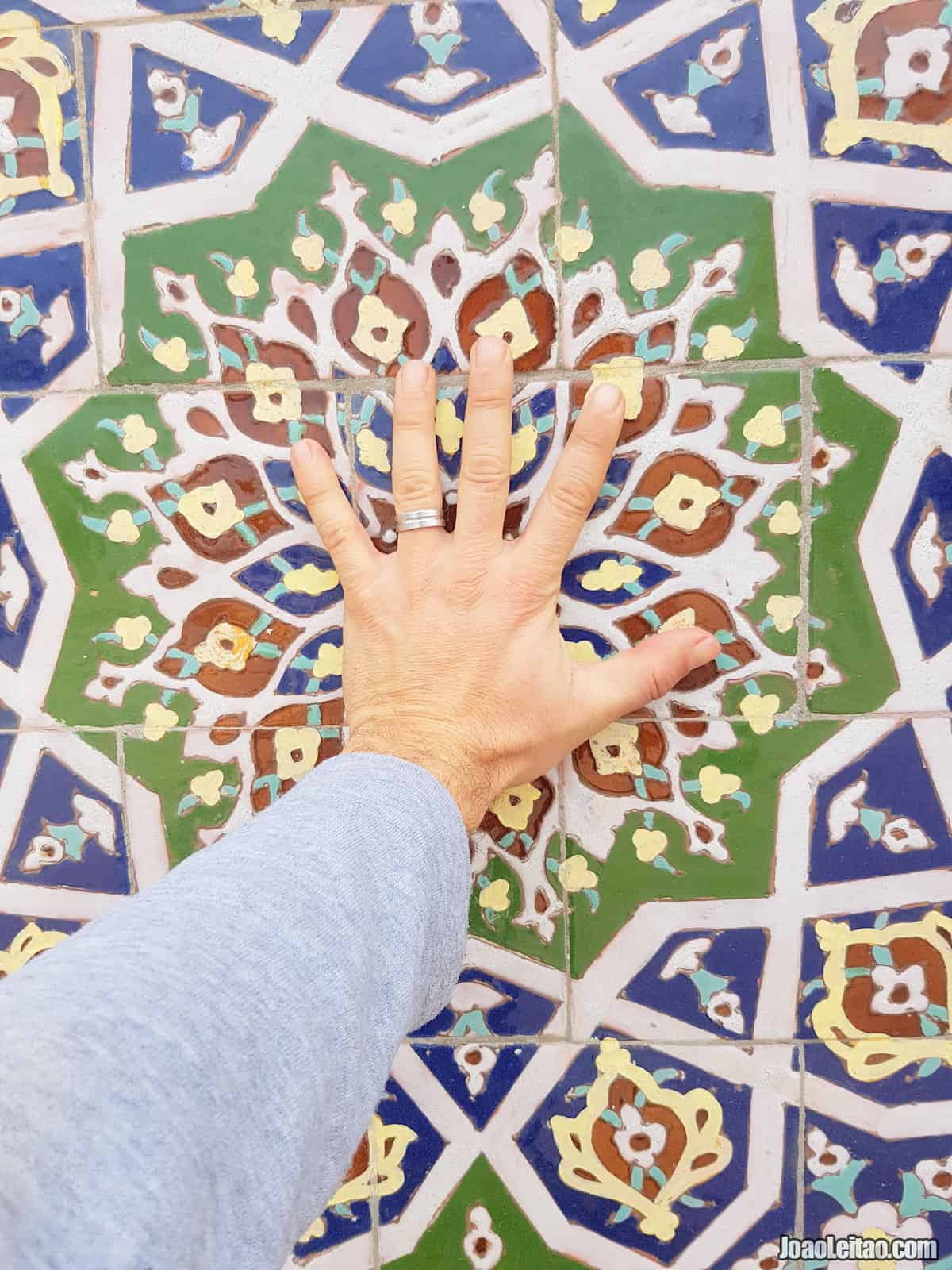
Samarkand was an essential stop on the Silk Road, many times wiped out and many times rebuilt. Its charm granted the city different nicknames created by poets: “The Rome of the East,” “The Pearl of Eastern Islam.” It’s been a UNESCO World Heritage Site since 2001.
Nowadays the city is organized in two major areas: the old part with the grand monuments and charming old mansions, and the modern part built throughout the 20th century by the Soviets, more interesting for those who like to see traces of this era.
How to get to Samarkand
Traveling by train is the fastest and most comfortable way to reach, but there aren’t that many departures and buying tickets is a long, complicated process. The train departs three times a day, at 7:30 am, 8:00 am, and 6:50 pm and the trip takes a little over two hours. From the Tashkent Yuzhnyy station, there are four trains departing every day, at 9:13 am, 7:27 pm, 8:27 pm, and 10:12 pm, but you’ll take almost four hours to reach Samarkand.
Marshrutkas from Tashkent to Samarkand are frequent, and they take four hours to cover the 230 km between both cities.
Uzbekistan Airways flies there too, but not every day. It’s a quick and cheap trip, but considering all that’s involved in air traveling, it’s probably easier to take the train.
Things to do in Samarkand
Map with the most famous Samarkand tourist places.
- Registan Square
- Shakhi-Zinda Necropolis
- Gur-Emir Mausoleum
- Bibi Hanim Mosque
- Ulugh Beg Observatory
- Madrasa Ulugh Beg
- Madrasa Tilya Kori
- Rukhobod Mausoleum
- Madrasa Sherdar
- Ishratkhana Mausoleum
- Hazrat-Hizr Mosque
Samarkand sights & tourist attractions
Registan Square
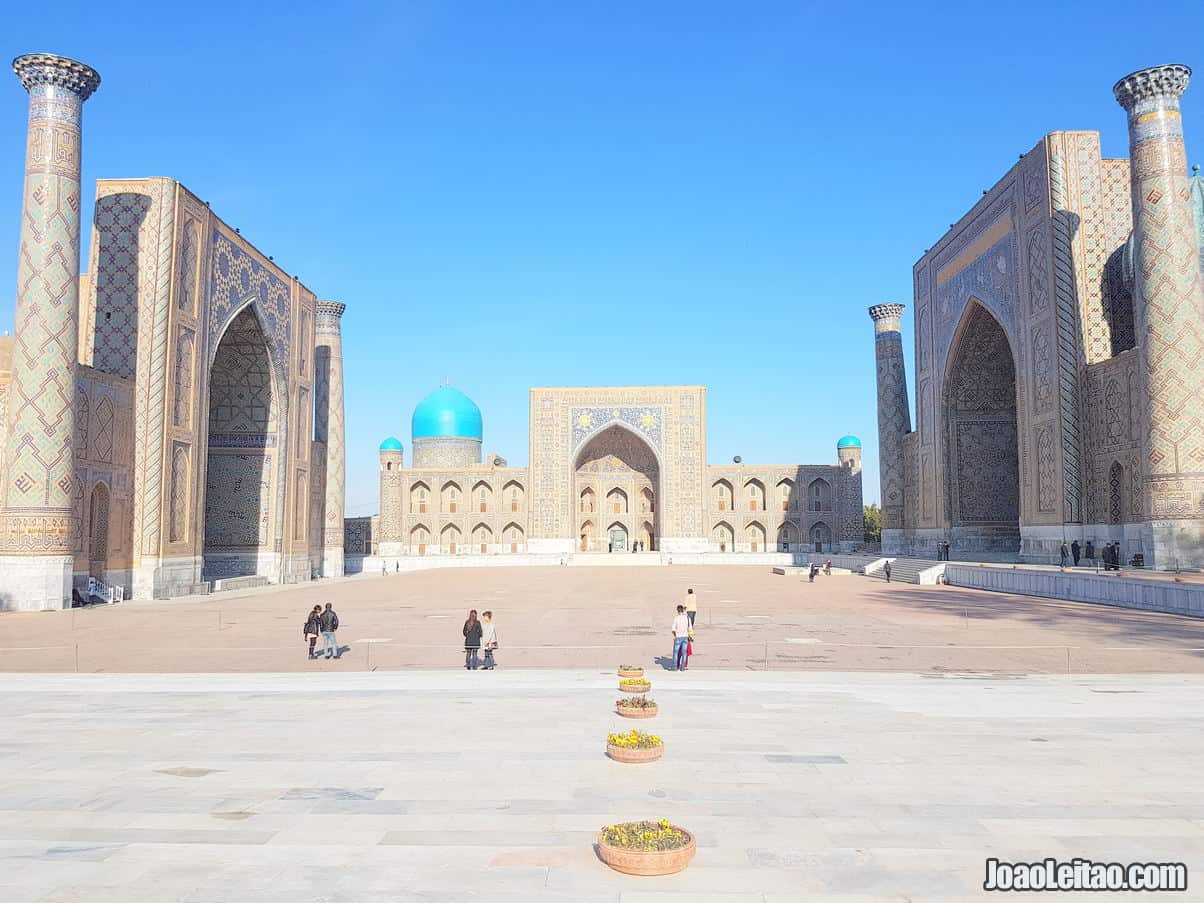
Registan is Samarkand’s main square, the heart of monumental architecture of the Timur era, and its most iconic place.
The main market of the city was here during medieval times, and this was the area chosen to build the city’s most monumental work, the one that would transform and mark Samarkand forever.
The main buildings of the complex are the three madrasas: Ulugbek, the first, finished in 1420, followed by Sher Dor and Tilla-Kari, the last one, built in 1640.
Weather and constant earthquakes damaged the structures over time, and at the beginning of the 20th century, they weren’t much more than ruins. The Soviet authorities invested in renovating the complex, an ambitious project that went on for most of the century.
Gur-e-Amir Mausoleum
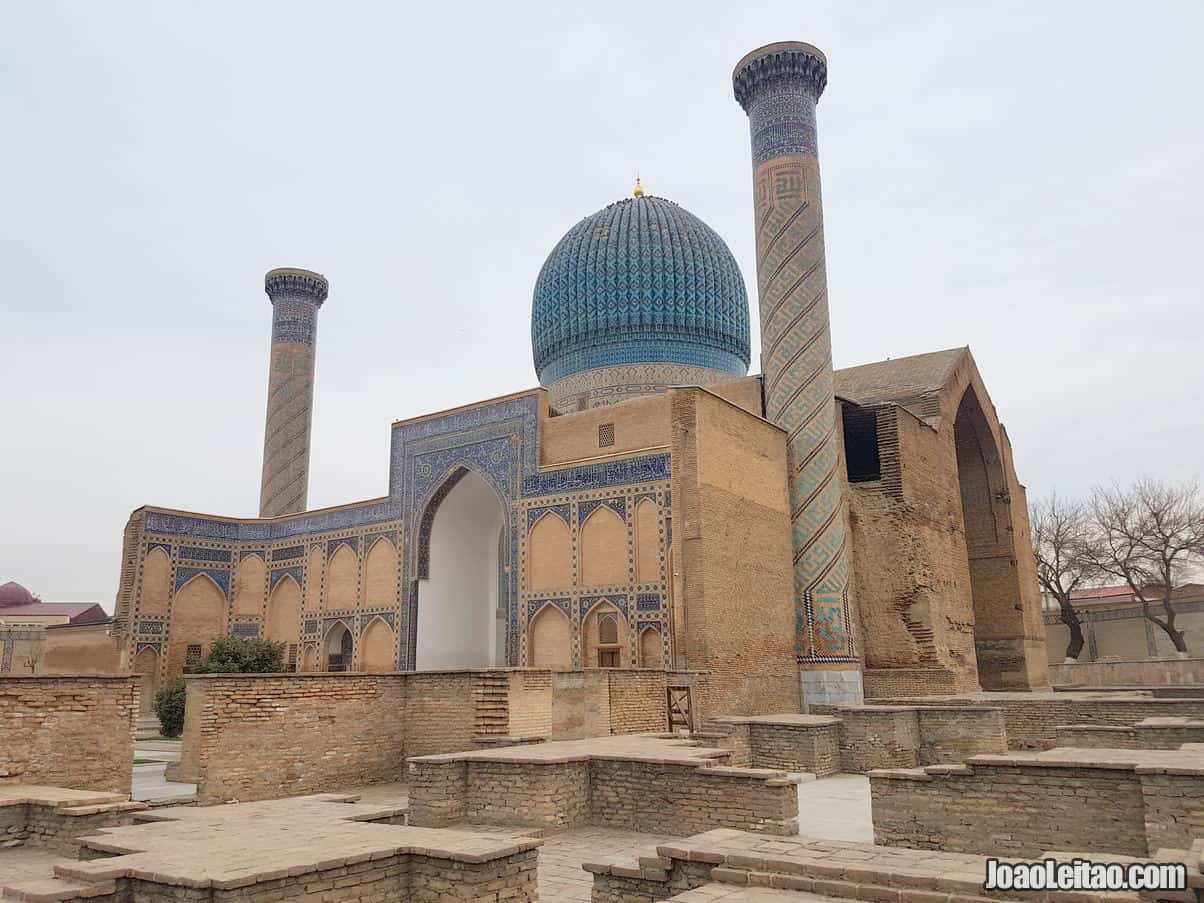
This monumental mausoleum houses the remains of Timur, two of his sons, and two of his grandsons, including Ulugbek who was responsible for one of the madrasas at Registan.
Most people are surprised that such a modest-looking mausoleum marks the grave of such a powerful ruler as Timur. In fact, his body wasn’t supposed to be here. He had prepared a crypt for himself in Shakhrisabz, but Timur died unexpectedly, allegedly of pneumonia, when he was in Kazakhstan preparing to invade China. That year, 1405, the harsh winter made reaching Shakhrisabz impossible. Therefore, they decided to bury him in this mausoleum, which had been built one year earlier for his descendants when the time came.
Fun fact: when Soviet archaeologist M. Kayumov opened the crypt in 1941, he realized Timur was a tall man for his time, 1.70 m tall. He also noticed he had a disability on the right leg and arm, probably due to war wounds, and that Ulugbek had been decapitated. Inside the crypt, he found an inscription that read “he who violates this space will have to face an enemy worse than myself.” That was on 21 June 1941. The next day, Hitler’s armies invaded the USSR.
Bibi Hanim Mosque
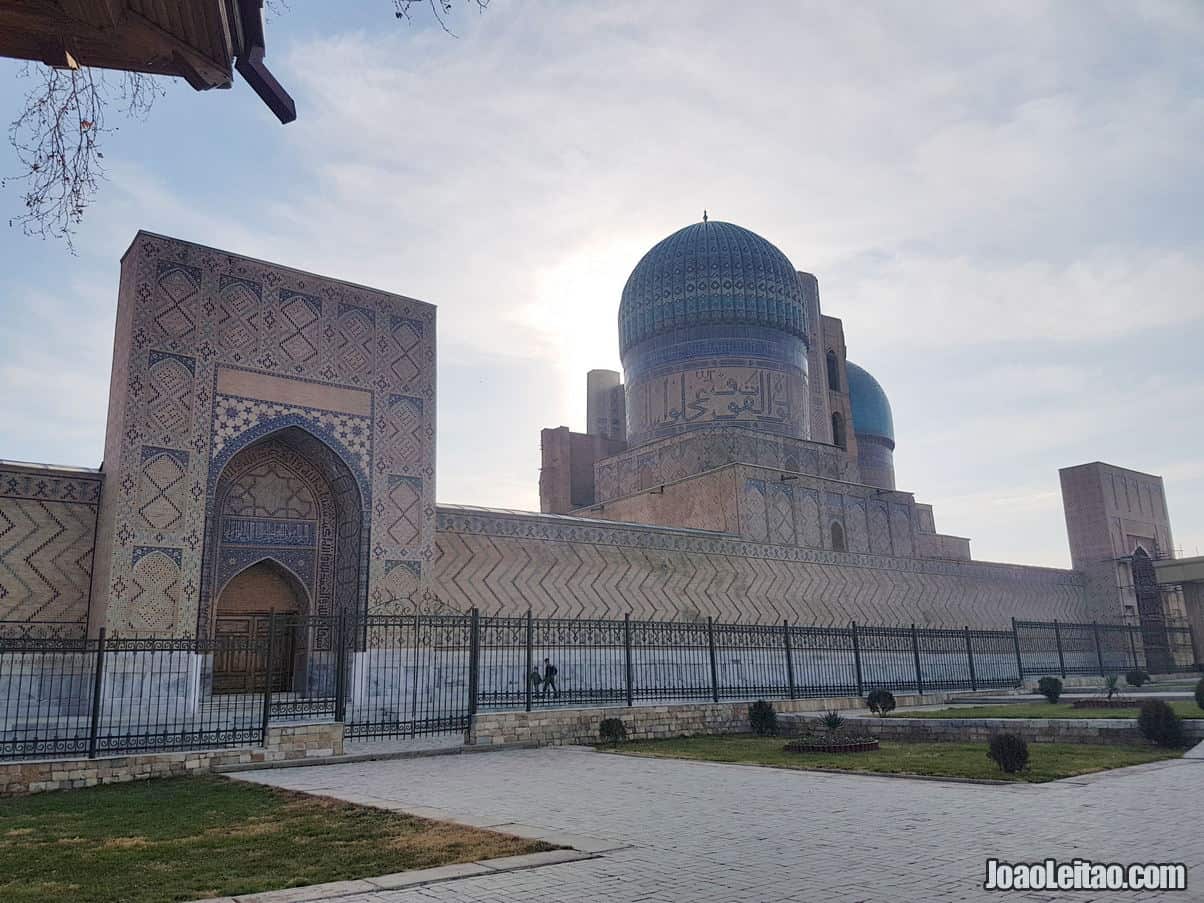
This mosque was built during the Timur age, between 1399 and 1404, funded by what he brought back from India after the invasion. It was once the biggest mosques in the world, with its 41-meter high blue dome and an entranceway slightly lower than that.
At the time it was built, it probably was big enough to accommodate all men in Samarkand, who gathered there on Fridays. But the size of the mosque was a strain for the structure, and shortly after it was built, part of it collapsed.
After that, an earthquake in 1897 damaged the mosque, and it was practically in ruins for a large part of the 20th century. It was restored in the 1970s, finishing construction work after the independence of Uzbekistan.
Shah-i-Zinda Necropolis
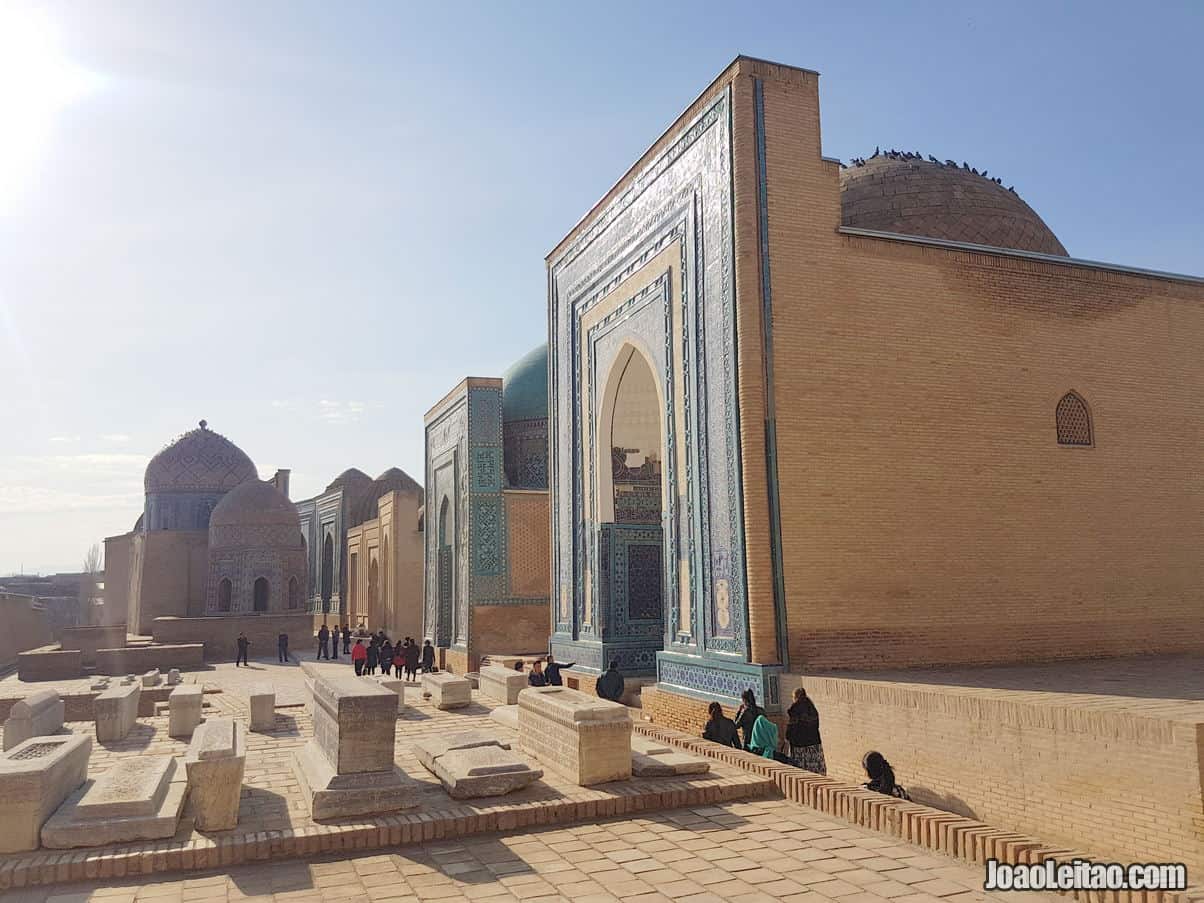
The name translates into “Tomb of the Living King,” and it’s where most of Uzbekistan’s kings and other prominent figures are buried.
The tomb believed to be of Qusam ibn-Abbas is the center of the complex. He was the cousin of prophet Mohammed, who brought Islam to this region in the 6th century.
Here you’ll see the most fascinating mosaic work, like the one in the mid-14th-century tomb of Shodi Mulk Oko. The finish was so great that it hardly needed any renovation work until the present time.
The same can’t be said of other parts of the complex that underwent renovation work in 2005. Must-sees include the ruins of the old 15th-century baths outside Shah-i-Zinda and the cemetery of Samarkand behind the complex if you’re interested in these kinds of sites.
Ulugbek Observatory
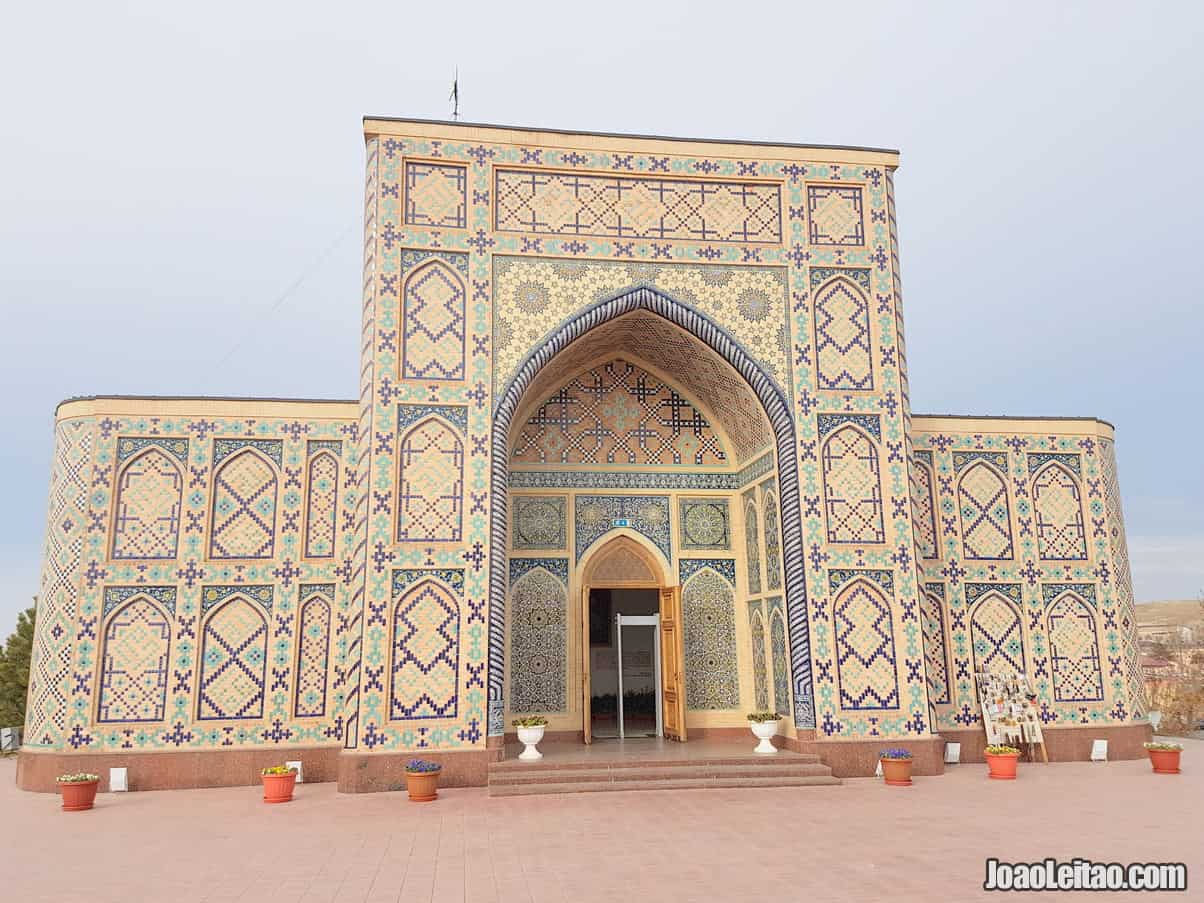
This old astronomy observatory built in the 15th century was discovered by accident in 1908 when archaeologists excavating the area found this surprising site.
King Ulugbek, the grandson of Timur, was more of an astronomer than a ruler and this observatory, finished in 1420, was his dearest work.
The building was 30 meters tall, with three floors and a central hall full of instruments to observe the stars.
Nowadays there’s a small museum onsite dedicated to the Observatory, where the main highlight is a world map made there in 1605.
The observatory is a bit further from the city center, but you can get there by taking bus number 45 or bus number 99.
Gumbaz Synagogue
This synagogue is at a discreet location in the historic center of Samarkand. Built in 1891, it’s still in use by the small Jewish community in the city. Travelers are welcomed to visit but odds to find it closed are high. It’s best to ask someone to call ahead and book a tour. Try phone number +998 91 552 7268.
Siaab Bazaar
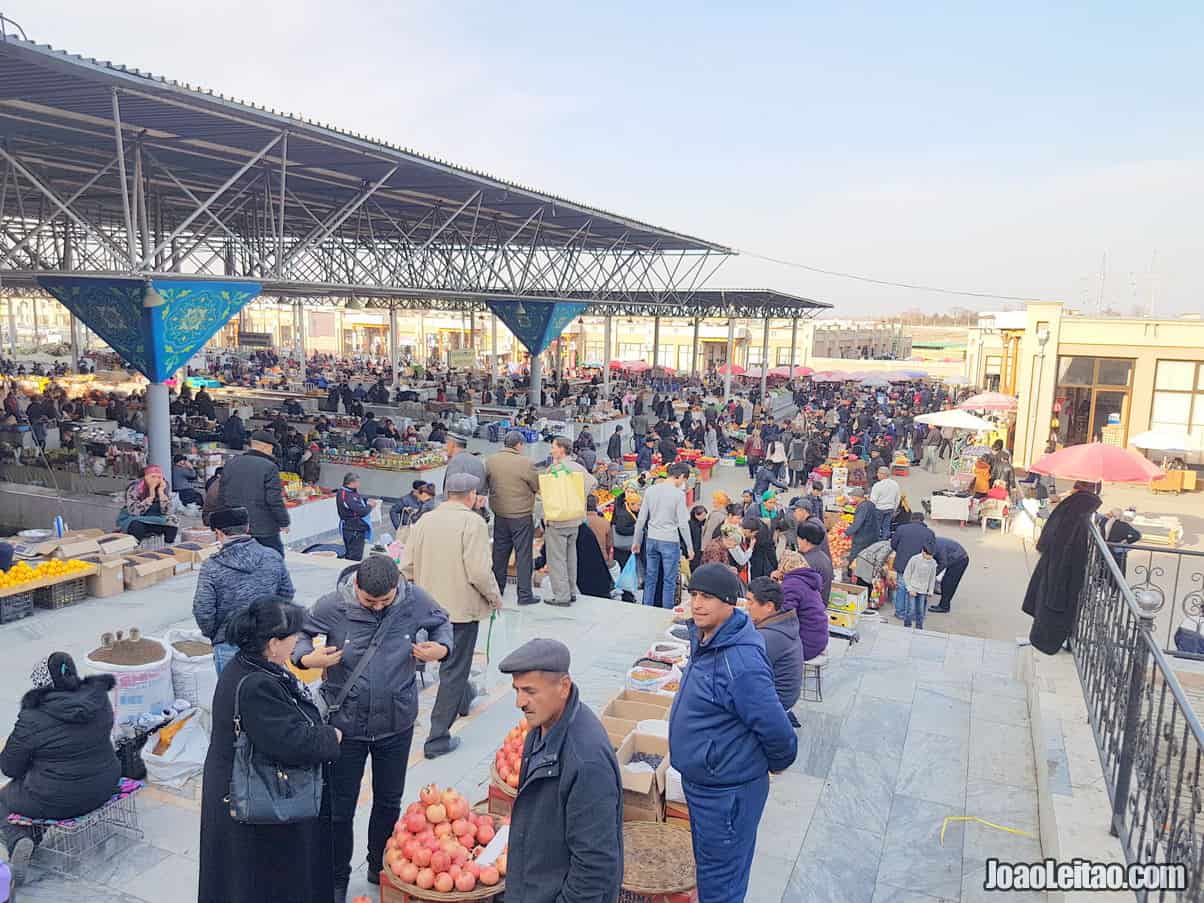
Any traditional market in Central Asia is worth a visit and the Siaab Bazaar in Samarkand is a must-see. Located between the Bibi Hanim mosque and Shokhi Zinda, it’s a place that evokes the old Silk Road.
For centuries, this was the community’s gathering place where people socialized and caught up with each other. Nowadays things are a bit different. Trade happens inside pavilions, but the ever-present scents and colors will always be the market’s calling card.
Here you can buy dry fruits, spices, vegetables, and traditional loaves of bread. There’s a restaurant serving typical Uzbekistan dishes, some of them prepared over an open fire. If you’re not too hungry, you can try green tea and do some people watching.
State Museum of Historical Culture
Founded in 1896, it’s one of the country’s oldest museums. The vast and interesting collection includes interesting pieces such as the film made by archaeologist M. Kayumov the day he opened Timur’s tomb, which incidentally was the day before the Nazi army invaded his country. Also, look for the 5th-century silver bowls taken from the Chelek archaeological site and the 19th-century globe made by Khodja Yusuf Mirfayazov.
The collection is organized in different areas for archaeology, ethnography, applied arts, and coins, but the museum also showcases pieces of other areas like the works of contemporary Uzbek painters.
For many years the museum was near the Registan, but it’s now at Ulugbek Street, where it reopened in 2014. It’s open every day, from 9:00 am to 5:00 pm.
Where to sleep in Samarkand
Samarkand has a wide variety of places to sleep within all possible price ranges. All my options are taking into consideration the proximity of the famous Registan Square.
- For those trying to get a youth hostel, try the well located B&B Bahodir (Bed in 5-Bed Dormitory Room with breakfast » 10 Euros / Standard Single Room with breakfast » 13 Euros), the B&B Emir (Bed in 6-Bed Mixed Dormitory Room with breakfast » 11 Euros).
- If you’re looking for mid-budget accommodation, try the Fayz Guest House (Double or Twin Room with Bathroom with breakfast » 19 Euros), the Timur The Great (Single Room with breakfast » 22 Euros), or the Muzaffar Hotel Samarkand (Deluxe Double or Twin Room with Balcony with breakfast » 25 Euros).
- If your budget is a bit higher try the Rabat Boutique Hotel (Twin Room with Bathroom with breakfast » 46 Euros), the Tilyakori Hotel (Deluxe Double Room with breakfast » 38 Euros).
Bukhara (2 days)
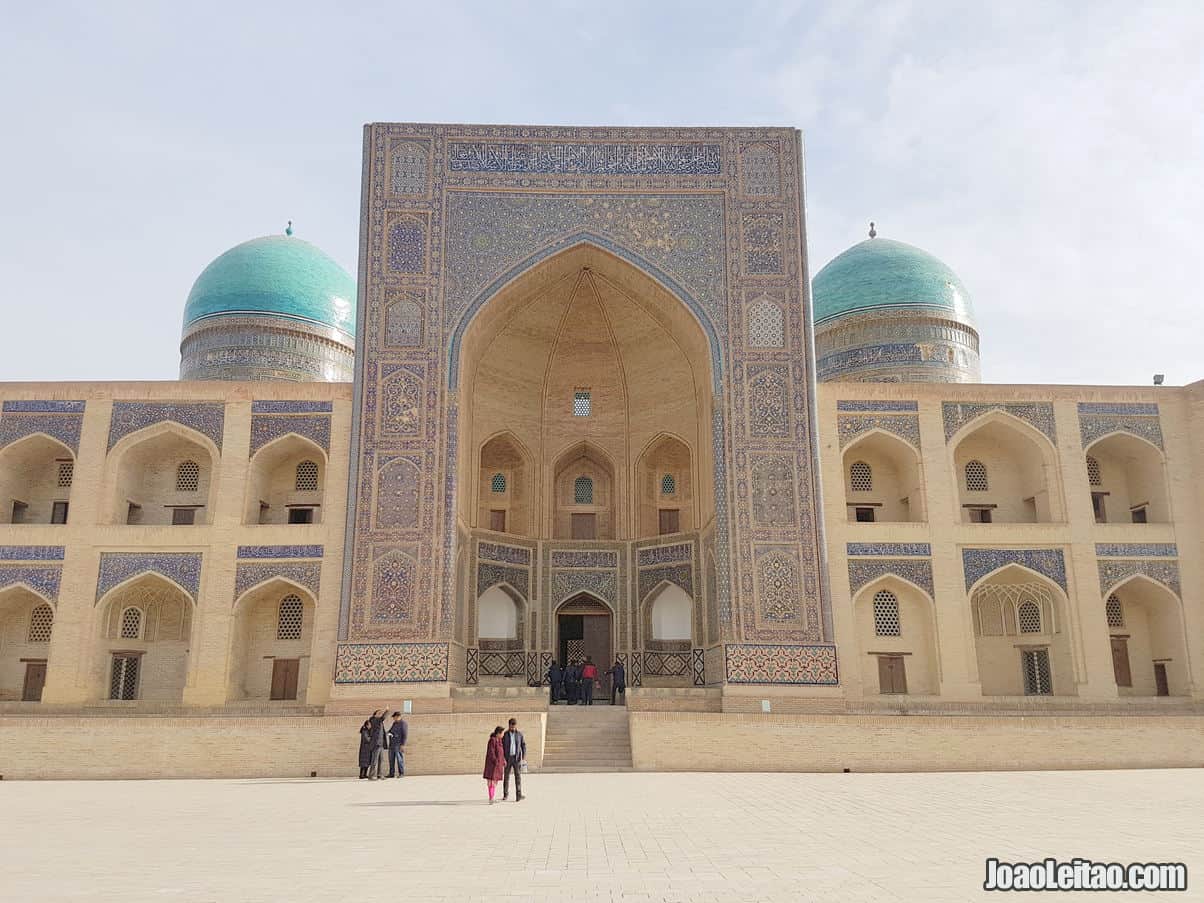
Bukhara is one of the most sacred cities in Central Asia, and its streets are full of buildings over one thousand years old. In fact, all of the city’s historic center is like an open-air museum, depicting a past built in layers, each one of them created by an invader with a different cultural identity.
In Bukhara you’ll notice traces of Persian, Mongolian, and Russian influences, not to mention the marks of the recent Soviet past.
It’s no surprise that the historic center of Bukhara became a UNESCO World Heritage Site in 1993.
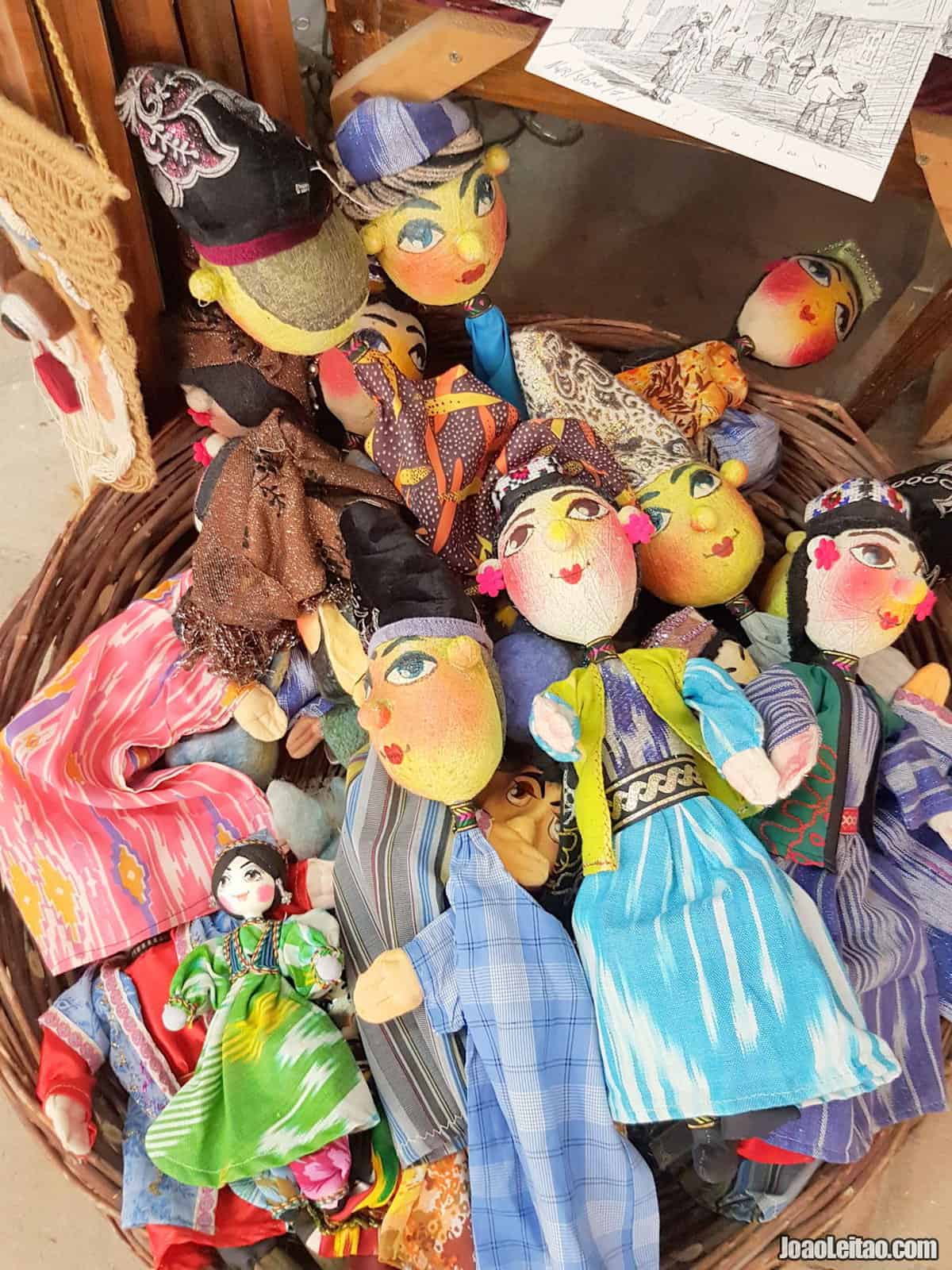
The main points of interest include mosques, madrasas, and caravanserais, but perhaps the best thing to do is to wander the streets and alleys of the old city, where locals live a quiet life.
Bukhara is close to the border with Turkmenistan, and therefore a usual entry or exit point for travelers who include that country in their Central Asia itinerary. Traveling through Nukus is the other alternative.
Getting There
Bukhara is 300 km away from Samarkand. You can choose to travel between both cities by train, bus, or marshrutka.
There are five daily trains leaving at 9:48 am, 12:29 pm, 8:58 pm, 12:13 am, and 2:00 am, that arrive, respectively, at 11:19 am, 3:09 pm, 10:39 pm, 3:42 am, and 6:37 am.
A train leaving at 2:00 am might seems odd but it departs from Tashkent one hour earlier, not from Samarkand.
The 12:13 am train only works on Tuesdays, Wednesdays, Fridays, and Sundays.
- Check prices and schedules on the official website of Uzbekistan’s railway company.
By road, the trip from Samarkand to Bukhara will take about four hours, and you’ll pay 30,000 UZS for a bus ticket, maybe a bit more. You’ll arrive at the Central Station, at Gijduvon street, on the north side of Bukhara.null
Things to do in Bukhara
Map with the most famous Bukhara tourist places.
- Kalon Minaret
- Citadel Ark
- Char Minaret
- Labi-Hauz Square
- Mausoleum Ismoil Somoni
- Madrasa Kukeldash
- Taqi Sarrafon Bazaar
- Taqi-Telpak Furshon Bazaar
- Taqi-Zaragon Bazaar
- Maghori Atta Mosque
- House Museum of Faizullah Khojaev
- Garden Sitorai Mohi Hosa
- Bakhautdin Naqshband Mausoleum
- Chor-Bakr Necropolis
Bukhara sights & tourist attractions
Bukhara Ark
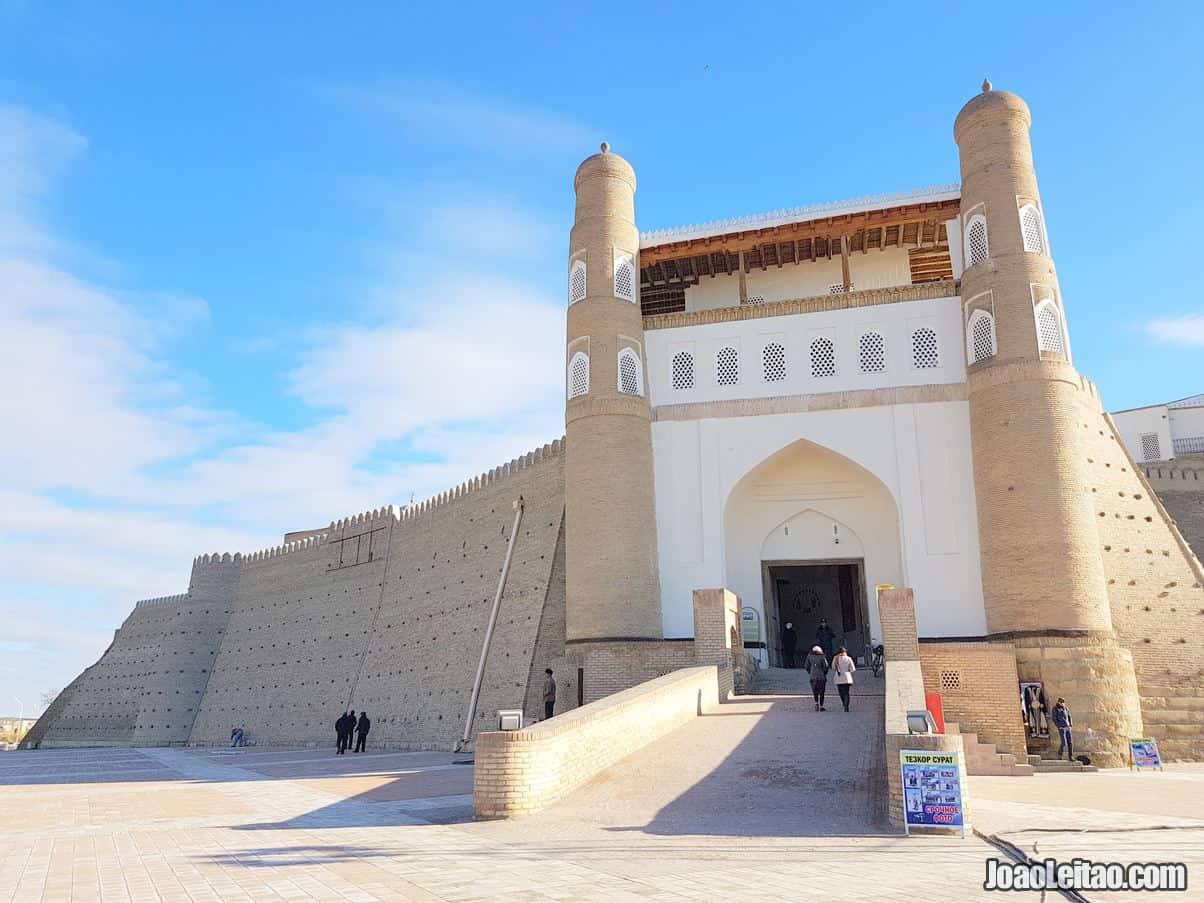
This palace in the middle of Bukhara’s center was built in the 5th century and continuously inhabited until 1920, when the Red Army attacked it. It never recovered from that bombing, and what you’ll see are the ruins of a bygone golden era, when the palace was the official residence of the emirs of Bukhara. At that time, it was like a city inside the city, with mansions, temples, military barracks, offices, a coining factory, warehouses, workshops, an arsenal, and a prison.
It’s partially open to the public, from 9:00 am to 6:00 pm. Offices occupy a large portion of the palace, but travelers can visit the museum and the outdoor areas with several educational panels written in English.
Nughai Caravanserai
This is an excellent example of an urban caravanserai, that played an essential role in travelers’ routines and trade, the cornerstone of the Silk Road. The countryside caravanserais that you see in Central Asia were mainly used by merchants to spend the night. The ones in the city, however, were more complex and the equivalent of today’s hotels.
Nughai, strategically located near the Taqi-Sarrafon Bazaar, is from the 16th century and was built when Khan Muhammad Rahimbiy was king.
The one-floor building has 45 bedrooms, kitchens, rooms for servants, and other support areas. This caravanserai could accommodate about 30 merchants and their entourage, offering them shelter, food, and a place to do business.
Nowadays it’s been turned into a handicrafts area.
Char Minar
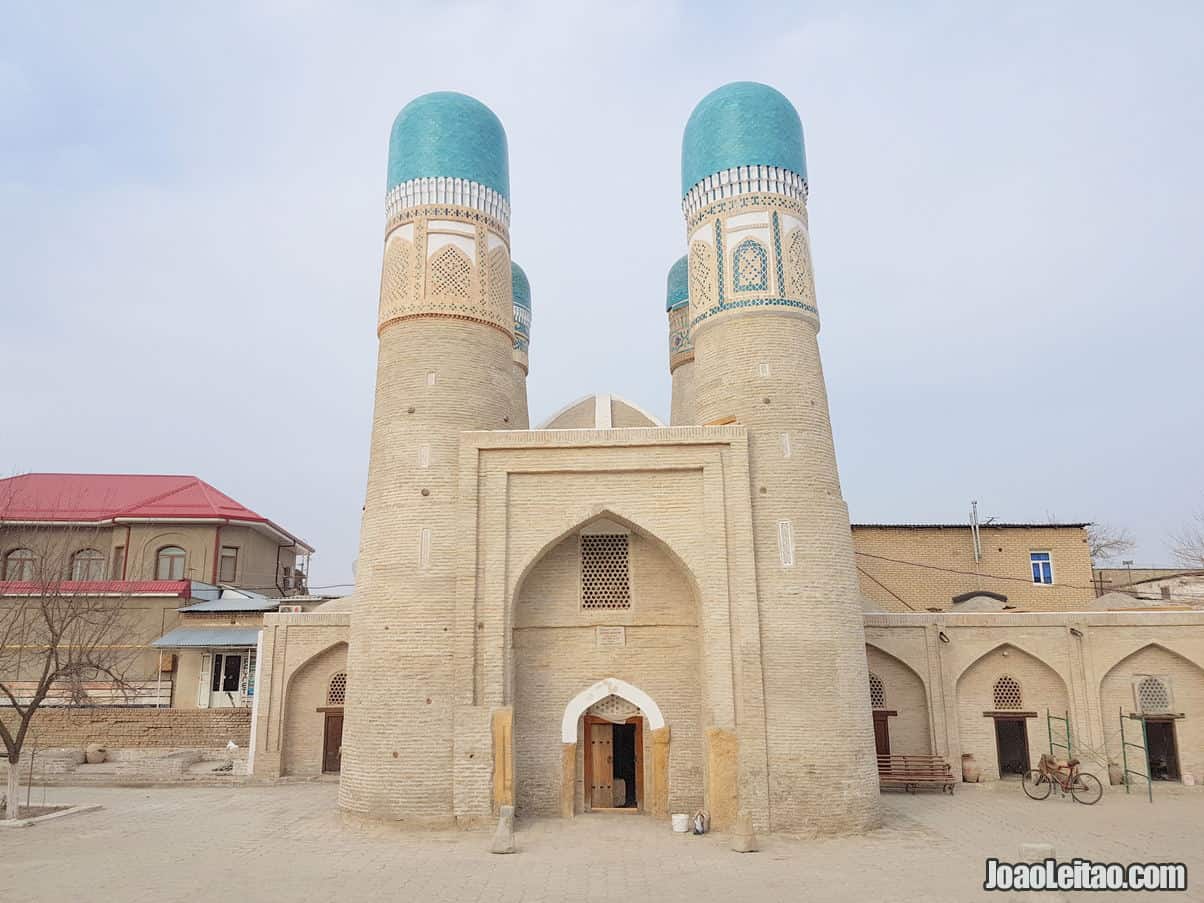
In Tajik the name means “the four minarets,” but that’s just a figure of speech because the structures we see there today were never really minarets, but the decorating towers of a madrasa that used to be there. That religious school was built in 1807, perhaps to replace another one according to historical documents that speak of a madrasa in that place at the end of the 17th century.
The four towers have different patterns that perhaps represent the harmony between the four main religions in the world.
The streets around it are also worth a visit. The maze-like narrow streets resemble the Indian ones, something you won’t see elsewhere in the city.
For a small amount, travelers can go up to the top of the madrasa and take a closer look at the towers.
Labi-Hauz Ensemble
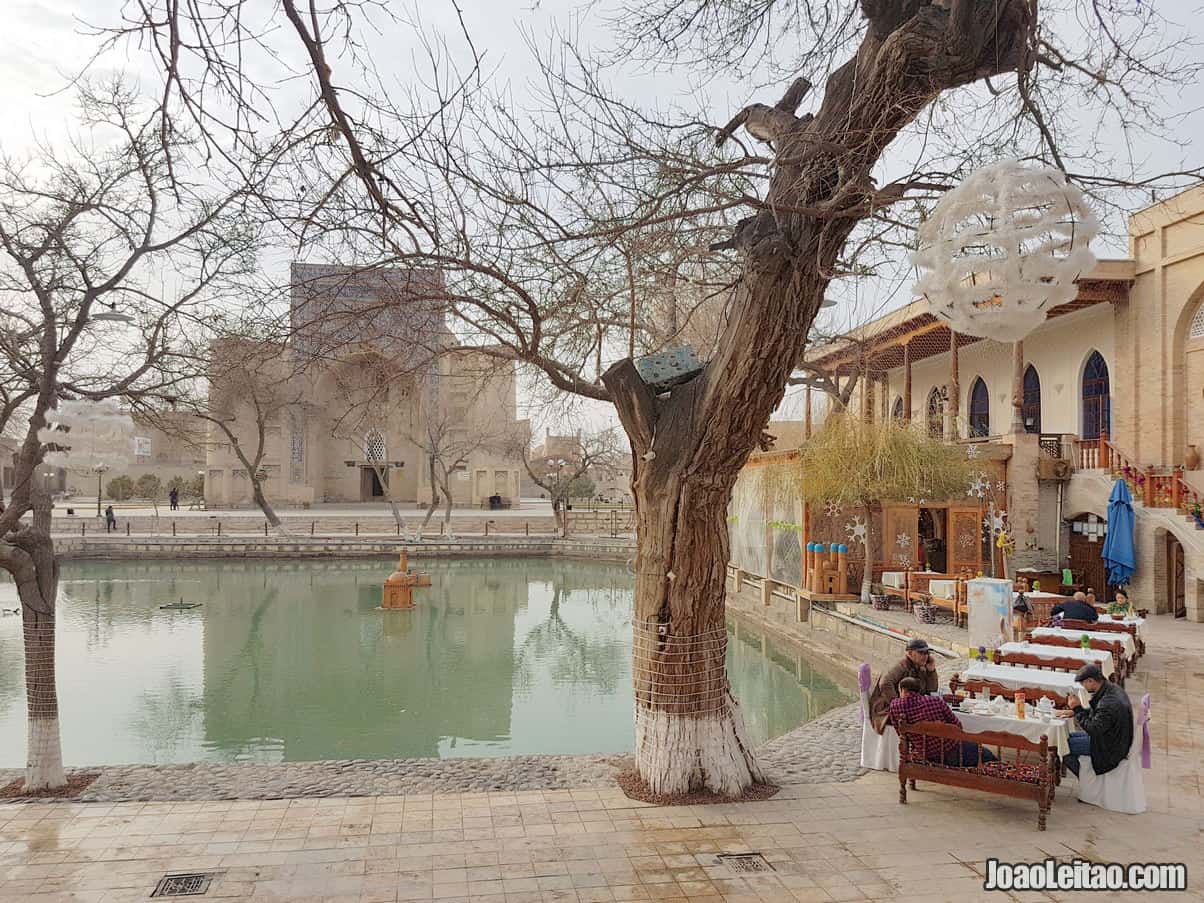
Maghok-i-Attar
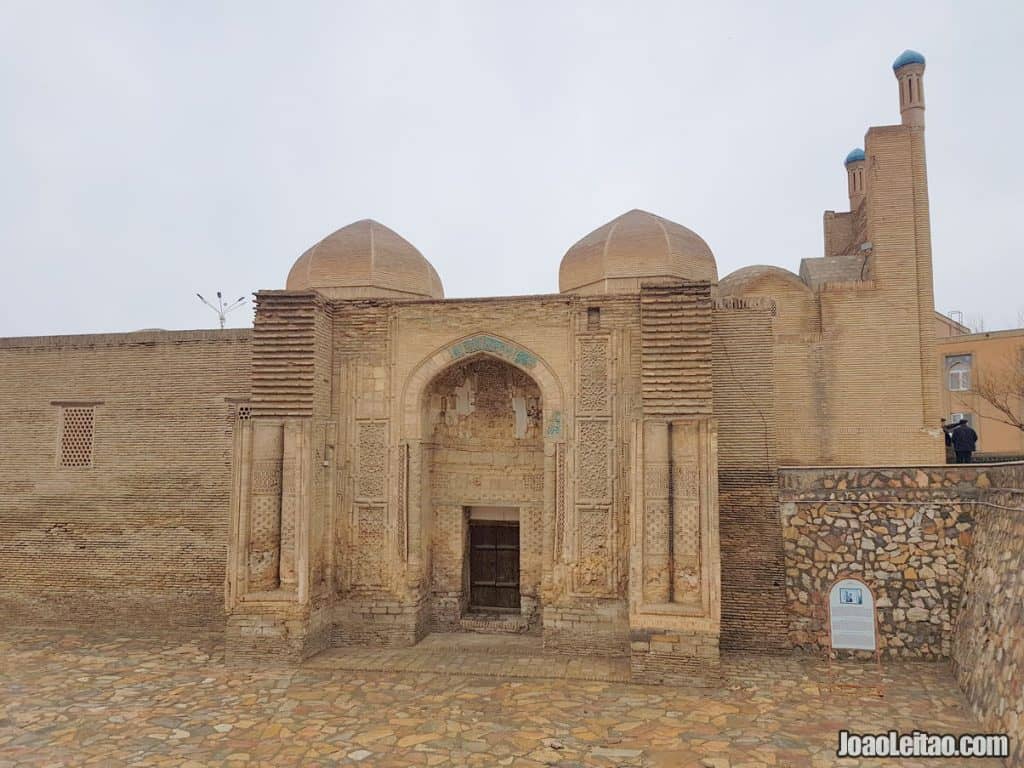
Maghok-i-Attar is a tapestry museum showcasing Solor and Ersari Turkmen pieces, but the most exciting part of the exhibition is probably the History and the architecture of the building. It’s the oldest mosque in Uzbekistan, built originally in the 9th century and renovated in the 16th century.
For reasons unknown, the location seems to have been one of spiritual significance, since traces of a Buddhist temple and Zoroastrian temples were found there. There are signs that some Zoroastrian practices still take place there.
Legend has it that the mosque survived the Mongolians because locals buried it in the sand. In fact, when it was found in 1930, only the top showed.
Another story says that until the 16th century the Jewish people of Bukhara were allowed to use the mosque as a synagogue in the evenings.
If you’re intrigued by the ruins around the building, they used to be a public bath complex and a caravanserai.
Faizullah Khojaev House Museum
Built in 1892, this was the house of Fayzulla Khojaev and his family. Who was Fayzulla Khojaev? He was a wealthy merchant who collaborated with the Soviets to depose Alim Khan, hence becoming an important figure in the new Soviet Republic. Until Stalin had him executed in 1938, that is.
Fayzulla Khojaev lived here until 1925 when the house became a school. You can visit from 9:00 am to 5:00 pm, Friday to Tuesday, and to 3:00 pm on Thursday.
Kalon Minaret
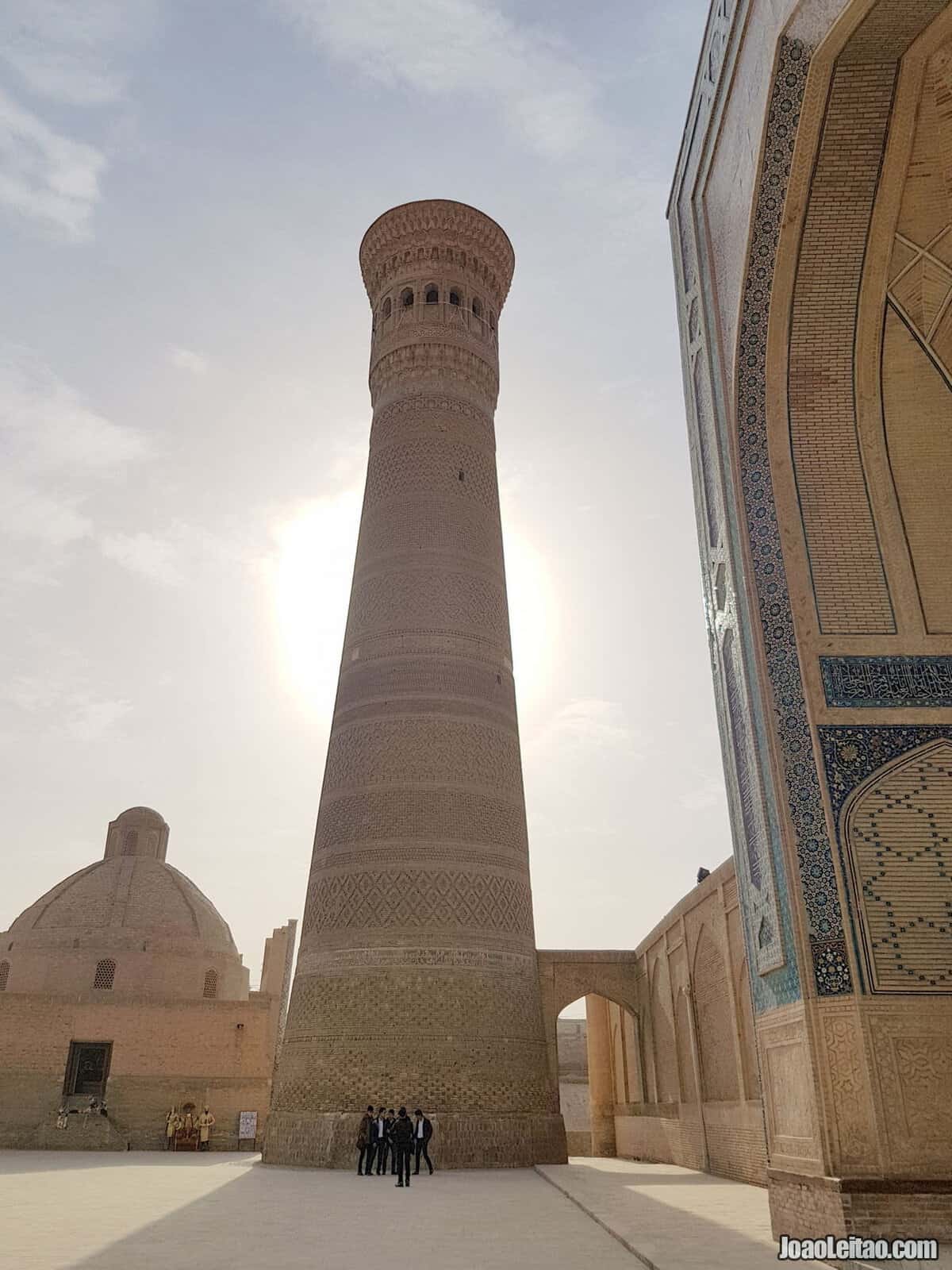
This minaret was built in 1127 when Arslan Khan was king, and at that time was the tallest structure in Central Asia.
It’s 47 meters high, above ground, and has 10 meters deep foundations.
Legend has it that Genghis Khan was so impressed by it that he ordered his men to keep it intact while the rest of the city was wiped out. In 1920 the Red Army, however, wasn’t as fascinated and, following the orders of General Frunze, opened fire damaging the minaret completely.
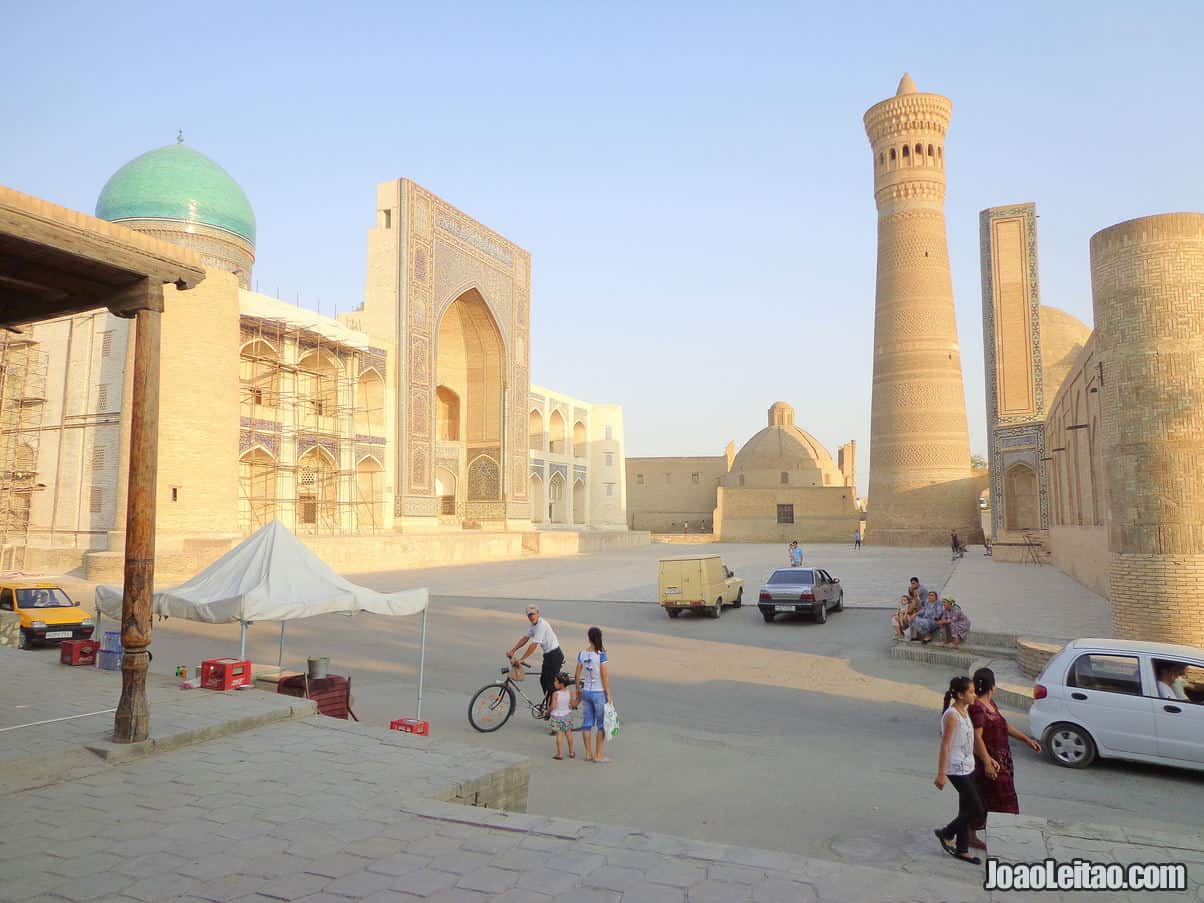
Despite the violent past, it’s now impeccably restored, showing its rich ornaments that include the first blue mosaics that would later cover all important monuments in Central Asia.
Unfortunately, visitors can no longer climb the 105 steps inside the minaret.
Jewish Cemetery
If you enjoy these kinds of sites, you won’t want to miss the Jewish Cemetery, a symbol of a former large community that these days probably doesn’t have more than 50 people.
It’s well-kept and not too far from the synagogue, covering a vast area that includes tombs from different centuries.
Ismail Samani Mausoleum
This small mausoleum was built to house the remains of Ismail Samani, the founder of the Samanid dynasty, and the remains of his father and his grandson Hasr.
The construction ended in 905, meaning this is the oldest Islamic building in the city. Remarkably, only the dome needed to be restored since then.
The semi-spherical dome is placed over the main area of the cube-shaped building. The outer walls are decorated with geometrical patterns.
Taqi-Sarrafon Market
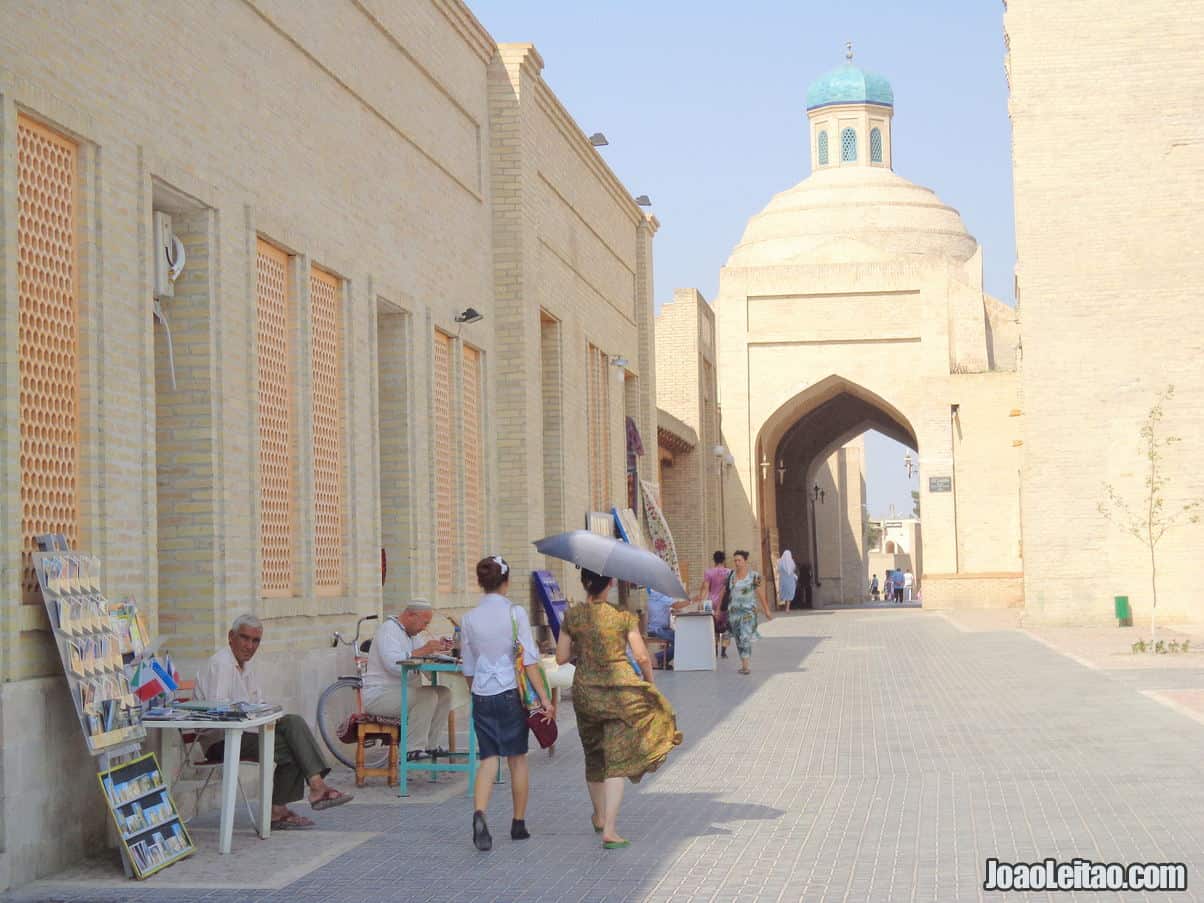
Where to sleep in Bukhara
Bukhara has a wide variety of places to sleep within all possible price ranges. All my options are taking into consideration the proximity of the Labi-Hauz square.
- For those trying to get a youth hostel, try the Bobo Haydar Guest House (Bed in 6-Bed Dormitory Room with breakfast » 9 Euros), and the Diyor Hostel (Deluxe Double Studio with breakfast » 18 Euros).
- If you’re looking for mid-budget accommodation, try the Amir-Yaxyo Hotel (Budget Single Room with Bathroom with breakfast » 16 Euros), the Hotel Khurjin (Budget Single Room with breakfast » 22 Euros), or the Umarxon (Large Double or Twin Room with breakfast » 18 Euros).
- If your budget is a bit higher try the Chor Minor Hotel (Comfort Twin Room with breakfast » 57 Euros), the Hotel Fatima Boutique (Superior Twin Room with Bath with breakfast » 46 Euros).
Urgench (1 Day)
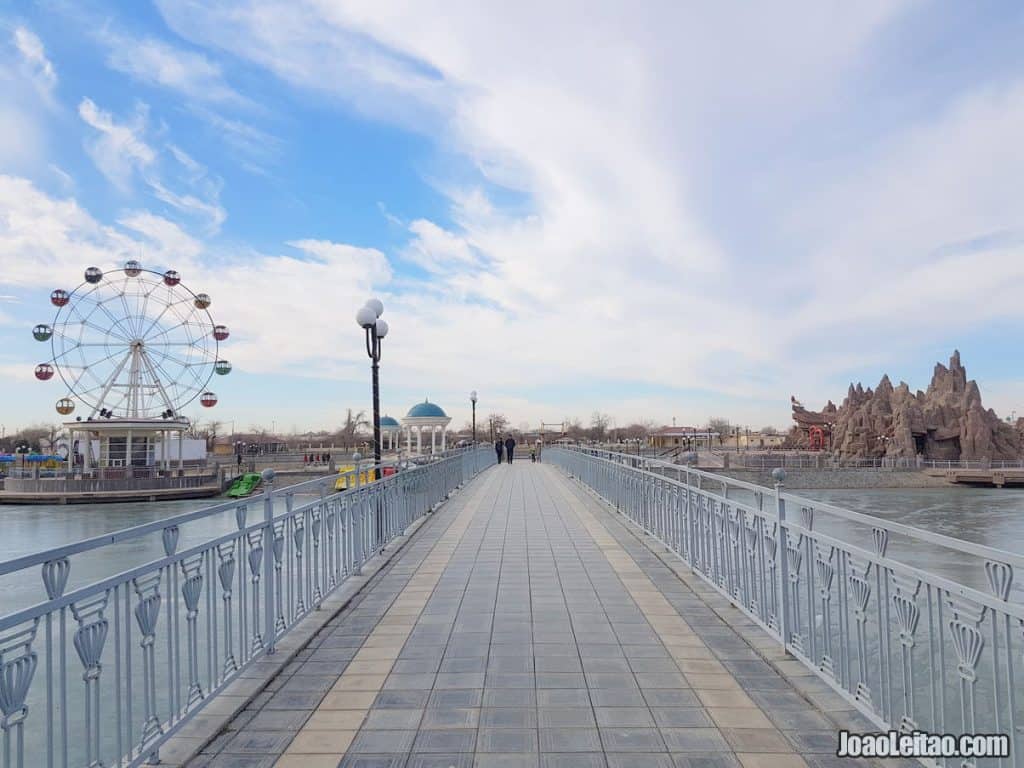
Urgench is not a particularly interesting city, but sometimes that’s what makes a place fascinating. Sure, it doesn’t have the historical and architectural must-sees of other cities in Uzbekistan, but why not spend the night here if you’re passing by, usually on your way to Khiva? It’s an opportunity to feel a city that’s off the tourist path.
Also, you might get stuck in Urgench on your way from Khiva to Nukus. So it’s always good to have some information about this city.
The city was founded in the 20th century by Russian migrants. It has 150,000 people and all the traits of a typical Soviet city: broad boulevards, concrete buildings, Soviet Realist architecture, and the vast public spaces, usually deserted.
NOTE: If you want to extend your stay in Uzbekistan to one month, take into consideration of making Urgench your hub in order to visit many of the fabulous Desert Castles of Ancient Khorezm.
How to get to Urgench
There’s a train leaving Bukhara every Tuesday, Wednesday, Friday, and Saturday at 3:40 am and arriving in Urgench at 11:00 am.
By road, buses and shared vans to Urgench depart from the North Station in Bukhara, near the Karvin Bazaar. A shared taxi will cost around 80,000 UZS, and the trip takes five hours. The buses that stop here on the way to Urgench are coming from Tashkent, with a fixed schedule.
If you decide not to include Urgench on your two-week itinerary, you can always give it a quick tour while coming from Khiva on your way to visit the desert castles north of Turkul.
What to See and Do in Urgench
Visit the market that despite not having the same atmosphere as the traditional bazaars, it’s still a modern facility interesting to explore and has a wide range of products to choose from.
Observe the statues scattered around the city. All of them are recent and were built to replace the classic icons of Lenin and other important Communist figures. On the main square, you’ll see a statue of Abu Mohammed Ibn Musa Al Khorezmi, a genius mathematician who was born in Khiva and lived most of his life in Bagdad.
Visit the monument in honor of the 20 members of the KOMSOMOL (Soviet Union’s communist youth organization) who died in 1922 during the Basmachi Revolution against Russian domination.
In the middle of the Lake Komsomol’skoye Ozero there is a nice garden and a theme park where local people go in the afternoon.
Where to sleep in Urgench
- The Navro’z is a 3-star hotel located near the center with free Wi-fi (Single Room with breakfast » 31 Euros), the Ariya hotel is located near the city center (Large Double Room with breakfast » 21 Euros), for some homestay experience try the Vodakanal Place (Budget Twin Room with breakfast » 12 Euros). You can also have a look into the Ulli Hovli built inside a fortress (Deluxe Twin Room with breakfast » 24 Euros)
Visit Khiva in 2 Days
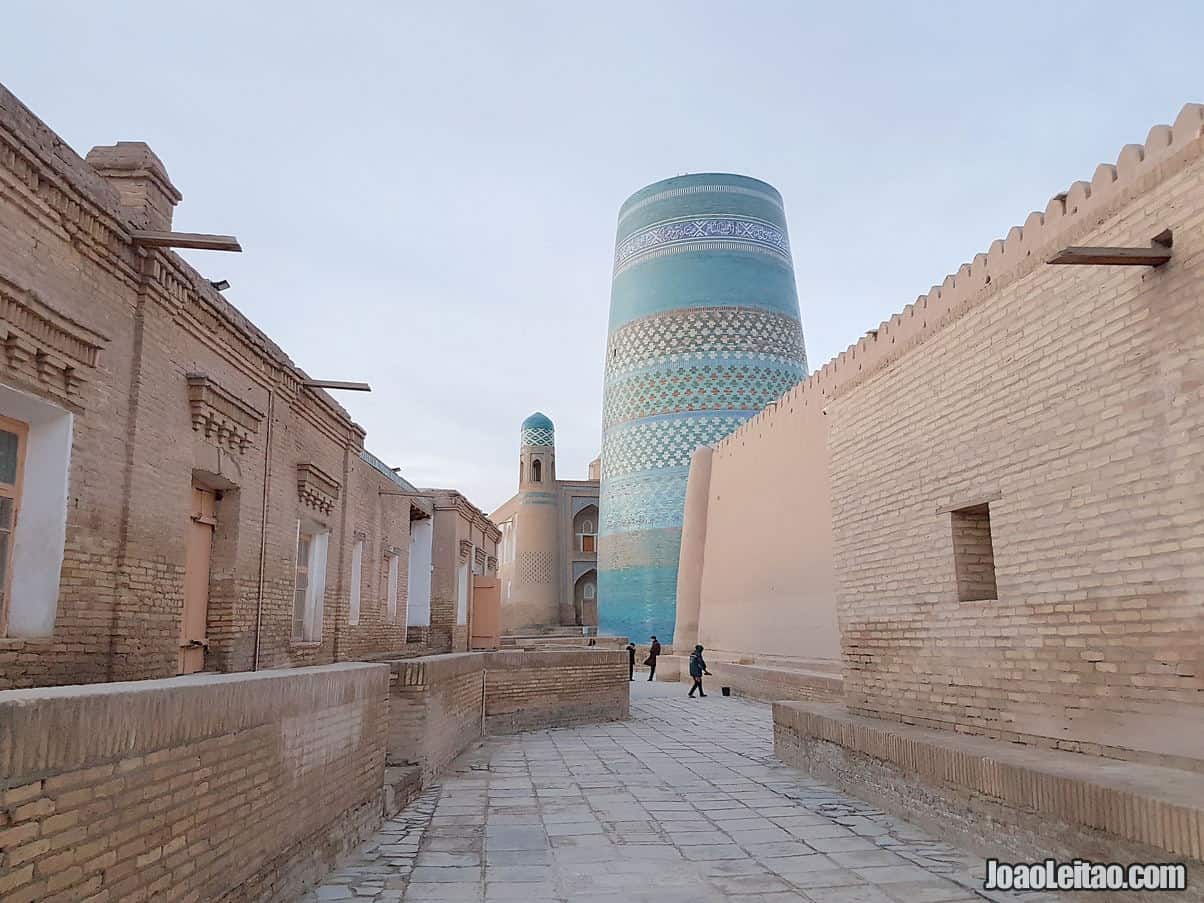
Khiva is one of the three classical cities of Uzbekistan, and despite seeming remote when you see it on a map, you must absolutely visit it no matter what.
Its historic center, protected by 10-meter tall walls and known as Itchan Kala, is a UNESCO World Heritage Site.
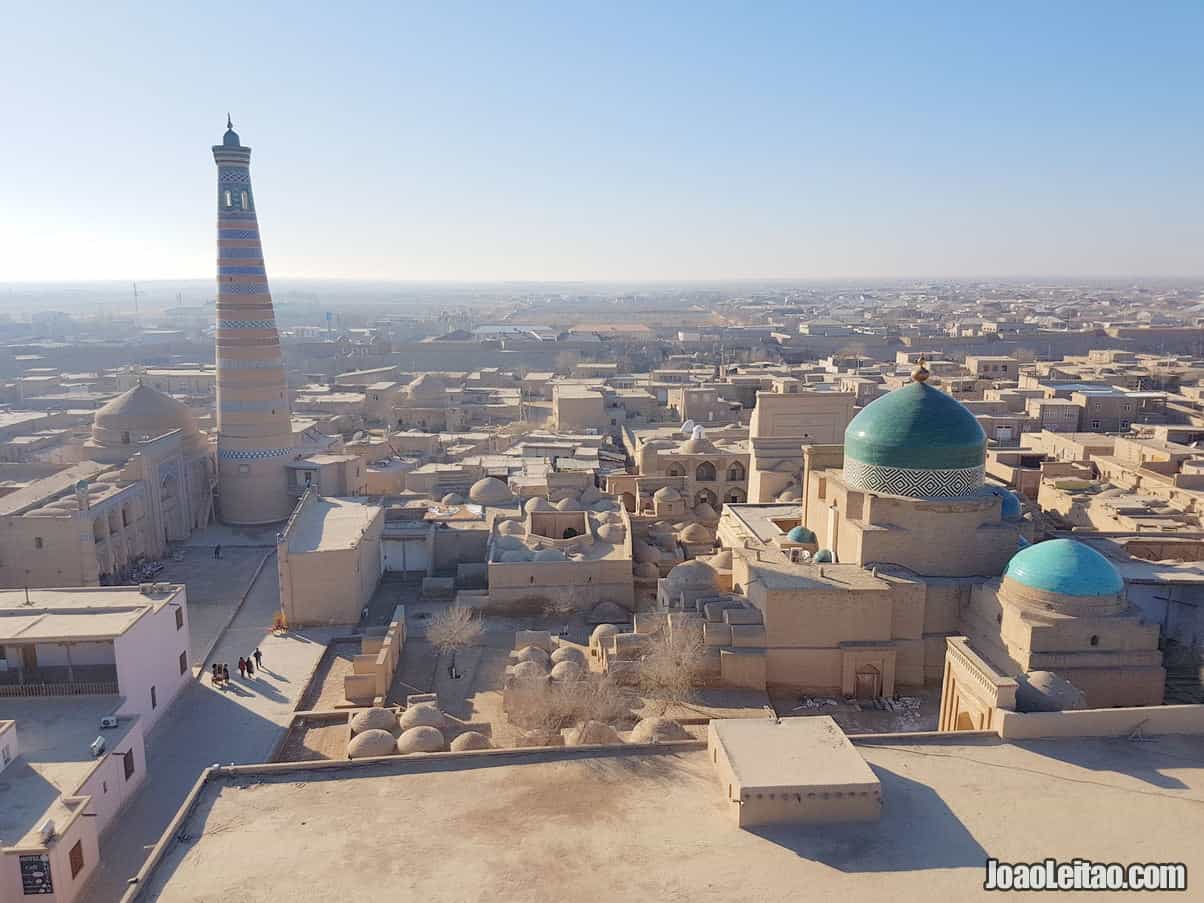
Khiva was an important city on the Silk Road because it was the final stop before the caravans had to endure the difficult task of crossing the Iranian desert. Khiva is one of my favorite cities in the world.
How to get to Khiva
Most likely, you will enter Khiva coming from Urgench, about 35 km away, where there is an airport and a train station used to travel from Samarkand, Tashkent, or Bukhara.
When in Urgench, go to the bazaar, near the Dynamo stadium, from where the shared taxis to Khiva depart. A trip will cost around 1,000 UZS, but the vehicles only start the journey once they’re full. When you reach Khiva, you’ll get off near the north gate of the old city.
Some travelers arrive to Khiva coming from Turkmenistan. If this is your case, Khiva will be your first city in Uzbekistan.
Things to do in Khiva
Map with the most famous Khiva tourist places.
- Historic center – Itchan Kala
- Madrasa Kutli Murad Inak
- Kalta Minaret
- Mausoleum of Uc Avlija
- Tash Chauli Palace
- Madrasa Khan Allakuli
- Caravanserai Tim
- Mohammed Rakhim Khan Square and Madrasa
- Kuhna Fortress
- Baths of Khan Anush Mohammed
- Juma Mosque
- Mausoleum Pahlawan Mahmud
- Minaret Islam Khoja
- Madrasa Shirgiz Khan
- Madrasa Muhammed Amin Khan
- Ak Mosque
- Bogbonli Mosque
- Seid Allaudin Mausoleum
Hot tips:
- At the west gate of the citadel, you can buy a group ticket for all must-visit places, valid for two days. It costs 51,000 UZS (around 5 euros), plus 15,000 UZS (about 1.50 euros) to use a camera.
- The attractions that need an additional ticket have a small ticket office at the entrance way.
- If you’re not interested in visiting inside any of the buildings, you can enter the city through any other gate.
Khiva sights & tourist attractions
Itchan Kala
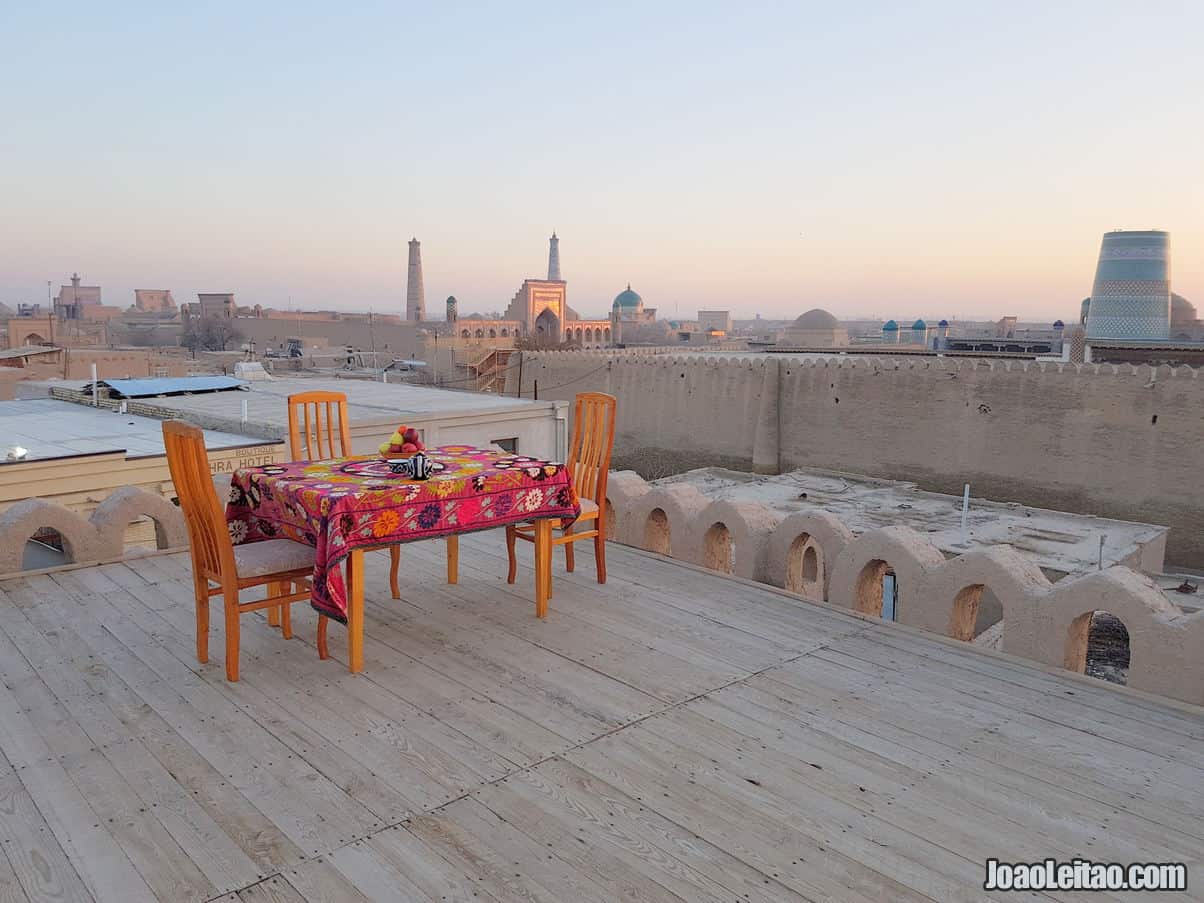
Itchan Kala, which literally means “inside the walls,” is the citadel of Khiva, the city’s historic center that’s a UNESCO World Heritage Site.
It has four gates, and the one in the west is the most popular and most used by tourists. In addition to the remarkable buildings inside, travelers can also wander the streets of Itchan Kala, observing the details and the daily routines of the local people.
The walls around the citadel are worthy of a closer look. Unfortunately, they’re no longer whole, but about 2 km of the walls are still intact. They’re about 6 to 8 meters tall with a 2-meter-deep base. The walls were destroyed and rebuilt several times, and they’re made of baked brick, with some fragments from the 5th century.
The north gate, also known as Urgench gate, and is used as a connection to the city’s transportation network. The east gate, near the caravanserai, is the best preserved of all four. Can you imagine all the things that happened here? Its structure used as a prison, the escaped slaves that were caught and nailed by their ears on the gate, the public executions. The south gate is more secluded and used mostly by locals. The west gate is the main one and the place where you buy the ticket to visit the citadel.
Tosh-Hovli Palace
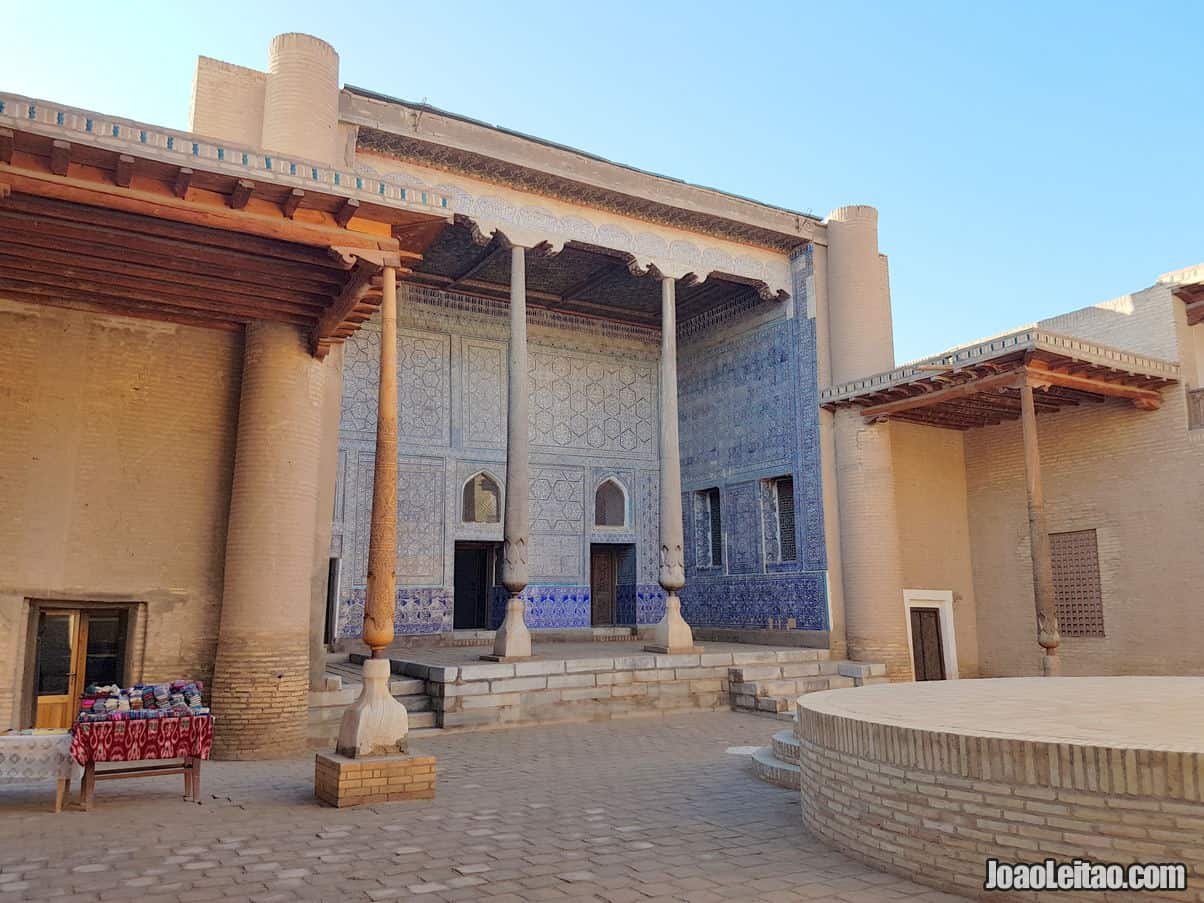
The name of this palace inside the citadel means “house of stone” and was built by Allah Kuli Khan between 1832 and 1841. He had the first architect executed because he failed the agreed deadlines.
The rectangularly shaped palace has over 150 rooms and nine interior courtyards. The north side, which was once the most secluded area of the complex used by the Allah Kuli Khan harem, is open to the public and has several souvenir stores.
The throne room and an intricate series of rooms on the south wing will keep visitors busy for a while.
The palace is exquisitely decorated with mosaic and the pillars holding up parts of the structure are made in carved wood.
At the beginning of the 20th century, the palace was in bad shape, and it only got worse in the following decades. The plans for restoring the palace began in 1975, and the complex went under renovation work from 1981 to 1996.
Kalta Minor Minaret
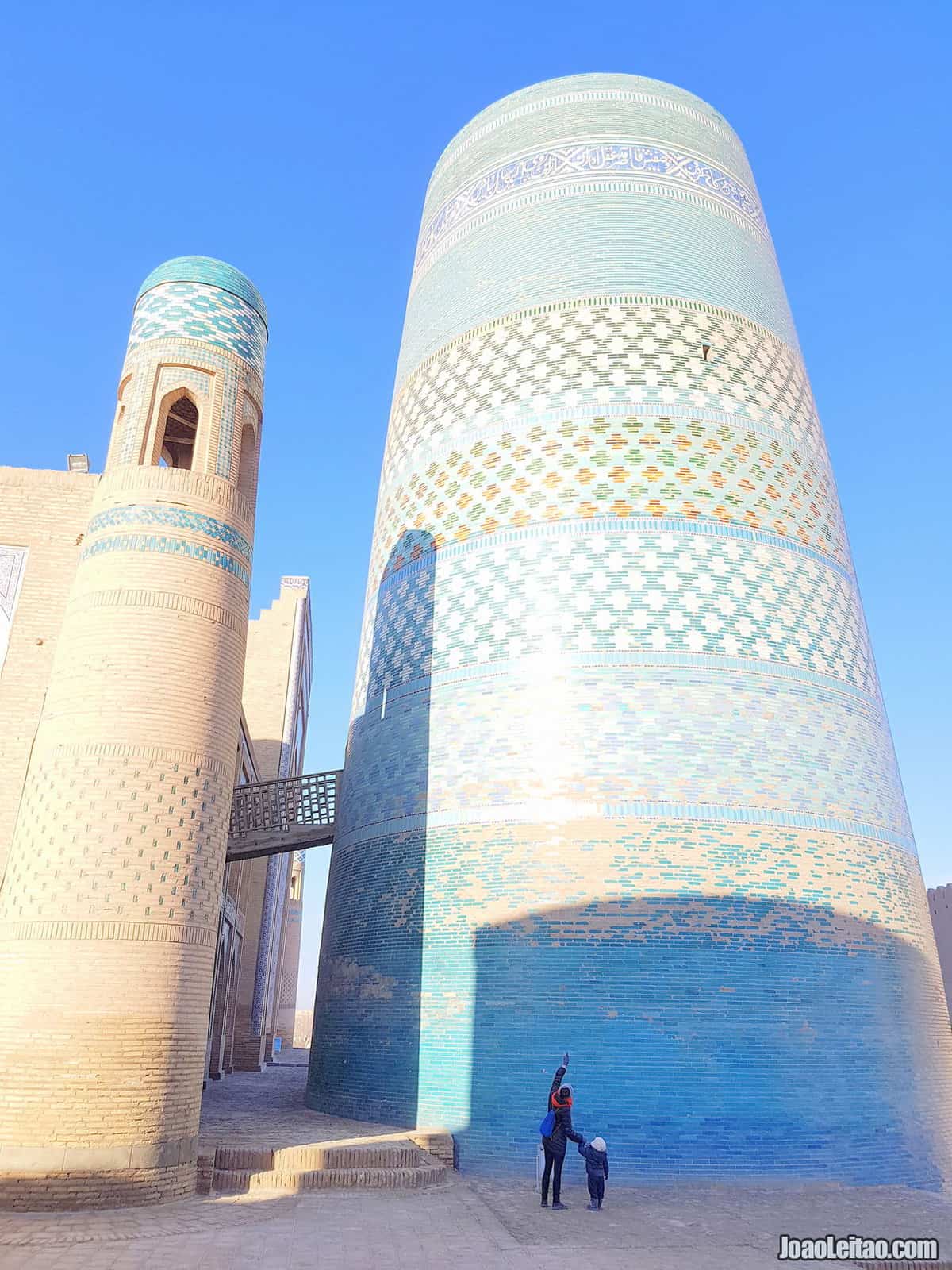
This exceptionally wide minaret, completely covered with mosaic, was built by Mohammed Amin Khan in 1851.
The ruler wanted a minaret so tall that he could see Bukhara from the top. Even if that was possible, he never saw his dream come true because he died four years after the construction began and the minaret was never finished.
Of the planned 90 meters high, only 29 meters were built. Nevertheless, it’s an impressive structure with foundations buried almost 15-meters deep in the ground.
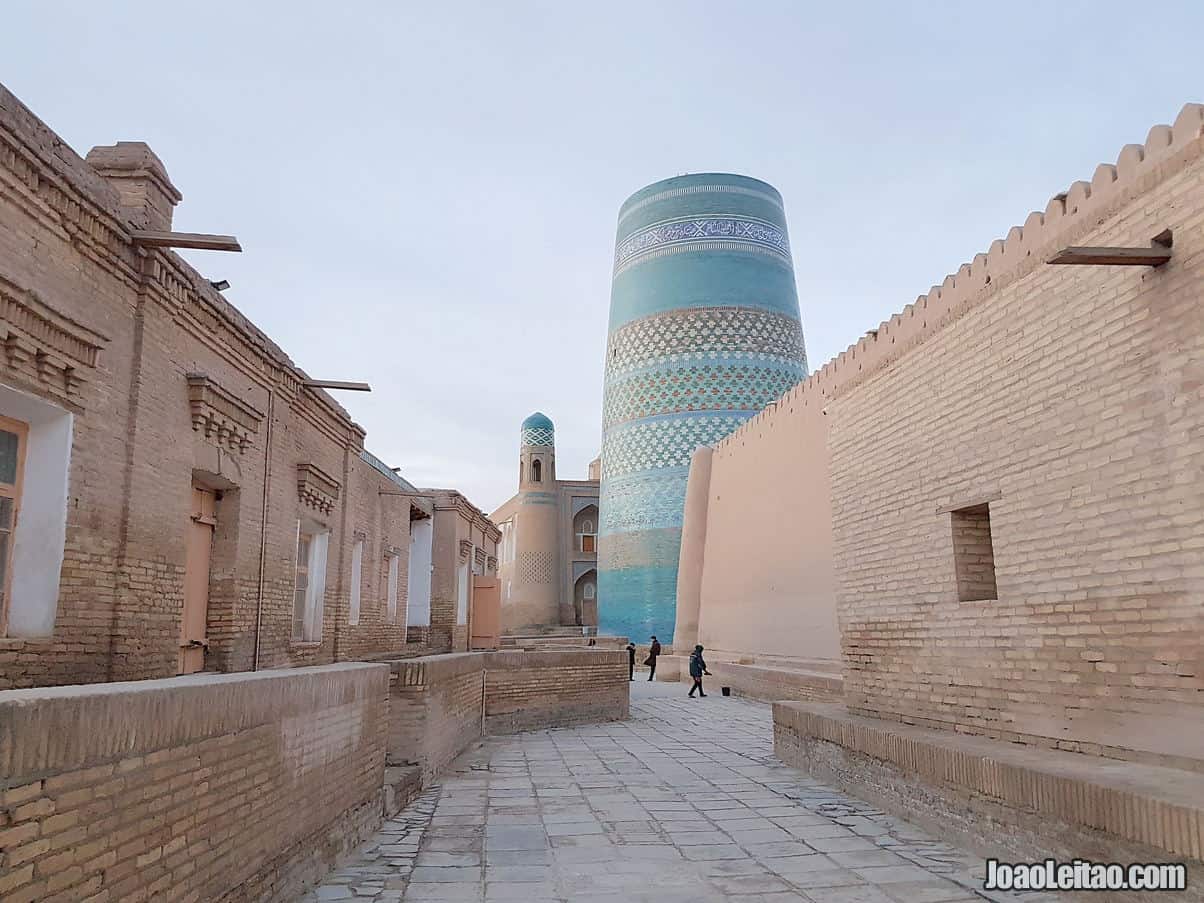
Legend has it that Mohammed Amin Khan heard that the ruler of Bukhara wanted to hire his architect to build a similar structure for him. But when Mohammed Amin Khan ordered his assassins to find him, he had already escaped Khiva, leaving the tower unfinished.
Kuhna Ark
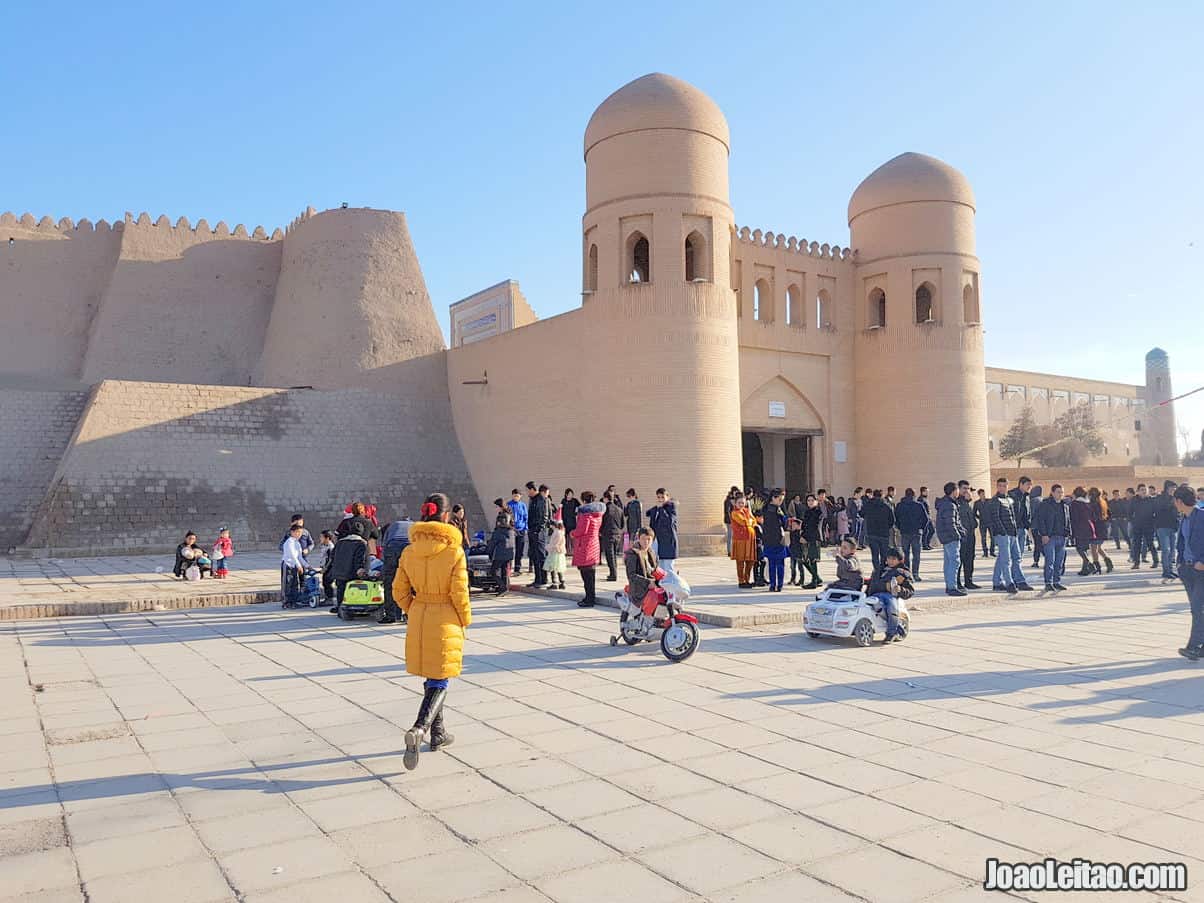
This palace was the headquarters of the government and the official residence of the king, initially built in the 12th century by Ok Shaykh Bobo and expanded in the 17th century. It’s inside the citadel of Khiva, a UNESCO World Heritage Site.
Must-visit sites in the palace include the old prison, right next to the entrance, which has a small exhibition of weapons, shackles, and torture tools. On the right side, you’ll see the richly ornamented Summer Mosque, that includes a display of archaeological findings.
At the old coinage workshop, there is a museum dedicated to all the currency produced on that location. The throne room is always a must-see, the place where the king judged the most serious cases.
You can pay a small extra fee to climb up a defense tower with fantastic views from the top.
Islom Hoja Madrasa and Museum of Applied Arts
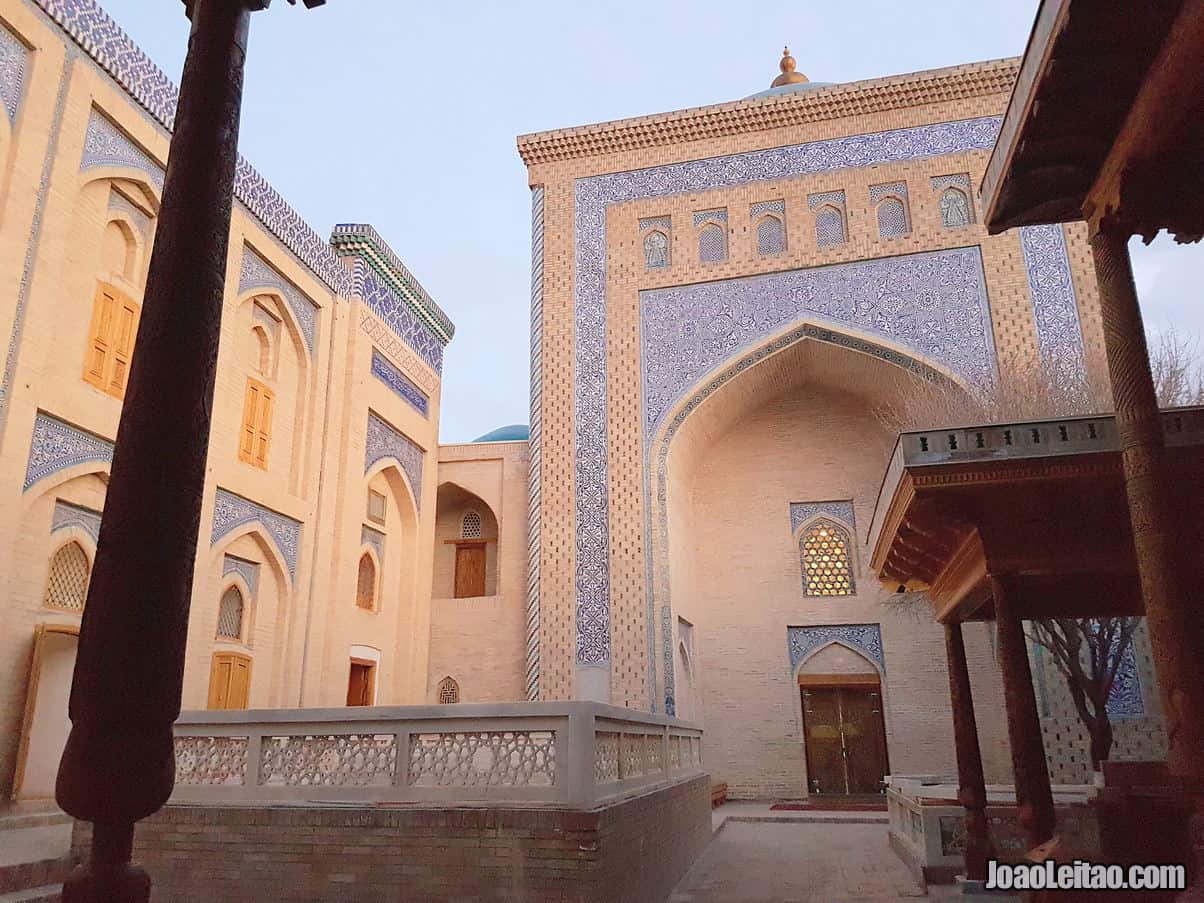
This madrasa is the most recent religious building in Khiva, built in 1910, and it currently houses the Museum of Applied Arts, perhaps the best museum in the city.
The museum includes a vast collection of carved wood objects, tapestries, engraved stone, and decorative mosaic panels.
There’s a minaret next to the madrasa, which may or may not be the framework for the Kalta Minor minaret, only taller. In fact, it’s 57 meters high, making it the tallest minaret of Uzbekistan.
The complex is open every day from 9:00 am to 6:00 pm.
Juma Mosque
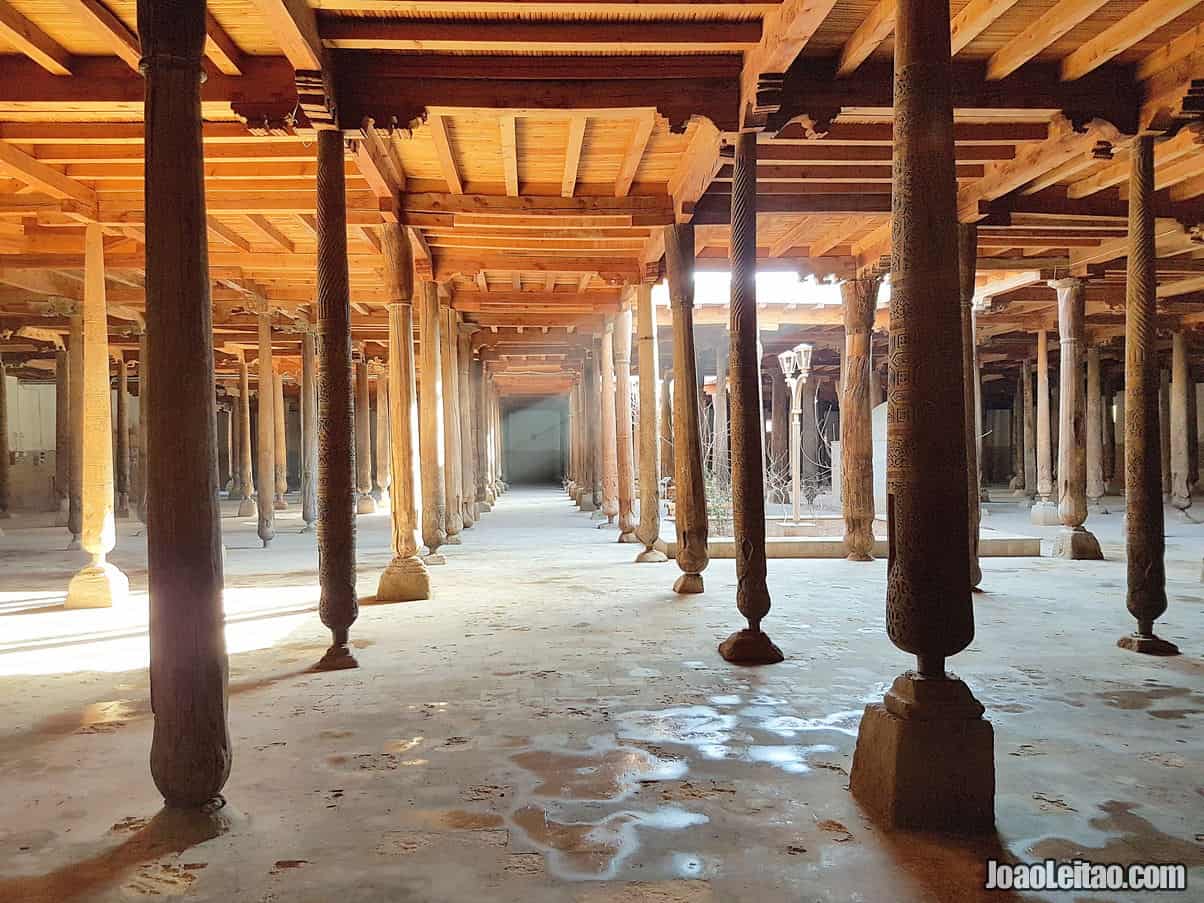
Juma Mosque, or Friday Mosque, is the main temple where the community gathers on Islam’s holy day. This Mosque is right in the center of the citadel of Khiva. It was built in the 18th century, on a place where there used to be the ruins of an older mosque, according to the travel chronicles of Mohammed al-Magisi, who was there in the 10th century.
It’s not a very ornate mosque, and the only feature that stands out is the carved woodwork of the 212 columns, from the 12th to the 15th century, that support the structure.
Where to sleep in Khiva
Khiva where to sleep in has a wide variety of places to sleep within all possible price ranges.
- For those trying to get a youth hostel, try the Hostel Laliopa (Bed in 5-Bed Dormitory Room with breakfast » 11 Euros).
- If you’re looking for mid-budget accommodation, try the Art House Hotel ( Standard Double or Twin Room with breakfast » 26 Euros), the Hotel Khurjin (Budget Single Room with breakfast » 22 Euros), or the family run Meros B&B Khiva where I spend New Years Eve (Double Room with breakfast » 27 Euros).
- If your budget is a bit higher try the Arkanchi Hotel with an amazing terrace view (Standard Single Room with breakfast » 39 Euros), the Shaherezada Boutique Hotel (Single Room with Bathroom with breakfast » 36 Euros), or the incredible Orient Star Khiva Hotel (Single Room with breakfast » 73 Euros). During the summer months, if you want a hotel with swimming pool try the Hotel Asia Khiva (Standard Double Room with breakfast » 71 Euros)
Visit Nukus + Aral Sea in 3 Days
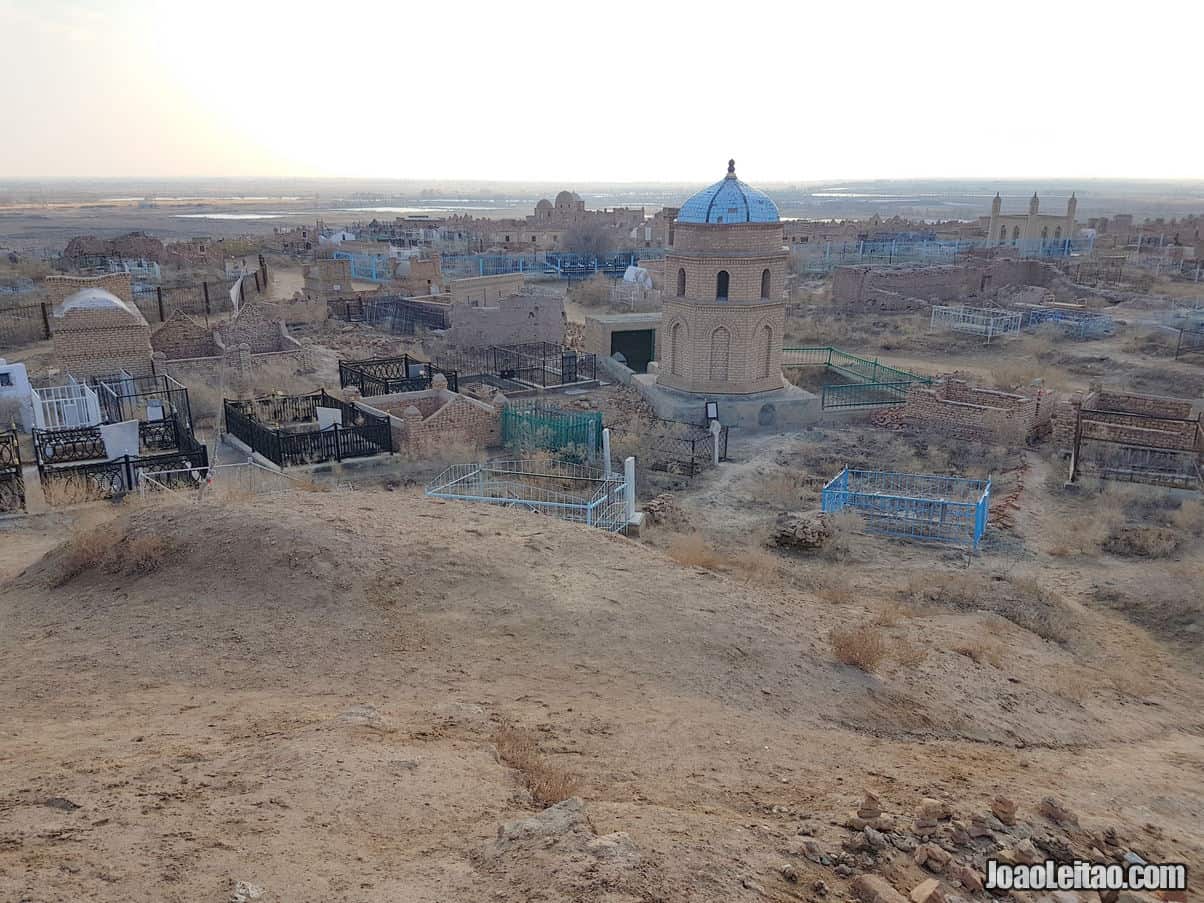
Nukus is on the west of Uzbekistan, near the border with Turkmenistan, in a remote location and scarcely populated. It was founded in 1860 and named after the ancient names of the Uzbeks, whose tribal name was Nukus. It was no more than a village up until 1932, but in the 1950s it grew to become a typical considerable sized Soviet city.
Just as Urgench it stands out because it has nothing that stands out. It doesn’t get as much attention as the other historical cities of the Silk Road, but in some way, this is where you’ll see the authentic urban Uzbekistan. At the same time, it’s an open-air museum, not of the magnanimous era of the caravans and the Khans, but the Soviet era.
However, the main reason to come here is how close the Aral Sea is from Nukus. If you’re not planning to visit the desolate desert that this body of water became, you might want to end your trip to Uzbekistan in Khiva and go to your next destination from there.
Also read my page:
13 of the Best Places to Visit in Karakalpakstan, Northern Uzbekistan
How to get to Nukus
From Khiva, you’ll always have to return to Urgench, retracing the same exact itinerary. Once there, look for a shared taxi to Nukus. The trip takes about two hours and costs around 30,000 UZS.
Things to do in Nukus
Map with the most famous Nukus tourist places.
Nukus sights & tourist attractions
State Museum of Karakalpakstan
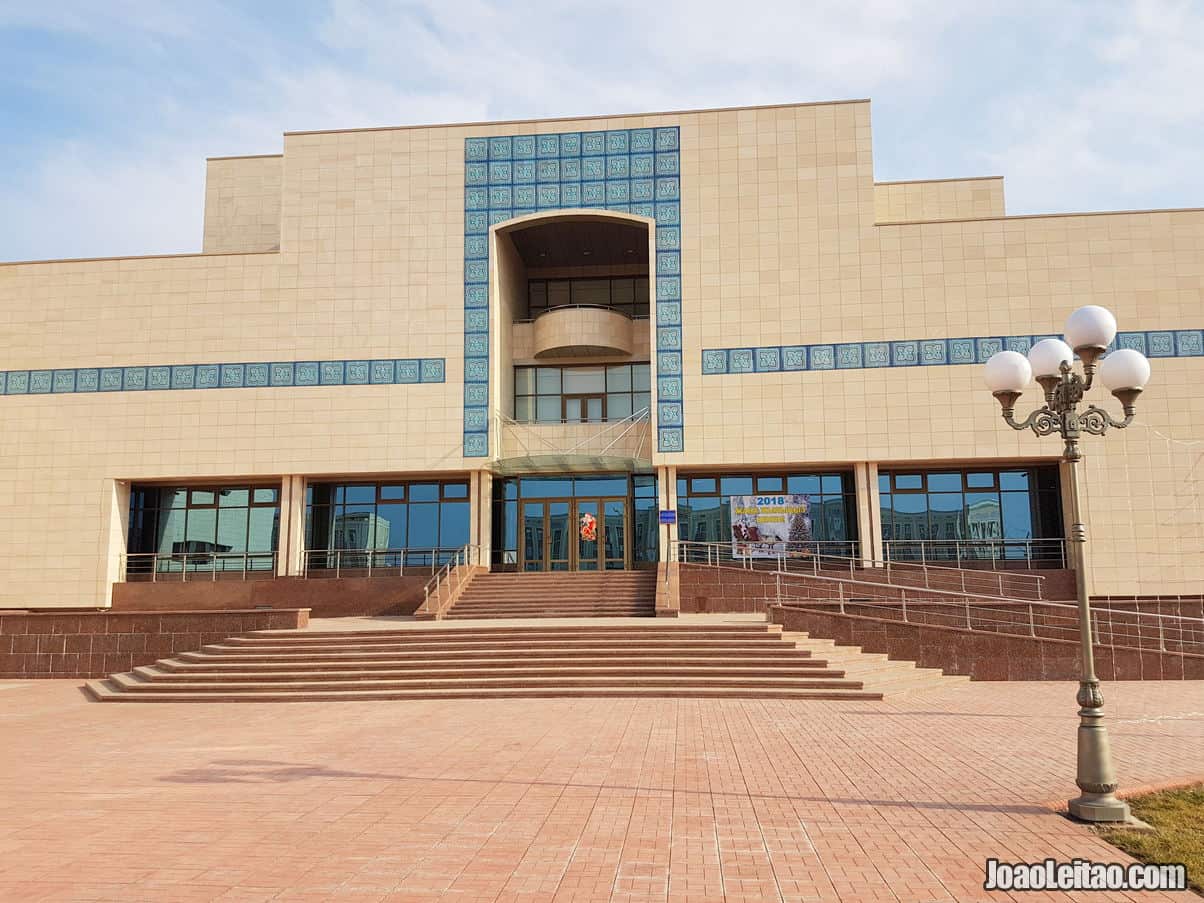
Surprisingly, one of the best Soviet art collections in the world is in Nukus, at the State Art Museum, also known as Museum I.V. Savitsky. This artist, who was appointed as the museum director in 1966, secretly collected art pieces that were forbidden by the regime, particularly the works of avant-garde artists.
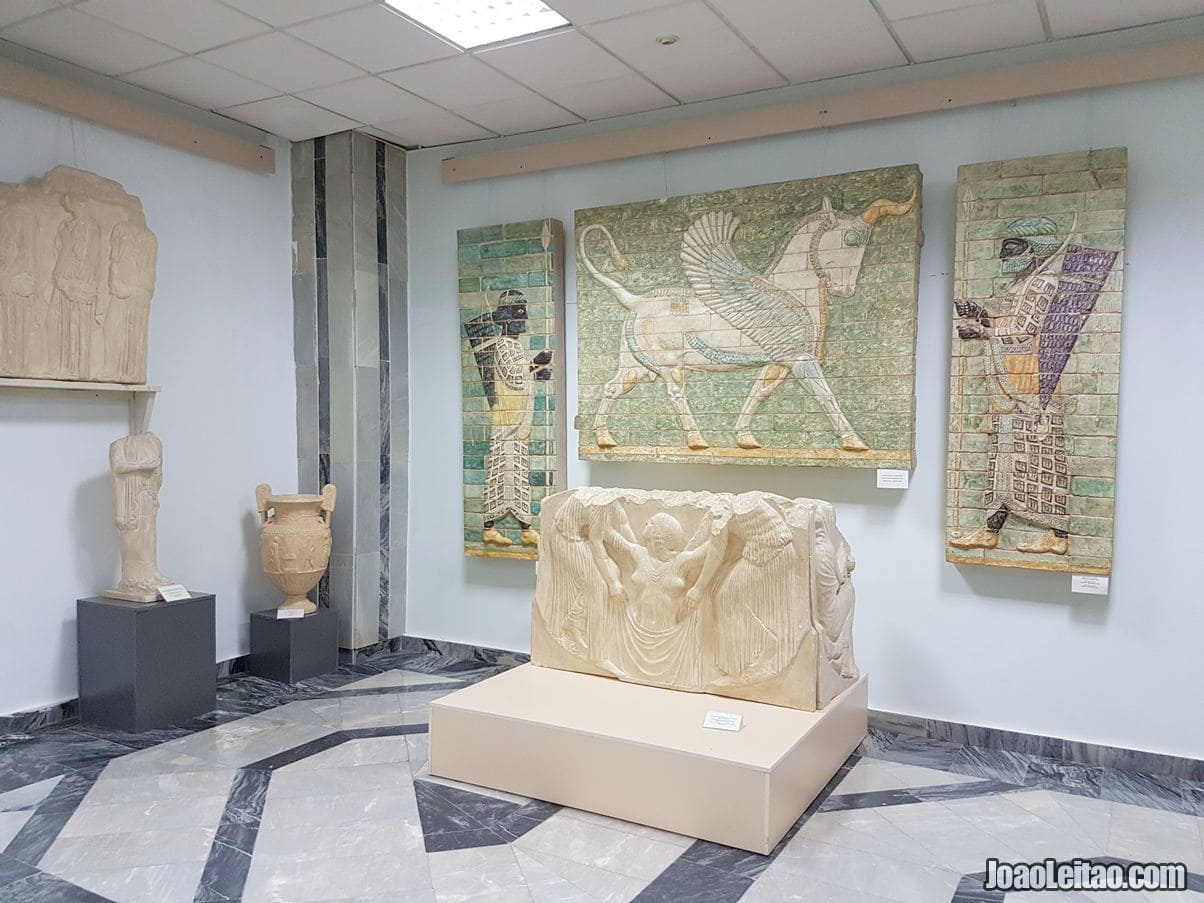
Growing this collection was probably only possible because of the remoteness of Nukus, away from the peering eyes of the Soviet authorities.
Nowadays the museum has a collection of about 90,000 pieces, and you can visit every day, except on Mondays.
Mizdakhan
Mizdakhan, an ancient city now in ruins, is 20 km west of Nukus. It was founded around the 4th century BC and was once the second largest city in the region.
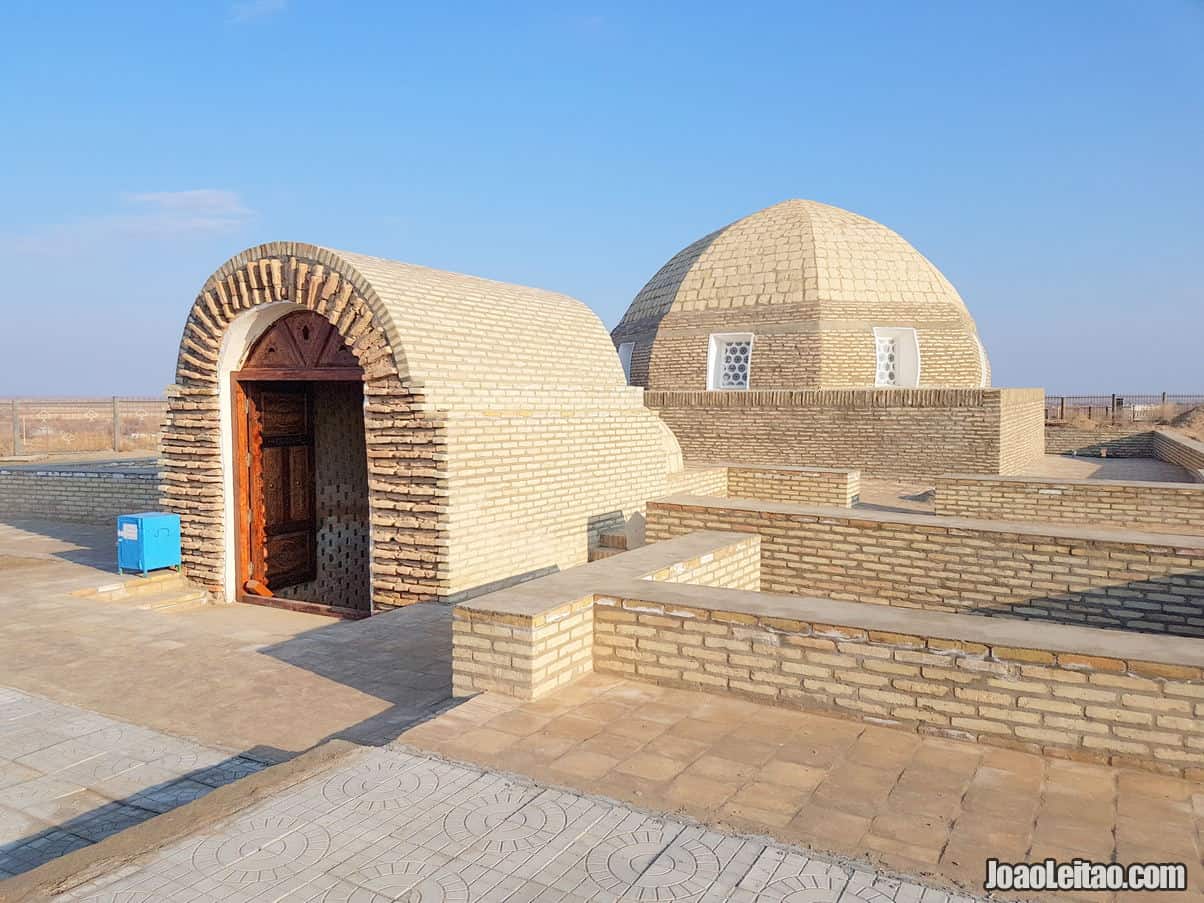
Timur destroyed it, but even after that, it remained a holy place, which is why you’ll find several tombs and mausoleums there, including the one of Mazlum Khan Slu, built underground and completely restored.
A taxi hired in Nukus should cost about 50,000 UZS, round trip, which includes the waiting time while you visit the site.
Gyaur-Qala
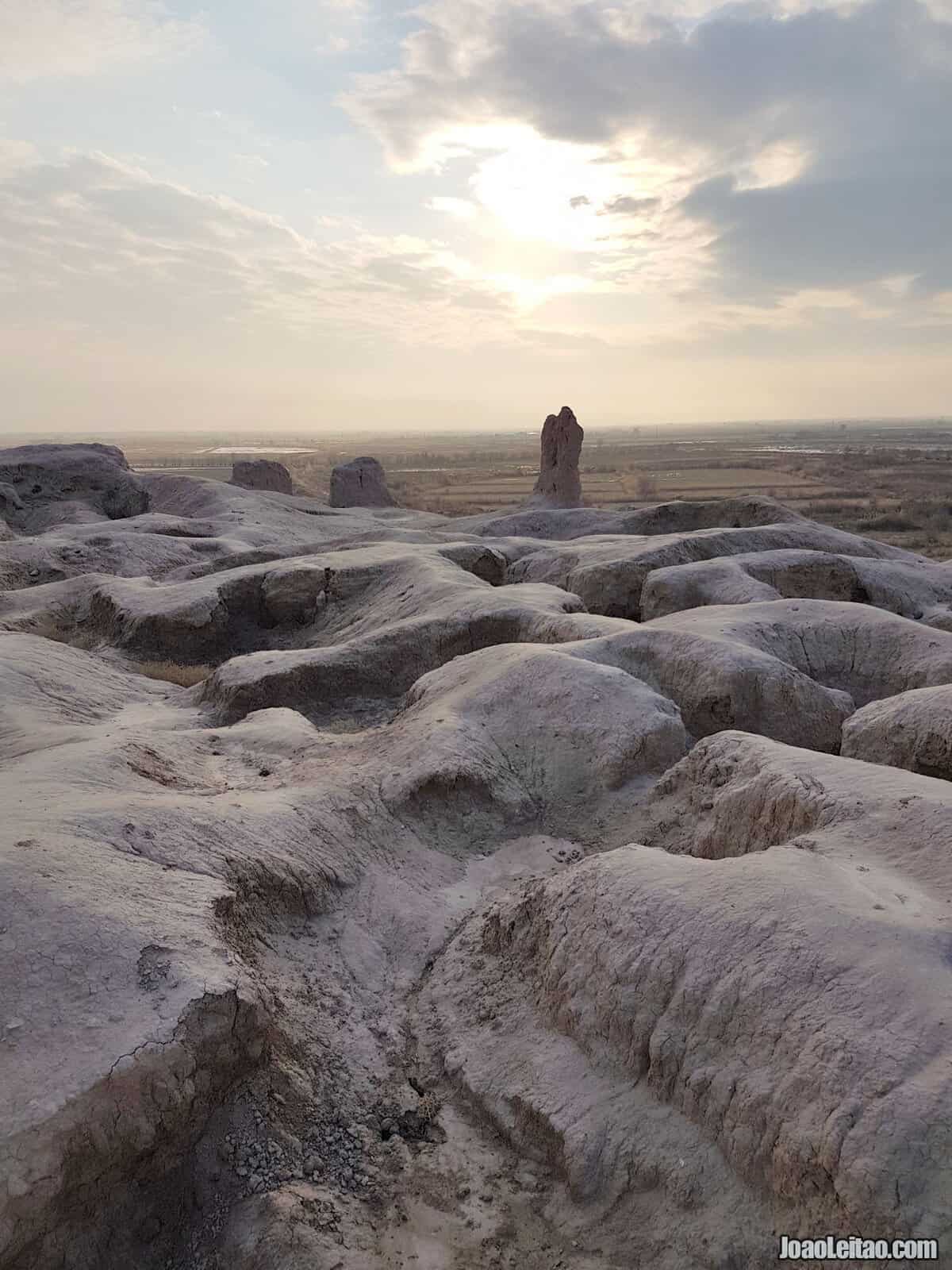
Nearby, at the next hill in the direction of Turkmenistan, there are traces of an old 3rd century BC fortress called Gyaur-Qala.
Market
The must-visit market of Nukus is near the bus station. It’s mostly covered, and you’ll find the usual products you can buy at any of the bazaars in Central Asia. It’s a great place to take photos and people usually allow you to take their picture, as long as you ask them for permission of course.
Out of the City: the Aral Sea
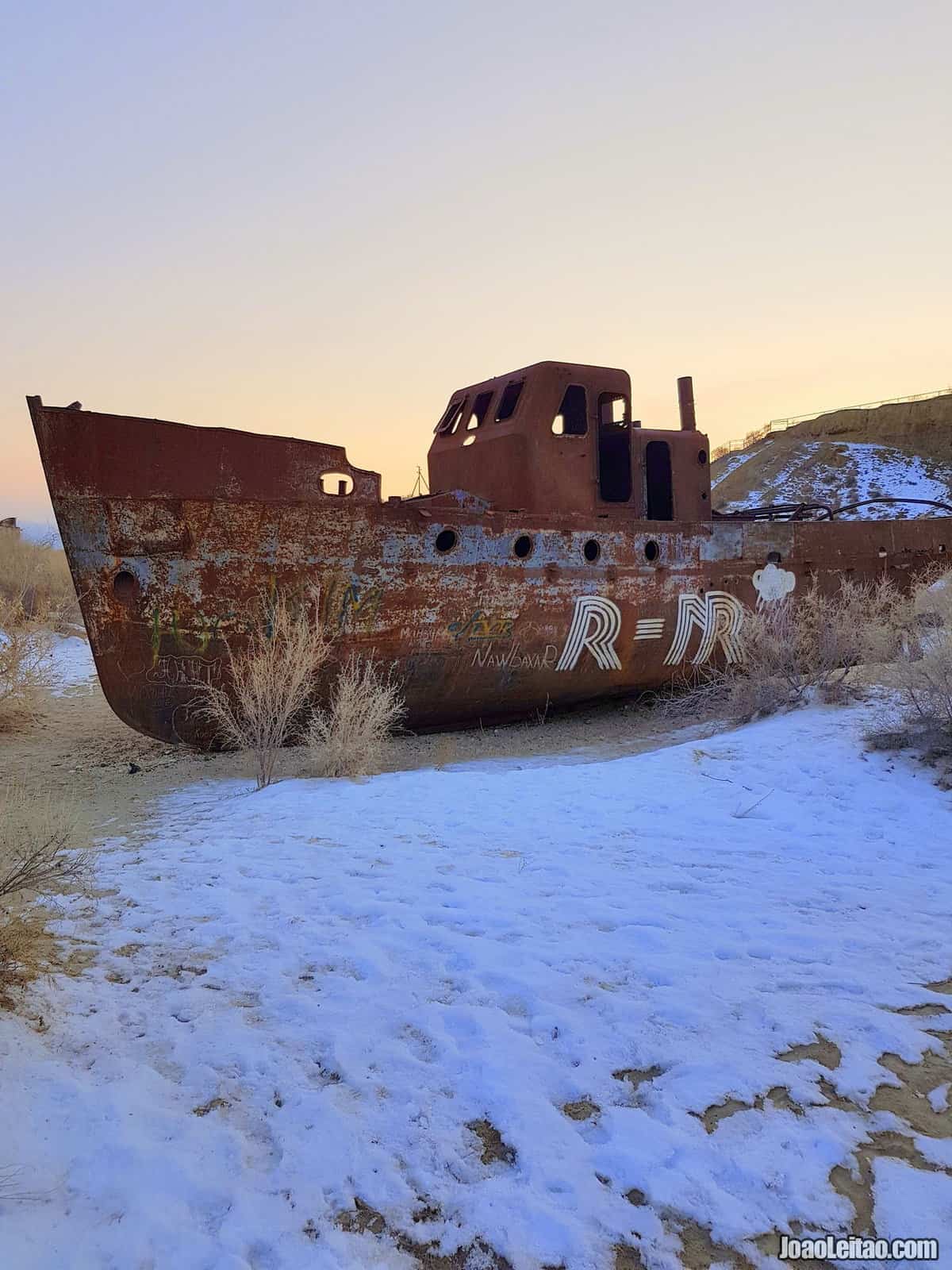
Perhaps visiting the Aral Sea, or what’s left of it, is the main reason why people travel to Nukus. Although it’s possible, it’s not recommended that you visit on a one-day trip, considering it’s 200 km each way.
Nukus is, however, the closest city to the Aral Sea and from there you can travel to Moynaq, an ancient fishing village that’s been dried out and is not distant from the little water that sea has left.
Although I recommend you spend the night in Moynaq, look for information locally since you’ll have fewer accommodation options and the opportunities seem to come and go very fast.
What happened to the Aral Sea
In the early 1960s, Soviet authorities made the drastic decision of diverting the rivers flowing into the Aral Sea and reroute them to the desert to water the future plantations there. They intended to grow cotton, one of the main plans of the people responsible for agriculture in the USSR. It worked for some time, and at the time Uzbekistan became independent, the country was the biggest cotton producer in the world.
But before the rivers were rerouted, the water of the Aral Sea was already being used for irrigation. The large-scale construction of canals had begun 20 years earlier. However, the poor management of this system meant a large part of the water was lost.
In the 1960s the water level dropped 20 cm on average every year. In the next decade, it decreased by 60 cm a year. By 2004, the sea covered only 25% of its original size and currently what’s left of the Aral Sea, reduces 1 meter per year.
From Nukus to Moynaq
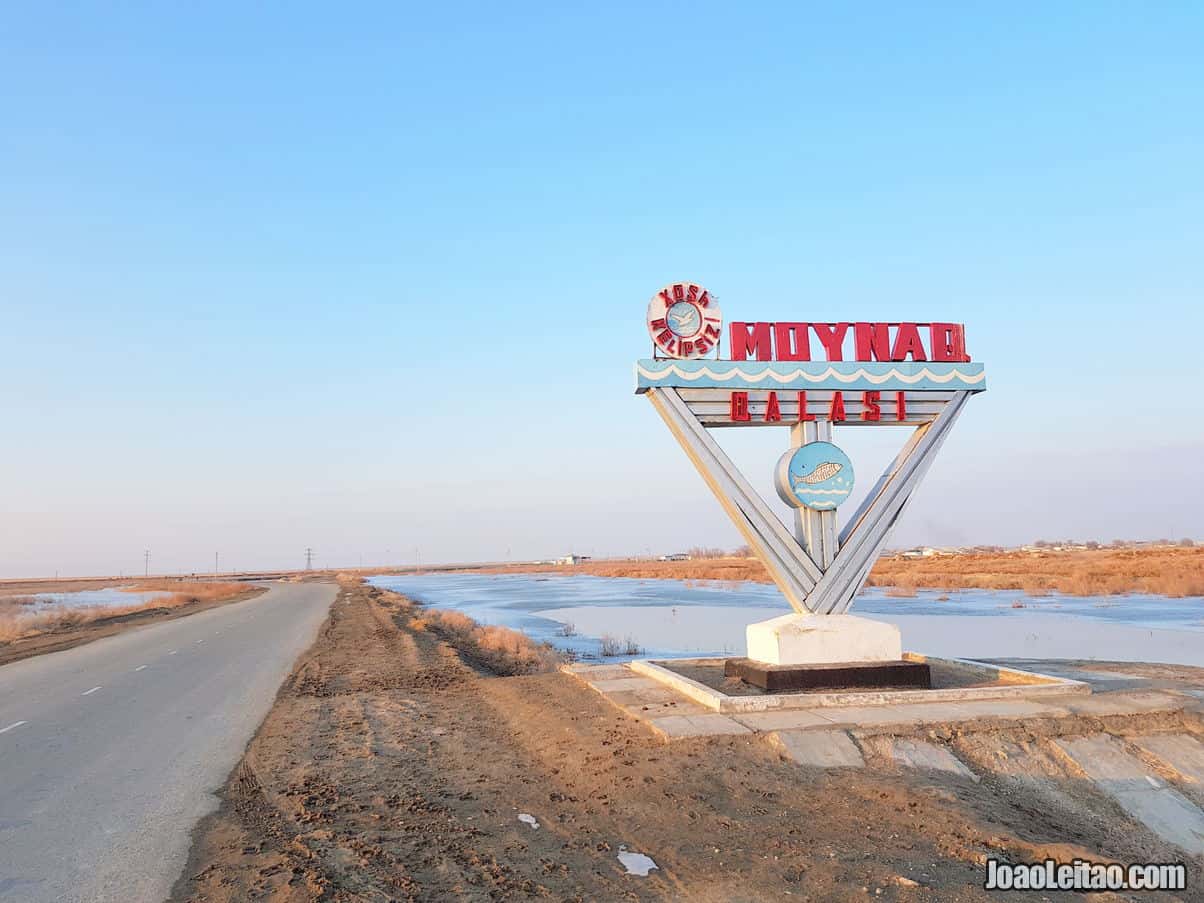
Marshrutkas: there are three or four regular departures every morning from Nukus. The vehicles leave the market when they’re full. Go as early as possible not to risk being left behind. The ticket costs about 10,000 UZS, and the trip takes three hours.
Taxis: taxi fares vary a lot because they depend on your ability to negotiate a lower rate. You might be able to pay 200,000 UZS for a round-trip if you don’t mind sharing the car. For a private taxi, prices may vary between USD 45 and USD 100 for a round-trip.
Tours: some of the hotels in Nukus and travel agencies in the city sell tours to the Aral Sea, that include transportation and visiting some of the points of interest in the city. It will cost about USD 150, and it will be exhausting, but at least you’ll be able to relax and not worry about every single detail of your trip.
Moynaq
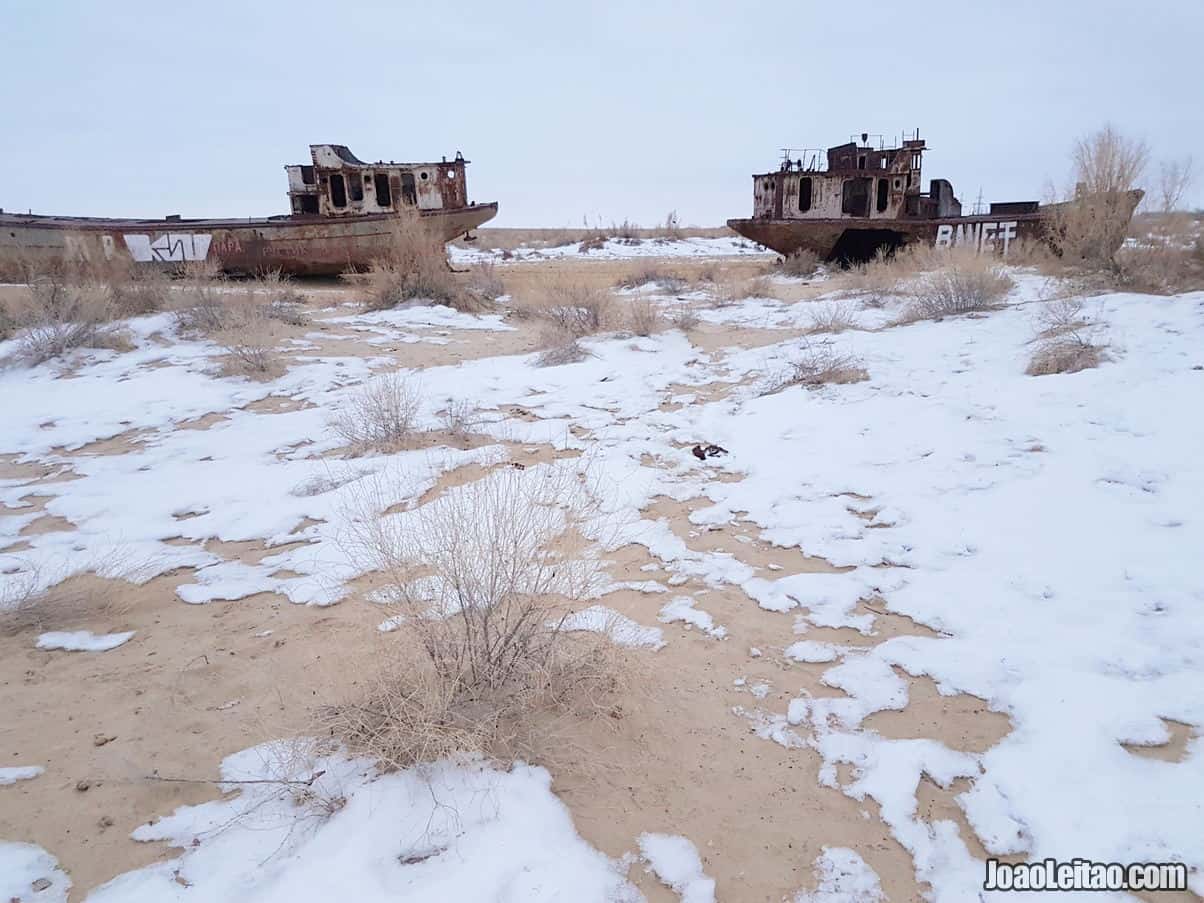
Moynaq used to be on the shore of the Aral Sea. Nowadays it’s 100 km away and its people, who were once part of a stable fishing community, struggle to find a future for themselves. Many have left considering their city was basically dying. Some managed to adjust and somehow make a living off the few tourists who come this far.
Here you can visit the cemetery of abandoned ships. There are fewer boats now, but it’s still a haunting sight. You can visit one of these ships, a fishing boat, preserved near the bus station.
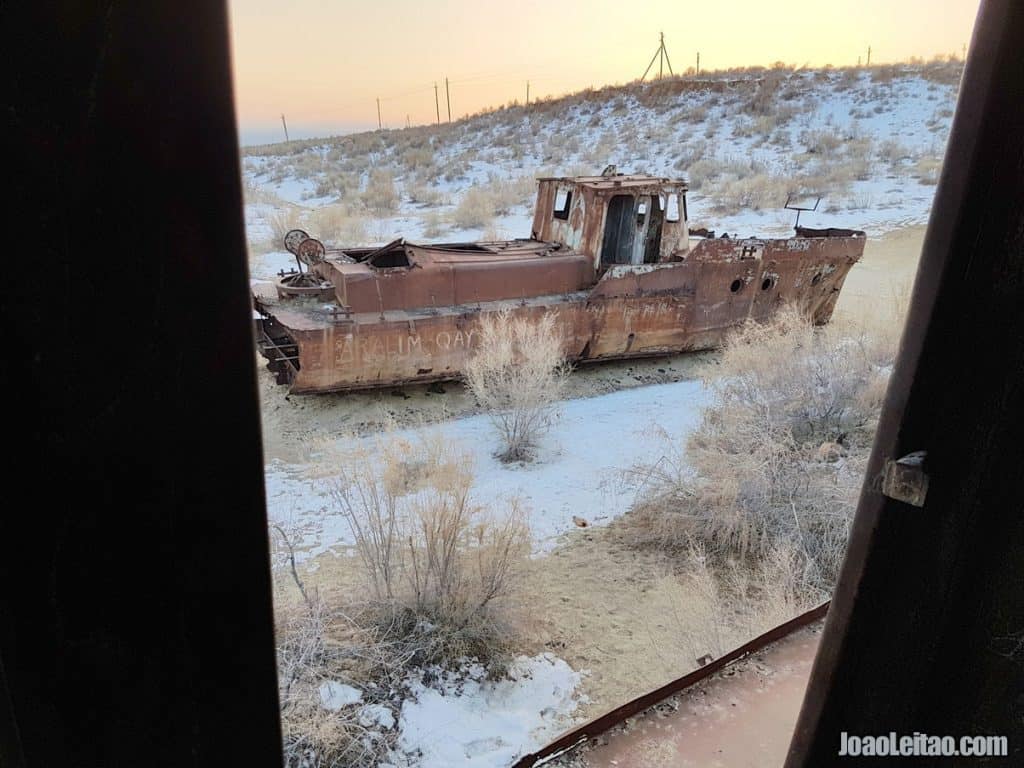
If you enjoy abandoned places, plan to explore what’s left of the canning factory that once employed a large part of the people of Moynaq.
The Moynaq Regional Studies Museum is a must-visit place too, to see the exhibition about the dramatic death of the Aral Sea, with pieces depicting the recent past of when people lived off fishing and the canning history. A collection of photos tells the tale, from the beginning of the 1950s until the 1980s.
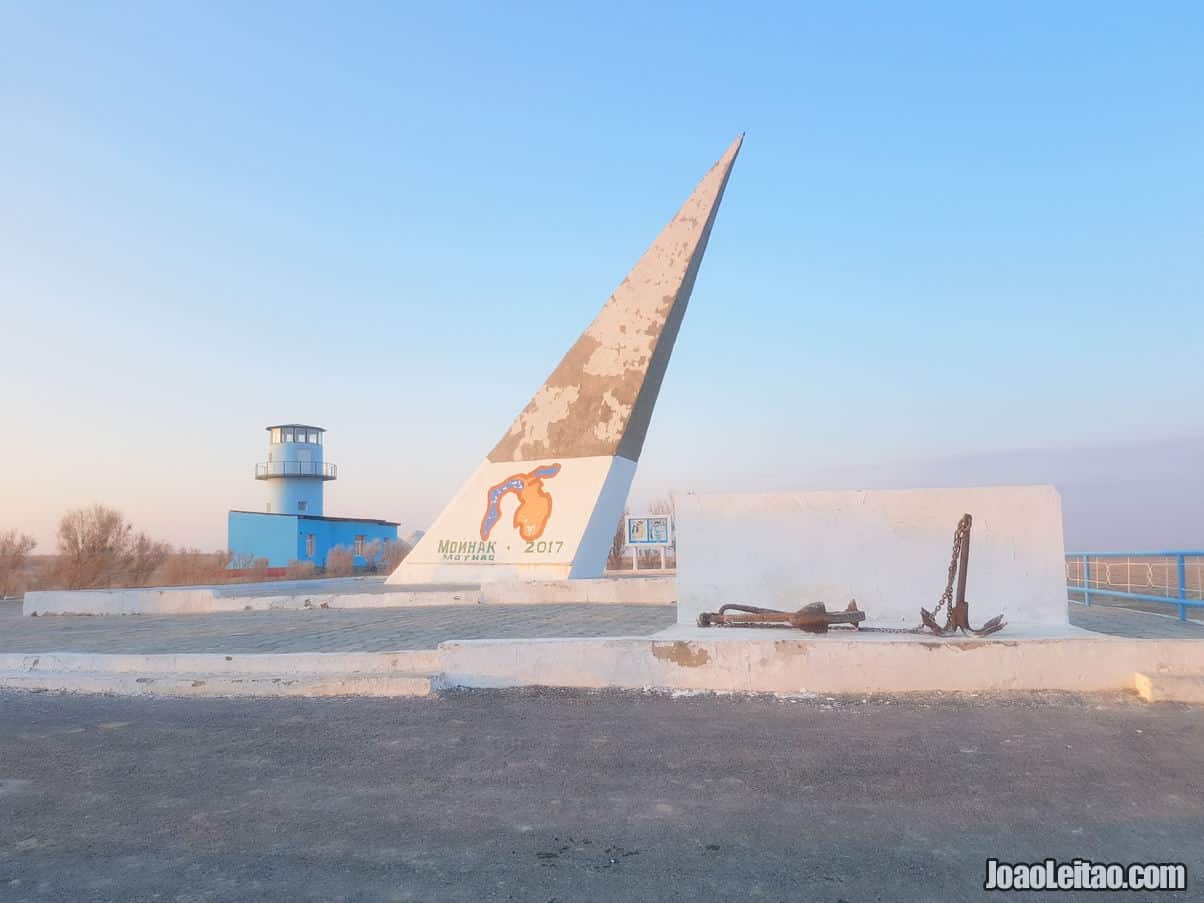
You can also visit the picturesque Monument to the Aral Sea, by the old shore, which has an interpretation panel explaining how and why the waters vanished.
Ending the Trip in Uzbekistan
- From Nukus, you can travel back to Tashkent (about 1000 km distance). Uzbekistan Airways flies twice every day between Nukus and the capital city.
- If you prefer, you can take one of the two weekly trains from here to Tashkent via Samarkand. You’ll be traveling at night for part of the trip since the train leaves at 3:29 pm and arrives in Tashkent the next day at 9:27 am. The ticket for a bed on this train costs 115,000 UZS.
- If you got a visa to Turkmenistan and are going to visit that country next, taxis to the border cost about USD 20 and take two to three hours to get there.
- If you are going to Kazakhstan, you can get transportation from Nukus to the border or even all the way to Beyneu.
- Also, there is one weekly train from Nukus to Beyneu, going from Tashkent to St. Petersburg in Russia. It departs Tashkent on Sunday night, passing Nukus on Monday evening. The train gets to Beineu Tuesday morning and finally arrives to its final destination, St. Petersburg on Friday morning.
Also read my pages:
20 of the Best Places to Visit in Uzbekistan
13 of the Best Places to Visit in Karakalpakstan, Northern Uzbekistan

